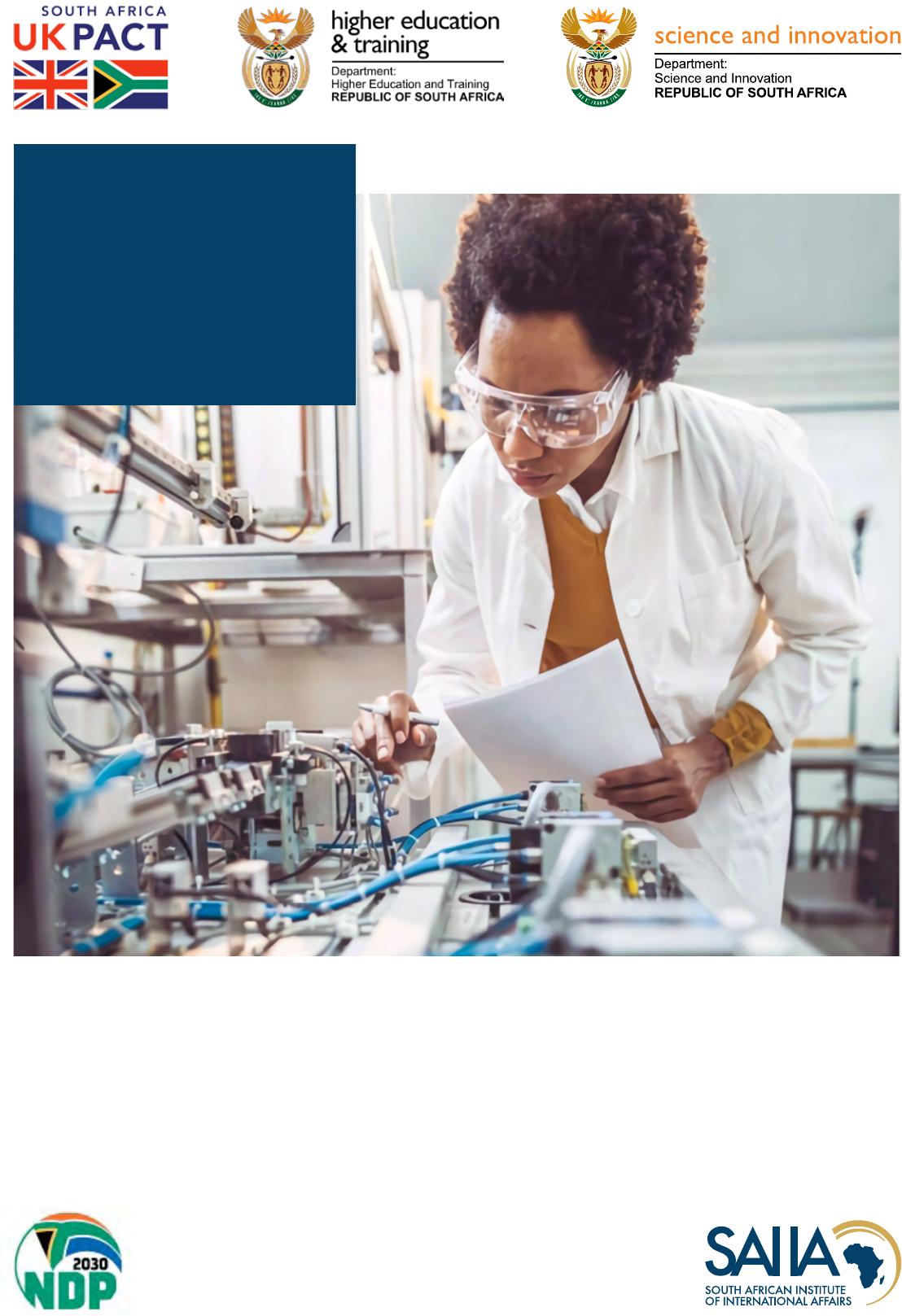TheSouthAfricanGreenHydrogenTVETEcosystemJustTransitionStrategicFrameworkSynthesisReportDecember20222THESOUTHAFRICANGREENHYDROGENTVETECOSYSTEMJUSTTRANSITIONSTRATEGICFRAMEWORKForewordThelaunchoftheSouthAfricanGreenHydrogenTVETEcosystemJustTransitionStrategicFrameworkoccursamidfivemajorchallenges:∙∙Thegeopoliticalenergyturmoilinthefaceofclimatechange;∙∙theaftermathoftheCOVID-19pandemicanditsimpactontheeconomyandTVETecosystem;∙∙thefast-pacedgreenenergyscientificandtechnologicaldevelopments;∙∙thehighlevelsofunemploymentinthecountryandamongTVETgraduates;and∙∙thelowlevelsofTVETgraduatelabourabsorptionbyindustry.TheroleoftheTechnicalVocationalEducationandTraining(TVET)ecosystemasasocio-economictransformativetoolisperhapsmoreimportantthanevertoaddressingcurrentchallengesatthishistoricaljuncture.Thegreataccelerationinscience,technologyandinnovation(STI)haslefteducationalsystemsreelingandinascrambletocatchuptorapidlychanginganduncertainlearningenvironments.STIisapowerfuldriverofchangeintheimplementationoftheEconomicReconstructionandRecoveryPlan(ERRP)anditisexpectedtosetthepaceforbuildingasustainable,resilientandinclusiveeconomythroughseveralpriorityinterventions.Forinstance,transitioningtoajustandinclusivegreenhydrogenTVETecosystemthatcultivatesatransversalskills-commonsandfosterseconomicwellbeingandecologicalresiliencewillrequireanenablingenvironment,collaboration,investment,andinnovationtoaddressthefivemajorglobalshiftsandlocalchallenges.InFebruary2022,whenIlaunchedtheHydrogenSocietyRoadmap,thefirstproactivestepsweretakentoleveragethehydrogenopportunity.Transitioningthecountry’sTVETecosystemandaligningitwiththehydrogenindustry'sneedsandopportunitiestoimprovelabourabsorption,iscriticaltoaddressingtheskillsdevelopmentneedsoftheoverwhelmingmajorityofourpeople,especiallythepreviouslydisadvantaged,women,youthandthepoor,bothurbanandrural.Asectoralalignmentwithindustry-specificrequirementswillfacilitateajusttransition,wherepotentialjoblossesinthetraditionalcoal-miningindustry,forexample,aremitigatedthroughupskilling,retrainingandonboardingofworkersintogreenhydrogen-relatedmining,manufacturing,powerfuelproduction,andtransportationindustries.3THESOUTHAFRICANGREENHYDROGENTVETECOSYSTEMJUSTTRANSITIONSTRATEGICFRAMEWORKTheSouthAfricanGreenHydrogenTVETEcosystemJustTransitionStrategicFrameworkisoneofthegovernment’skeyenablerstothesuccessfulimplementationoftheERRPandprovidesthefoundationforthinkingaboutanticipatorypolicyinterventionstoreconstructandtransformtheTVETskillsdevelopmentecosystem.TheTVETecosystemhasthepotentialtotrainlargenumbersofgreenartisansandtechnicianswhilebecomingresponsivetomajorpolitical,economic,environmental,andsocio-technicalshiftsandtosupportyoungpeopleandestablishedworkerstomakeeffectivetransitionsintothegreenlabourmarket.TheTVETecosystemwill,therefore,playapivotalroleinlaunchingandsupportingtheemerginghydrogeneconomyawayfromfossilfuel-basedeconomicdependency,therapidexpansionofrenewableenergyproductionandemploymentinthegreeneconomy.IamconfidentthattheeffectiveimplementationofthisGreenHydrogenTVETEcosystemJustTransitionStrategicFramework,willre-establishtheTVETecosystemattheheartofproactiveskillsgovernancethatbuildsstrongerpartnershipsbetweengovernment,theprivatesectorandcivilsocietytotrainnewgraduates,andthoseintheprocessoftransitioningbetweensunsetandsunriseindustries.Successfulimplementationofthisstrategicframeworkmustleadtoademand-ledTVETEcosystemthatradicallyimprovesgenderequalityandsocialinclusionthroughwork-integratedlearning,integrationofstate-of-the-artskillsanticipation,skillsforesightandskillsmatchingsystems,anaccelerationofahybridTVETCentresofSpecialisationmodelforincreasedflexibilityandimprovedskillsdevelopmentinvestment,andabalanceofpaymentsallocatedtotheTVETcollegesystemtocreateatransversalskillscommons.DrBENzimandeMinisterofHigherEducation,ScienceandInnovation4THESOUTHAFRICANGREENHYDROGENTVETECOSYSTEMJUSTTRANSITIONSTRATEGICFRAMEWORKAcknowledgementsTheSouthAfricanInstituteofInternationalAffairs(SAIIA)andtheresearchconsortiumpartnerswouldliketoexpresstheirdeepestappreciationtoallthosewhoparticipatedinthecreationofthisreport.SpecialgratitudegoestotheChiefDirectorattheDepartmentofScienceandInnovation(DSI),DrRebeccaMaserumule,andherteam,whosesupport,contributions,stimulatingsuggestionsandencouragementhelpedtodevelopthisgovernmentdemand-ledprojectandthewritingofthisreport.Furthermore,SAIIAandtheresearchconsortiumpartnerswouldliketoacknowledgewithmuchappreciationthecrucialroleofChiefDirectorofProgrammesandCurriculumInnovationGerdaMagnus,DepartmentofHigherEducationandTraining(DHET);ChiefDirectorofGreenIndustriesGerhardFourie,DepartmentofTrade,IndustryandCompetition(DTIC);ChiefExecutiveMphoMookapele,Energy&WaterSectorEducationTrainingAuthority(EWSETA);andChiefExecutiveOfficerLethaboManamela,SouthAfricanNationalEnergyDevelopmentInstitute(SANEDI).Aspecialthanksgotoalltheprivatesectorpartnerswhosupportedtheprojectfromtheoutsetandprovidedvaluableinsightstohelpassemblepartsoftheproject,namelyFahmidaSmith(AngloAmericanPlatinum),SarushenPillayandDavidKawesha(Sasol),andMandyRambharos,SumayaNassiepandNoellaMolefe(Eskom).Lastbutnotleast,manythanksgotoJohnWade-SmithandThapeloTladiattheBritishHighCommissioninSouthAfrica,andtotheUKPartneringforAcceleratedClimateTransitions(UKPACT)SouthAfricateamwhofundedthisprojectandguidedtheresearchteaminachievingtheintendedprojectaims.SAIIAandtheresearchconsortiumpartnersalsoappreciatetheguidancegivenbynumerousotherindividualsandorganisationswhoparticipatedinvariousconsultativedialogues,forumsandworkshopsthroughoutthisproject.Coverimagecredit:Qualitycontrolinspectorexaminingmachinepartonproductionline(skynesherviaGettyImages)5THESOUTHAFRICANGREENHYDROGENTVETECOSYSTEMJUSTTRANSITIONSTRATEGICFRAMEWORKContentsFOREWORD2ACKNOWLEDGEMENTS4FIGURES7TABLES9GLOSSARY11EXECUTIVESUMMARY13SECTIONA:UNDERSTANDINGTHEGREENHYDROGENEMPLOYMENTOPPORTUNITYTHROUGHSOUTHAFRICA’STVETECOSYSTEM211INTRODUCTION222SOUTHAFRICA’SCURRENTEMPLOYMENTLANDSCAPEANDTHEROLEOFTHETVETECOSYSTEM302.1Thegreenhydrogenvaluechain332.2HowdominantareTVETsectorskillsinoverallemploymenttrendsinSouthAfrica?342.3Challengesinthescopeandscaleofvocationalskillsdevelopment372.3.1PublicTVETcollegeenrolment392.3.2TVETgraduationandthroughput402.3.3Labourmarketabsorption422.3.4Artisandevelopment422.3.5Funding452.3.6Inclusion453THESOUTHAFRICANTVETECOSYSTEMINTRANSITION:INTEGRATINGFORESIGHTANDANTICIPATIONINSKILLSGOVERNANCEANDPLANNING473.1TheThreeHorizons:Aframeworkformajortransitions503.1.1ApplyingtheThreeHorizonsFrameworktoaTVETecosystemintransition523.1.2Towardsademand-ledTVETecosystem–TheCentreofSpecialisationsModel543.2TVETskillsgovernancescenarios573.2.1DesiredTVETskillsgovernancefutures593.2.2UndesiredTVETskillsgovernancefutures613.3AlignmentoftheGHETVETSkillsJustTransitionstrategicframeworktotheHydrogenSocietyRoadmap623.3.1TheoryofchangeforthegreenhydrogenTVETSkillsJustTransition643.3.2Vision643.3.3Objectives643.3.4Outcomes663.3.5Leversofchange683.3.6Outputs683.3.7Partnersandtheircontributions693.3.8CreatinganenablingenvironmentforTVETskillstosupportagreenhydrogeneconomy693.3.9Policyandrelatedsupportforanenablingpolicyenvironmentforthegreenhydrogeneconomy703.4Greenspecialisations:CentresofSpecialisationfortheGreenHydrogenEconomy746THESOUTHAFRICANGREENHYDROGENTVETECOSYSTEMJUSTTRANSITIONSTRATEGICFRAMEWORKSECTIONB:MODELLINGPOTENTIALEMPLOYMENTIMPACTSOFGREENHYDROGENINSOUTHAFRICA764FORECASTEDEMPLOYMENTIMPACTS774.1QuantitativeScenario1:BusinessasUsual794.2QuantitativeScenario2:ValueAddedManufacturing814.3QuantitativeScenario3:StatusQuowithDomesticHydrogenUse824.4QuantitativeScenario4:All-inclusivePortfolio834.5Optionsfortransitioningworkersbetweenindustries874.5.1Comparativeindustries:Refineriesvs.greenchemicals(H2andNH3)934.5.2Comparativeindustries:ICEvehiclesvs.fuelcellsandelectrolysers954.5.3Comparativeindustries:Coalminingvs.platinummining964.6Governingtheskillstransitiontoagreenhydrogeneconomy974.6.1TVETjobsandskillsrelatedtogreenhydrogenandammoniaproduction1004.6.2TVETjobsandskillsrelatedtofuel-cellandelectrolysermanufacturing1024.6.3TVETjobsandskillsrelatedtoFCEVmanufacturing1054.6.4TVETjobsandskillsrelatedtoplatinumgroupmetalsmining1084.6.5TVETjobsandskillsrelatedtogreenironandsteel1094.6.6TVETjobsandskillsrelatedtorenewableenergy111SECTIONC:POLICYRECOMMENDATIONSANDSTRATEGICACTIONSFRAMEWORK1145POLICYRECOMMENDATIONS1156CONCLUSION131APPENDICES133APPENDIXA:RESEARCHAPPROACHANDMETHODOLOGY133LIMITATIONSOFTHESTUDY136APPENDIXB:STAKEHOLDERENGAGEMENT138Partnerinceptionworkshop138Visioningworkshop138Researchscopingandpartnermeetings139Partnerstakeholderinterviews139Consultationwithfunder139Governmentconsultationsworkinggroup139Roundtablestakeholderworkshopseries140APPENDIXC:AUTHORSOFTHEREPORT141APPENDIXD:KEYSTAKEHOLDERLIST1427THESOUTHAFRICANGREENHYDROGENTVETECOSYSTEMJUSTTRANSITIONSTRATEGICFRAMEWORKFiguresFigure1Sevenresearchstreamsfeedingintothisreport14Figure2SummaryofemploymentcreationfordifferentGHEoptionsrelativetoBusinessasUsual24Figure3Topproducersofcriticalmaterialsinelectrolysers26Figure4Technicalpotentialtoproducegreenhydrogenunder$1.5/kgby2050,inexajoules27Figure5Thegreenhydrogenvaluechain33Figure6EmploymenttrendsintheSouthAfricanlabourforce34Figure7Smoothedproportionofeducationcategories(2000–2019)35Figure8TheThreeHorizonsFramework50Figure9AchangingworldofTVETinThreeHorizons52Figure10ScenariomatrixforTVETskillsgovernanceinSouthAfrica(2050)58Figure11IterativeexchangeofdatabetweenenergyandeconomicmodelsinSATIMGE77Figure12OptionsmodelledforagreenhydrogeneconomyinSouthAfrica78Figure13BusinessasUsualScenario79Figure14TVETjobsinplatinumandcoalto2050,perscenario80Figure15ValueAddedManufacturingScenario81Figure16StatusQuowithDomesticHydrogenUseScenario82Figure17All-inclusivePortfolio83Figure18EconomicperformancebygrossvalueaddedperscenariorelativetoBusinessasUsual87Figure19Netemployment(full-timeequivalent)fordifferentscenariosrelativetoBusinessasUsual88Figure20Refineriesvs.greenhydrogenandammoniainAll-InclusivePortfolio948THESOUTHAFRICANGREENHYDROGENTVETECOSYSTEMJUSTTRANSITIONSTRATEGICFRAMEWORKFigure21ICEvehiclemanufacturingvs.fuel-cell&electrolysermanufacturinginAll-inclusivePortfolio95Figure22CoalandPGMmininginAll-inclusivePortfolio97Figure23Maintenancepersonnel:Greyandgreenhydrogen103Figure24Fuelcelllabtechnician104Figure25Portfoliooftechnologyoptionsforheavyclassvehicles(HCV6-9)106Figure26Mechanicalfitter:ICEvehiclesvs.FCEVs107Figure27Powersectorcapacityrequirementsfordifferentgreenhydrogeneconomyoptions112Figure28TVETemploymentinthepowersectorfordifferentgreenhydrogeneconomyoptions1139THESOUTHAFRICANGREENHYDROGENTVETECOSYSTEMJUSTTRANSITIONSTRATEGICFRAMEWORKTablesTable1Five-yearaverageshareoftertiaryemploymentbysectorsofinterest(2015/2019)36Table2Occupationsusedinthedecompositionanalysis37Table3Changesinskillssharesintheemployedpopulationbyoccupationalskilllevel,Q22009–Q2201938Table4EnrolmentinTVETcolleges,2010–201940Table5TVETgraduatesbycertificates2010–201941Table6NC(V)throughputrate41Table7Artisandevelopmentcohortanalysis43Table8NumberofartisanscertificatedbySETAsandINDLELAs,byeconomicsector,2014/15–2019/2044Table9Toolsforcarryingoutskillsassessmentandanticipation49Table10SAIIA-UKPACTGHESkillsJustTransitionTheoryofChange63Table11Strategiesandpoliciesrelevanttogreenskillsplanning73Table12TVETspecialisationsandlocationsforagreenhydrogeneconomy75Table13NumberofGHEJobsincludingGHETVETjobs(‘000s)in2030,2040and2050forselectedsectorsandtheentireSAeconomywithanAll-inclusivePortfolioscenario84Table14Economicandemploymentchangesperscenariobetween2019and205086Table15TVETjobgainsandlossesineconomyatlargeandsub-sectorsperscenariobetween2019and205086Table16-ATVETjobsunderthreatandpotentialgainsincomparativeindustries,2020–203089Table16-BTVETjobsunderthreatandpotentialgainsincomparativeindustries,2020–204090Table16-CTVETjobsunderthreatandpotentialgainsincomparativeindustries,2020–20509210THESOUTHAFRICANGREENHYDROGENTVETECOSYSTEMJUSTTRANSITIONSTRATEGICFRAMEWORKTable17Greenhydrogenskillsrequirementssummary98Table18Firmsindicatinganinterestingreenhydrogenproduction101Table19FuelcellandelectrolysermanufacturingfirmsinSouthAfrica104Table20TheoryofChangeforthegreenhydrogenTVETSkillsJustTransitioncomponentsinrelationtopolicyandstrategicactionrecommendations116Table21Strategicactionsandrecommendationstowardsajusttransition119Table22StrategicactionsandrecommendationstowardreducedGHGemissions122Table23Strategicactionsandrecommendationsfortransversalskillscommons123Table24Strategicactionsandrecommendationstowardskillsdevelopmentinvestment125Table25Strategicactionsandrecommendationstowardreducedinequalityandpoverty126Table26StrategicactionsandrecommendationstowardsanimprovedbalanceofTVETcollegepayments128Table27Strategicactionsandrecommendationstowardsimprovedskillsgovernance12911THESOUTHAFRICANGREENHYDROGENTVETECOSYSTEMJUSTTRANSITIONSTRATEGICFRAMEWORKGlossary4IRFourthIndustrialRevolutionARAugmentedRealityBaUBusinessasUsualCNCcomputernumericalcontrolCoSCentresofSpecialisationDHETDepartmentofHigherEducationandTechnologyDMREDepartmentofMineralResourcesandEnergyDOLDepartmentofEmploymentandLabourDSIDepartmentofScienceandInnovationDTICDepartmentofTrade,IndustryandCompetitionERRPEconomicReconstructionandRecoveryPlanEUEuropeanUnionEWSETAEnergyandWaterSectorEducationandTrainingAuthorityFCEVfuel-cellelectricvehicleGDPgrossdomesticproductGHEgreenhydrogeneconomyGH2greenhydrogenGHGgreenhousegasGIZGermanAgencyforInternationalCooperationH3ThirdHorizonHySAHydrogenSouthAfricaHSRMHydrogenSocietyRoadmapICEinternalcombustionengineICTinformationandcommunicationstechnologyIRPIntegratedResourcePlan2019LMIPLabourMarketIntelligenceProgrammeMEAmembraneelectrodeassemblyMERSETAManufacturing,EngineeringandRelatedServicesSectorEducationandTrainingAuthorityMTEFMedium-TermExpenditureFramework12THESOUTHAFRICANGREENHYDROGENTVETECOSYSTEMJUSTTRANSITIONSTRATEGICFRAMEWORKNBINationalBusinessInitiativeNC(V)NationalCertificateVocationalNDCNationallyDeterminedContributionNDPNationalDevelopmentPlanNH3ammoniaNQFNationalQualificationFrameworkNSDPNationalSkillsDevelopmentPlanNSFASNationalStudentFinancialAidSchemeOFOOrganisingFrameworkforOccupationsOTCOccupationalTeamConvenorP2PPeertoPeerPEMprotonexchangemembranePGMplatinumgroupmetalsPVphotovoltaicPSETpost-schooleducationandtrainingREDZRenewableEnergyDevelopmentZoneSAFsustainableaviationfuelSAIIASouthAfricanInstituteofInternationalAffairsSANEDISouthAfricanNationalEnergyDevelopmentInstituteSAREMSouthAfricanRenewableEnergyMasterplanSATIMSouthAfricaTIMESSDGSustainableDevelopmentGoalsSETASectorEducationTrainingAuthoritySMMEsmall,mediumandmicroenterprisesSTEMscience,technology,engineering,andmathTVETTechnicalVocationalEducationTrainingUCTUniversityofCapeTownUKUnitedKingdomUKPACTUKPartneringforAcceleratedClimateTransitionsVRvirtualreality13THESOUTHAFRICANGREENHYDROGENTVETECOSYSTEMJUSTTRANSITIONSTRATEGICFRAMEWORKExecutivesummaryHydrogenisanenergycarrierandindustrialfeedstockthatcouldbethefoundationofanewenergy-industrialnetworkbasedonrenewableenergy.Therehasbeenaglobalresurgenceofinterestintheuseofhydrogen,notablygreenhydrogenproducedfromrenewableresources,1owingtoitspotentialtohelpdecarbonisesectorsforwhichfewalternativespresentlyexist.Thesesectorsincludelong-haultransport,ironandsteelproduction,long-termenergystorageandliquidfuelssuchaskeroseneandheavyfueloil.Hydrogenisthusalikelyenablertoachieveclimatechangepolicygoals,predicatedonthenotionthatgreenhousegas(GHG)emissionsresultingfromeconomicactivityshouldbeasclosetonilaspossibleasanobjectiveforamovementtowards2050,whichisnowbecomingthenewfrontierforclimatepolicyambitionaroundtheworld.GlobalappetiteforhydrogenpresentsfurthereconomicopportunitiesforSouthAfrica.Thecountry’srenewableenergyresources,mineralendowmentandmanufacturingprowesspositionittocompetitivelyproduceandexporthydrogen-derivedcommodities,suchasgreenammonia,aswellashigh-valuemachinerysuchasfuel-cellcomponents.ThesecouldmirrorSouthAfrica’spresentexportmarketshareofautomotivecatalyticconverters.2Inadditiontogreenhydrogen’scontributiontoachievingthe‘net-zerocarbon’goalby2050,theextenttowhichitcouldcontributetoemploymentgrowthandlow-carbondevelopmentinSouthAfricahasalsoreceivedincreasingattentioninthepasttwoyears.3ThepresentstudyformspartoftheSouthAfricanInstituteofInternationalAffairs(SAIIA)–UKPartneringforAcceleratedClimateTransitions(UKPACT)SouthAfrica2021projectonbuildingthegreenhydrogeneconomy(GHE)andTechnicalVocationalEducationTraining(TVET)SkillsJustTransition.Itaimstocontributetothisbodyofworkbyapplyingadvancedandeconomy-widemodellingofnationalenergysystems,includinghydrogenuse,andtheireconomic(grossdomesticproduct[GDP]andemployment)andGHGemissionimpacts.1ThepresentstudyhasafocusonthedevelopmentofgreenhydrogenduetoitspotentialforreachingNetZeroCarbon(NetZero)by2050.Thestudymakesuseofenergymodelling,whichstartsfromthecurrentenergysupplyanduseinSouthAfrica,andthusimpliesashiftfromgreytogreenhydrogen.ThisshiftisimplicitinthesensethatgreyhydrogencurrentlyisproducedatSasol’sSecundasite,andtheresearchersassumegreyhydrogenoperationstoceasewiththeretirementoftheCTLoperations,duetoageing,by2034–2036.Developmentofgreenhydrogenhasnotbeengivenanygeographicrestrictions,butthiscould,ofcourse,alsotakeplaceattheSecundaCTLsite.GreenhydrogenentersSouthAfrica’senergysystemwhentheenergysystemsmodelconsidersthisacost-optimalwaytorespondtoenergydemandovertimeonapathtoachievingNetZeroby2050.2ThomasHRoos,“TheCostofProductionandStorageofRenewableHydrogeninSouthAfricaandTransporttoJapanandEUupto2050UnderDifferentScenarios”,InternationalJournalofHydrogenEnergy46,no.72(2021).3ThomasRoosandJarradWright,PowerfuelsandGreenHydrogen,SummaryReport(Pretoria:CouncilforScientificandIndustrialResearch,February2021);DepartmentofScienceandInnovationetal.,SouthAfricaHydrogenValley:FinalReport(Pretoria:etal.,SouthAfricaHydrogenValley:FinalReport(Pretoria:DSI,October2021);IHSMarkit,SuperH2ighRoadScenarioforSouthAfrica:ExtendedReport(London:IHSMarkit,June2021).14THESOUTHAFRICANGREENHYDROGENTVETECOSYSTEMJUSTTRANSITIONSTRATEGICFRAMEWORKThisstudythereforealsoaimstosupporttheorientationofSouthAfrica’sTVETcollegeecosystemtowardstheGHEbyprovidinginsightonthesectorsonwhichtofocusandthetimelinesbywhichitcouldberequiredtoprovideitsgraduateswiththeskillsrequiredintheGHE,aswellasthepotentialforup-orre-skillinggiventhosetimelines.Figure1SevenresearchstreamsfeedingintothisreportSource:Compiledbyauthors(SAIIA)SouthAfricashouldleveragethegreenhydrogenemploymentopportunitythroughitsTVETecosystemaspartofitsEconomicReconstructionandRecoveryPlanDomestically,theroleofTVETasasociallyandeconomicallytransformativetoolisincreasinglybeingrecognised.ItplaysapivotalroleinlaunchingandsupportingtheemergingSouthAfricanGHEawayfromfossilfuel-basedeconomicdependency.GovernmentstakeholderswanttheTVETecosystemtotrainlargenumbersofartisansandtechnicianstomeettheskillsdemandsofgreenhydrogenindustrialactivitywhilealleviatingthecountry’sunemploymentcrisis.Similarly,TVETcollegeswanttobemoreresponsivetomajorpolitical,economic,environmental,andsocio-technicalshifts.Toachievethis,securingajusttransitionbecomescentraltoensuringdecentfuturesforexistingworkersandfutureindustryentrants,particularlythoseinsectorsandindustrieslikelytobeimpactedbyeffortstolimitemissionsorbytheintroductionofnew,disruptivetechnology.Thisincludesexploringthepossibilityoftransitioningworkersbetweensunsetandgrowthindustriesthroughupskillingorreskilling.15THESOUTHAFRICANGREENHYDROGENTVETECOSYSTEMJUSTTRANSITIONSTRATEGICFRAMEWORKThereare,however,criticalgapsbetweengovernmentdesires,industrialstrategy,skillsplanningandTVET-industryalignment.ThesethreatentounderminetheachievementofaGHETVETSkillsJustTransition.Optionsfornarrowingandbridginggapsareincludedinthediscussionandpolicyrecommendationspresentedinthisreport.Inresponsetotheshiftingenergylandscapeandthecriticalroleofskillstraining,thisprojectprovidedtechnicalassistanceandundertooktobuildcapacityamonggovernmentstakeholdersonpathwaystowardsajusttransition,theaccelerationofclimatechangemitigationaction,andgender,socialandeconomicinclusionforSouthAfricainlightoftheemergingGHE.Thisreportisasynthesisofmultipleresearchoutputsproducedthroughouttheprojectlifespan,withtheaimtoconsideropportunitiesandleveragepointsandrisksrelatingtotheSouthAfricanTVETecosystemthatarerootedinasystemsinnovationapproach.4InmappingtheactionneededtoachievearesponsiveandanticipatoryTVETecosystem,thereportdevelopedaTheoryofChangeandsevencorrespondingobjectives,outcomesandoutputs,withacentralvision:‘AjustandinclusivegreenhydrogenTVETecosystemthatcultivatesatransversalskillscommons,andfosterseconomicwellbeingandecologicalresilienceby2050.’5Supportforthisvisionispresentedthroughthefollowingseveninterlinkedobjectives:∙∙SouthAfricashouldcreateanenablingenvironmentforaTVETSkillsJustTransitiontosupportthefutureGHESupportingaGHETVETSkillsJustTransitionandcreatinganenablingTVETenvironmentthatisflexible,hybridandagilearecrucial.WhereastheinitialskillsneedintheGHEisforpostgraduateuniversity-levelskills,onceproductionofgreenhydrogenandrelatedindustriespickup,sothedemandfortechnicalandvocationalskillswillaccelerate.Policiesneedtobeharmonisedtoensureskillsdemandismetintermsofskillsdevelopmentandtraining.Tomitigatetheimpactsoftheenergytransitiononworkersandvulnerablestakeholdersandcommunities,policymeasuresshouldalsoconsidertechnicalandvocationaltraining,atbothsemi-andhigher-skilledlevels.Theenablingenvironmentneedstomeetvariousgrowingvaluechainsectorsatdifferenttimehorizonsbyprovidingnew,high-qualityjobswithinemerging4Asystemsinnovationapproachentailsintegratedandcoordinatedinterventionsineconomic,political,technologicalandsocialsystemsandalongwholevaluechainstoensureaninterconnectedsetofinnovations,whereeachinfluencestheother,withinnovationbothinthepartsofthesystemandinthewaysinwhichtheyinterconnect.GeoffMulganandCharlieLeadbeater,“SystemsInnovation”(DiscussionPaper,Nesta,London,January2013);DominicHofstetter,“InnovatinginComplexity:FromSingle-PointSolutionstoDirectionalSystemsInnovation”,EITClimateKIC,July2019.5SeeTheoryofChangesectionofthisreport.16THESOUTHAFRICANGREENHYDROGENTVETECOSYSTEMJUSTTRANSITIONSTRATEGICFRAMEWORKsustainableindustries.Theseincludethegeneration,beneficiation,transport(road,rail,pipeline)andstorageofhydrogen,themanufacturingofhydrogen-relatedproductssuchasfuelcellsandelectrolysers,thebeneficiationofmineralsthroughthesupplyofvalue-addedcomponentsinthehydrogenvaluechain,andtheexportofgreenhydrogen.Growingdemandforplatinuminfuel-cellmanufacturingwouldmorethanmakeupforlossesrelatedtothephasing-outofcatalyticconverters.Jobscanalsobecreatedinthelocalmanufactureofhydrogen-relatedproductsandinfrastructureconstruction,andbepreservedinthetransportandindustrysectors.∙∙SouthAfricashoulddevelopskillsandemploymentpathwaysfromhigh-carbontolow-carbonjobsforreducedGHGemissionsSouthAfricafacessignificantrisksassociatedwithclimatechangeandtheneedtotransitiontoalow-carbonsociety.ItspercapitaGHGemissionsarewellabovetheglobalaverage.TheGHETVETSkillsJustTransitionwillhelptoreduceGHGemissionsbydevelopingskillsandemploymentpathwaysforreplacingfossilfuelsinheavyindustry,energy-intensiveindustries.Thisjusttransitionmightincludeupskilling,reskillingandonboardingworkerstolow-carbonjobsinthepowerproduction,manufacturingandpetrochemicals,mining,roadandrailtransport,shipping,aviationandexportsectors.TheGHETVETSkillsJustTransitionwillalsoenableskillsdevelopmenttowardsthegreeningofthepowersectorbyprovidingrenewableenergystoragetothegrid,andreliablezero-carbonelectricandthermalenergyforoff-gridapplications.∙∙SouthAfricashouldintegrateskillsanticipationandskillsforesightsystemstobuildastrongerpartnershipbetweengovernment,theprivatesectorandcivilsocietyforimprovedskillsgovernanceToensurethatthedevelopmentofthisreportwasinclusive,theSAIIA-UKPACTGHETVETSkillsJusttransitionprojectconsultedwidelyacrossvariousstakeholdergroups.Thisincludedanin-depthconsultationprocesswithmorethan20stakeholderorganisationsthroughouttheprojectperiod,followedbysmallerone-on-oneengagementswithkeystakeholders.TheGHETVETSkillsJustTransitionwillenableskillsgovernanceandgreenskillsdevelopmentbyprovidinganadequatesupplyofskillsthroughimprovedpartnershipsbetweentheprivatesector,civilsocietyandgovernment.Closerpartnershipswillensureskillsdemandisbetteranticipatedandstrategicforesightappliedtoaddressperpetualskillstrainingmismatches.Improvedskillsgovernancewillensureagreenenergy-skilledworkforcecapableofenablingthegrowthoftheGHEanditsvarioustechnologicalapplications.17THESOUTHAFRICANGREENHYDROGENTVETECOSYSTEMJUSTTRANSITIONSTRATEGICFRAMEWORK∙∙SouthAfricashouldemployahybridTVETCentresofSpecialisationmodelforincreasedflexibilityandimprovedskillsdevelopmentinvestmentThedevelopmentofartisanshasbeenofcriticalconcerntotheprivatesectorandgovernmentoverthepastdecade.Itiscrucialtoaddresssomeofthemismatchesbetweenskillsdemandandskillssupply,andsomeeteconomicgrowthandjobcreationobjectives.TheNationalDevelopmentPlan(NDP)hassetatargetofdeveloping30000artisansperyearby2030.GovernmentviewsTVETcollegesasakeymechanismfordeliveringonthistargetandinitiatedtheCentresofSpecialisation(CoS)programmeasameansoftransformingTVETcollegestoworkwithindustrytoimplementademand-ledapproachtoskillsdevelopment,usingadualapprenticeshipmodel.ByemployingahybridCoSmodeltheTVETecosystemallowsforincreasedflexibility.ThiswillopenupqualifyingTVETcollegesandinterestedindustrypartnerstocollaborateandcooperateonselectedgreenskillsdevelopmentingeneralandgreenhydrogen-relatedspecialisationsinspecificlocations.∙∙EnsurethatgenderequalityandsocialinclusionreducesinequalityandpovertyTheimplementationoftheGHETVETSkillsJustTransitionwillbenefitsociety,asamovetowardsahydrogeneconomycanassistwiththeachievementofSustainableDevelopmentGoals(SDGs),withspecificemphasisonSDG7(affordableandcleanenergy)andSDG8(decentworkandeconomicgrowth).Economicgrowthwillbeunderpinnedbyjobgrowth,whichisneededtoreduceunemployment.Agreenhydrogenjusttransitionwillenabledecarbonisationinindustrialclustersandimproveairqualityindisadvantagedcommunities,whichareusuallyco-locatednearindustrialclusters.WhileSouthAfricafareswellintermsoffemaleenrolmentintheTVETecosystem,6unemploymentratesamongwomenhavestayedhigherthanthoseamongmen7forthepastdecade.Thisdemonstratesacriticalgapbetweenskillsandqualificationbenchmarksandindustrypractice.AdeliberateandfocusedstrategyisneededtoincreasegenderequalityandsocialinclusioninboththeskillsecosystemandthegreenhydrogenindustrialtransitioninSouthAfrica,strengtheningthelinkagesbetweenskillsandemploymentforraciallymarginalisedwomeninparticular.6In2019,theDepartmentofHigherEducationandTechnology(DHET)recordedanationwidefemaleTVETenrolmentrateof40%higherthanthatofmales,demonstratingagradualincreaseoverthepastdecade.7StatisticsSouthAfrica’sQuarterlyLabourForceSurveyofthesecondquarterof2021demonstratedthattheSouthAfricanlabourmarketismorefavourabletomenthanitistowomen,andthatBlackSouthAfricanwomenarethemostvulnerabletounemployment.Menrecordedanunemploymentrateof32.4%in2021,whilewomenrecorded36.8%.18THESOUTHAFRICANGREENHYDROGENTVETECOSYSTEMJUSTTRANSITIONSTRATEGICFRAMEWORK∙∙SouthAfricashouldensureeconomicwellbeingbyimprovingthebalanceofpaymentsallocatedtotheTVETcollegesystemTheleveloffundingavailabletoTVETcollegeshasbeenakeyfactorinlimitinggrowth.Whilethefundingbaseinitiallyincentivisedgrowth,therehasbeenapersistentfundingdeficitinrealterms.Thedevelopmentofdomesticmanufacturingforhydrogenproductsandcomponents,alongwiththedecarbonisationoftheemissions-intensivesectorsoftheeconomyandhydrogenexports,willencourageinwardskillsdevelopmentinvestment.Togetherwithreducedoilimportsandcoal-useintensity–giventhehighcurrentrelianceonenergyproduction(electricityandpetrochemical)–thesechangeswillsupportimprovementsinthebalanceofTVETcollegepaymentstowardspublicsectorgreenskillsdevelopment.∙∙SouthAfricashouldusetheprivateandpublicTVETecosystemtocreateatransversalskillscommonsThetraining,upskillingandreskillingofworkersfortheemergingGHEwillrequirebothsubstantiveandmethodologicalchanges,ie,changestowhatistaughtandhowitistaught.SkillsrelatedtotheGHEtobeaddedtorelevantTVETcurriculainclude»»technicalskillsrelatedtohydrogenfuelcellsandelectrolysers,fuel-cellelectricvehicles(FCEVs),greenhydrogenandammoniaproduction,greeniron,steelproductionandtechnologydevelopmentandotherdownstreamvaluechains(eg,heating,LiquidOrganicHydrogen[LOHC],sustainableaviationfuel[SAF]);»»digitalandinformationandcommunicationstechnology(ICT)skills,includingdigitalliteracyand,whererelevant,specialistskillssuchasworkingwithcomputernumericalcontrol(CNC)systems;»»socialsandsoftskills,includingcommunication,teamwork,problemsolving,emotionalintelligence,peoplemanagement,creativityandcriticalthinking;and»»relevantscience,technology,engineeringandmath(STEM)modules(eg,workingwithdata)forcoursesthatrequireSTEMskills.Inthecurrentskillsdevelopmentlandscape,notonlyonespecificqualificationisrequired–rather,theTVETskillenvironmentrequiresthecreationoftransversal(orgeneric)skillsasanessentialpartofaprofessionalandtrainingprofile.Thesearetheknowledge,skills,dexteritiesandcapabilitiesthatanygraduatemusthaveachievedbeforeenteringthelabourmarket.Suchanadaptableskillsdevelopment19THESOUTHAFRICANGREENHYDROGENTVETECOSYSTEMJUSTTRANSITIONSTRATEGICFRAMEWORKenvironmentshouldbuildaskillscommons8thatusespeer-to-peer(P2P)socialrelationsinhumannetworks,aswellasatechnologicalinfrastructurethatmakesthegeneralisationandscalingupofsuchnewskills-sharingrelationspossible.Atransversalskillscommonscreatescommunitiesthatsharecommonresources,innovatesskillsdevelopmentfromgenerativemarketmechanismsthatworkforcommunities,andenablesgovernmentsupportforpublicplatforms.Priorityshort-termactionsRecommendedpolicyandstrategicactionsarecategorisedaccordingtothreeimplementationtimelineswithinthisreport:(1)shortterm(2022–2025);(2)mediumterm(2026–2036);and(3)longterm(2037–2050).Actionsarealignedtoincludeprovisionsforgenderequalityandsocialinclusion,andconsiderationsfortransitioningbetweensunsetandgrowthsectors9throughreskillingorupskilling.Theobjective,outcomeandoutputconsiderationsoutlinedintheTheoryofChangeprovidetheframeworkfortheproposedactions.Belowisasummarisedlistofprioritystrategicactionstobeimplementedintheshortterm,targetedatelevenidentifiedstakeholders10withintheGHE-TVETecosystem:∙∙implementTVETteachertrainingprogrammesbasedinindustryandworkplacetrainingformentorstoensurefit-for-purposetraining;∙∙strengthensskills–employmentlinkagestoensurehigherabsorptionofwomenintheGHElabourmarket(tomatchhighTVETthroughputratesofwomen)throughincreasedcollaborationandtargetedskills-buildingprogrammesandindustry-basedapprenticeships;∙∙updatetheIntegratedResourcePlan2019(IRP)toreflectthechangingeconomicsofgreenhydrogenproduction.ThesubsequentiterationsoftheIRPshouldbedevelopedandalignedwiththeSouthAfricanRenewableEnergyMasterplan(SAREM)inordertocoordinateinvestmentsintorenewables’capacityandgreenhydrogen;∙∙revisethenationalTVETbudgetallocationtoachievethedesiredoutcomesasperthecentralvision;8Askillscommonsempowerstheautonomyofindividualsandcommunitiesthroughpublic––commonspartnerships(P2P)andenablesTVETtransversalskillsdevelopmentthatcancontributetothecreationandmaintenanceofsharedresourceswhileensuringcommunitiesbenefitfromit.MichelBauwens,VasilisKostakis,andAlexPazaitis.Peertopeer:TheCommonsManifesto.UniversityofWestminsterPress,(2019).9Asunrisesectorisanewindustrywithpotentialforsubstantialandrapidgrowth,whileasunsetsectorisonethatisindeclineorhaspasseditspeakperiod.10SeePolicyRecommendationsandStrategicActionsFrameworksectionofthisreportforelaboratedactionsforshort-,medium-andlong-termtimeframes.20THESOUTHAFRICANGREENHYDROGENTVETECOSYSTEMJUSTTRANSITIONSTRATEGICFRAMEWORK∙∙establishanoverarchingbodytocoordinaterelevantstakeholdersinthetriplehelix11aroundthehydrogen(H2)economy,therebyensuringasmoothandjusttransition;and∙∙adjusttheCoSmodelforincreasedflexibility,allowingqualifyingTVETcolleges,universitiesandinterestedindustrypartnerstocollaborateonselectedgreenhydrogen-relatedspecialisationsinspecificlocations.11Thetriplehelixchallenge:poverty,inequalityandunemployment.21THESOUTHAFRICANGREENHYDROGENTVETECOSYSTEMJUSTTRANSITIONSTRATEGICFRAMEWORKSECTIONAUNDERSTANDINGTHEGREENHYDROGENEMPLOYMENTOPPORTUNITYTHROUGHSOUTHAFRICA’STVETECOSYSTEMCredit:Femaleworkerslookingatmachinepartdesigninfactory(GettyImages)22THESOUTHAFRICANGREENHYDROGENTVETECOSYSTEMJUSTTRANSITIONSTRATEGICFRAMEWORK1IntroductionTheworldisinthemiddleofamajorenergyandtechnologicaltransition,withfar-reachingimplicationsacrosssectorsandindustries.ThistransitionhasacceleratedonthebackofanenergysecuritycrisisinducedbytheRussianinvasionofUkraine.Thisishighlyrelevantforthecoal-dependentSouthAfricaneconomy,asitranksamongthemostcarbon-intensiveintheworld:itisthe13thhighestemitterglobally,andthehighestinAfrica.12Thiswillhavetochangeastheworldshiftstowardsgreenenergy.Theenergytransitionisaccompaniedbyatechnologyrevolution,withdigitalandFourthIndustrialRevolution(4IR)technologiesshakingupentireindustries.Crucially,themoveawayfromfossil-fuelbasedeconomieswillleadtothedemiseofsomeindustries,evenasothersemergeandgrow.Thiswillcausesignificantupheavalinthelabourmarket.Managingthistransitioninawaythatseeksthebestpossibleoutcomeforworkersandaffectedcommunitiesisimportant,butparticularlyinacountrylikeSouthAfrica,whichisfacingthetriplechallengeofpoverty,inequalityandunemployment.SouthAfricacurrentlyhasanunemploymentrateof35.3%.13Thecountrycannotaffordtolosemorejobs;infact,itiscrucialthatmorejobsarecreated.Thejusttransitionaimstomitigatethisimpactbyproviding‘ahopefulandoptimisticfutureforallworkers,especiallythoseinindustriesthatmaybeimpactedbyeffortstolimitGHGorbytheintroductionofnewtechnology’.14Toolstoensurethatvulnerablestakeholdersarenotforgotteninthetransitionincludepoliciestoincreaseeconomicdiversificationinaffectedregions,provideopportunitiesforreskillingtheworkforceforfuturegrowthindustries(aswellastemporaryincomesupportduringreskilling)andprovideincreasedsocialwelfaresupport.15ThisreportassessestheroleoftheTVETecosysteminhelpingtheSouthAfricanworkforceprepareforanemergingGHE.ThisisagrowthclusterinwhichSouthAfricamayhaveastrategicadvantage,given:∙∙abundantrenewableenergyresources;∙∙thesuccessfulroll-outofrenewableenergypowergenerationinfrastructure;∙∙platinumresourcesusedascatalystsinelectrolysersandhydrogenfuelcells;12GlobalCarbonAtlas,“FossilFuelEmissions”,2020.13StatisticsSA,“QuarterlyLabourForceSurvey:Q4:2021QuarterlyLabourForceSurvey:Q3:2021”,March29,November30,2021.14IndustriALLGlobalUnion,“ATradeUnionGuidetoaJustTransitionforWorkers”,May15,2019.15MuhammedPatel,“SouthAfricanIndustryDemandforGreenHydrogenTechnicianandArtisanSkills”(WorkingPaper,SAIIA-UKPACTandTradeandIndustrialPolicyStrategies,2021).23THESOUTHAFRICANGREENHYDROGENTVETECOSYSTEMJUSTTRANSITIONSTRATEGICFRAMEWORK∙∙existingindustry-TVETpilots;∙∙Fischer-Tropsch16skillsbaseand;∙∙government’scommitmenttoworkprogressivelytowardsanet-zerocarboneconomyby2050Thereportisframedwithinthisjusttransitionframework.Itisinterestedintherolethatskillsdevelopmentcanplayinthevocationalskillsdevelopment(VSD)system,andinparticulartheTVETecosystem17inhelpingthecountryprepareforaskillsandtrainingjusttransition.GovernmenthashighambitionsfortheTVETsector:itexpectstheTVETecosystemtoeventuallytrainmorepeoplethantheuniversitysystem,18andviewsitashavingsignificantpotentialforhelpingyoungpeopletransitiontoemployment.WhilethisstudyprioritisestheTVETecosystem,itisimportanttolocateTVETwithinthebroadervocationalskillsdevelopmentsystem.EffectiveTVETprovisionrequiresanintersectionbetweentheTVETecosystem,thehighereducationsystemandtheskillsdevelopmentsystemtoensurethatyoungTVETstudentsandthoserequiringupskillinghaveaccesstoworkplace-basedtrainingaswellasprogressionpathwaystohighereducation,thusoptimisingtheiremployability.Assuch,inconceptualisingTVETprovision,cognisancemustbetakenoftheneedtocreateconditionsforthisintersectiontotakeeffect.ThereportdetailstheemploymentimpactsforthedifferentGHEoptionsintheTVETecosystembymeansoffourquantitativescenarios.16TheFischer-Tropschprocessisusedforcoalliquefactionandtoconvertgastoliquidfuel.ThroughindustryplayerssuchasSasolandPetroSA,thecountryhasaccesstotheskillsandcapabilitiesaroundusingtheprocessandadaptingittoaugmentfossil-intensiveproductionwithsustainableinputssuchasgreenhydrogen.17Thevocationalskillsdevelopment(VSD)systemreferstothecombinedsystemofTVET,someaspectsofhighereducation,andskillsdevelopmentintheworkplace,tacklingtherangeofmid-levelorintermediateskills.TheTVETecosystemcomprisespublicandprivateTVETColleges,offeringvocationalknowledgeandpracticalinstructionacrossvariousfieldsofstudy.ThenotionofaVSDsystemseekstounderstandandconceptualisetherelationshipbetweendifferentsitesofmid-levelskillstoprovidemorecoherentlearningpathwaysforyoungpeople.18BambiliAdvisory,“TheSouthAfricanHydrogenEconomy:ATVET-IndustrySkillsGapAnalysis”(WorkingPaper,SAIIA-UKPACT,2021).24THESOUTHAFRICANGREENHYDROGENTVETECOSYSTEMJUSTTRANSITIONSTRATEGICFRAMEWORK1.1QuantitativeemploymentscenariosfortheGHEFigure2OptionsmodelledforagreenhydrogeneconomyinSouthAfricaSource:FadielAhjumetal.,“GreenHydrogenandTVETEmploymentProspects:AnAssessmentinaContextofAmbitiousDecarbonisationforSouthAfricaTowards2050”(WorkingPaper,SAIIA-UKPACTandUniversityofCapeTown,2021)AsperFigure2thefourquantitativescenariosonemploymentcreationthroughtheSouthAfricanTVETecosystemhighlightthepolicyoptionsandimpactsofthefutureGHE:∙∙BusinessasUsual:Thisscenariofocusesonplatinumgroupmetals(PGM)exportsonly,withnoadditionalbeneficiation,anddoesnotincludeadditionalelementsofaGHE.GHEPGMminingjobstobegainedwillsurpasscoalminingjobslostfromabout2045onwardsinallfourquantitativeemploymentscenarios.Year-on-yearGDPgrowthisforecastat2.3%until2050,demonstratingtotalGDPgrowthof96%(worthZAR2.8billion)between2019and2050.Atotalof15.2millionjobsareforecasttobegainedacrosstheentiredomesticeconomyinallsectorsby2050,with584536ofthosejobsbeingTVET-related.Ofthese584536jobs,21596arewithinthePGMsector.25THESOUTHAFRICANGREENHYDROGENTVETECOSYSTEMJUSTTRANSITIONSTRATEGICFRAMEWORK∙∙ValueAddedManufacturing:ThisscenariolooksatPGMexportsaswellasPGMbeneficiationintothefuelcellandelectrolysercomponentsforexport,withnodomestichydrogenutilisations.TheimpactoftheBusinessasUsualforecastmayseeasmuchas2.3%year-on-yearGDPgrowthandtotalgrowthof98%by2050.TotalGDPgrowthby2050isthereforeforecastatZAR2.9billion.Atotalof14.9millionjobsareforecasttobegainedacrossallofSA’seconomy-widesectors(nodomestichydrogenutilisation),with576552ofthosejobsbeingTVET-relatedand27939PGM-related.∙∙StatusQuowithDomesticHydrogenUse:ThisscenariofocusesonPGMexportswithdomestichydrogenutilisation,butwithnohydrogen-derivedexports.TheimpactofsuchadomesticallyfocusedoptionisGDPgrowthof102%(2.4%year-on-year)by2050.TotalGDPgrowthby2050isforecastatZAR3billionwithtotaljobsgainedacrossallSAeconomy-widesectors(includingdomestichydrogenuse,butnoexports)at14.9million.Ofthese,14.9millionjobs,582211areTVETspecificwhile17432arePGMspecific.∙∙All-inclusivePortfolio:Thisscenarioconsidersdomestichydrogenutilisationoptions(includinginmobilityandpowergeneration),aswellasaportfolioofexports(includingfuelcells,electrolysers,greenhydrogenandammonia,greenironandsteel,andgreenjetfuel).TheimpactofafocusonbothdomesticutilisationandaportfolioofexportsisGDPgrowthof118%by2050(year-on-yeargrowthof2.6%)andatotalgrowthworthZAR3534billion.ThetotalnumberofalljobsforbothGHEandnon-GHEsectorsintheeconomyatlargeby2050isforecastat35.2millionjobs,ofwhich1.3millionareTVET-relatedjobs.Atotalof2.5millionjobsareforecastintheidentifiedGHE-onlysectors,ofwhich99200areTVET-specificjobsby2050.ThemajorityofGHE-onlyjobsareforecastat918000,withintheironandsteelsectors,followedcloselybythePGMsectorwith707643jobs.26THESOUTHAFRICANGREENHYDROGENTVETECOSYSTEMJUSTTRANSITIONSTRATEGICFRAMEWORKFigure3TopproducersofcriticalmaterialsinelectrolysersSource:InternationalRenewableEnergyAgency,GeopoliticsoftheEnergyTransformation:TheHydrogenFactor(AbuDhabi:IRENA,2022),91AlthoughSouthAfricahassignificantgreenhydrogenpotential,itisnottheonlycountry(globallyandintheregion)withitseyeonthesector.Inexploringtheemploymentcreationpotentialofthesector,itiscrucialtobeawareofwhereSouthAfrica’sstrategicadvantageliesandwhattheprioritiesaretoensurethatinterventionsaretargetedappropriately.Theoptionofimplementingquitesubstantiveregionalprogrammesthatdevelopsthehydrogenvalue-chainandconnectsthehighereducationsystemstoregionalTVETscanopenthepossibilityforthinkingaboutregionalskillsecosystemsfromaSADCvantagepointaswell.27THESOUTHAFRICANGREENHYDROGENTVETECOSYSTEMJUSTTRANSITIONSTRATEGICFRAMEWORKFigure4Technicalpotentialtoproducegreenhydrogenunder$1.5/kgby2050,inexajoulesSource:InternationalRenewableEnergyAgency,GeopoliticsoftheEnergyTransformation:TheHydrogenFactor(AbuDhabi:IRENA,2022),45On17February2022,theDepartmentofScienceandInnovation(DSI)launchedaHydrogenSocietyRoadmap(HSRM)19forSouthAfrica.TheHSRMsetoutthecountry’sstrategyandintentionsforcreatingahydrogeneconomy.Government,inpartnershipwithkeyindustryplayers,isalsoplanningaHydrogenValley,stretchingfromMogalakwenainLimpopothroughJohannesburgtoDurbanandRichard’sBay.EskomandSasolhaveindicatedtheirinterestingreenhydrogenandprojectsareunderwaywithToyota,Afrox,AirProducts,AirLiquideandImperialLogistics.Inputindustriesforelectrolysersandfuelcellsarealsostartingtodevelop.20Indeed,SouthAfricaseestheGHE21ashavingthepotentialtocontributetoajusttransition.Itcandothisbyprovidingnewemploymentopportunitiesinthetransition–fromnegativelyaffectedfossilfuel-relatedsectorsoractivitiessuchascoalminingto19DSI,HydrogenSocietyRoadmapforSouthAfrica2021(Pretoria:DSI,2021).20Patel,“SouthAfricanIndustryDemand”.21Hydrogenhaspotentialasacleanenergysourceifitisproducedinacleanway.Greenhydrogenisproducedbysplittingwaterintohydrogenandoxygenusingelectrolysis,poweredbyrenewableelectricity.Thisisaverydifferentprocesstogreyhydrogen(usedinSouthAfricatoday),whichinvolvessteammethanereformingorcoalgasification.Bluehydrogenisproducedinthesamewayasgrey,exceptthattheresultingcarboniscapturedandstoredorused.Theproductionofgreenhydrogeniscurrentlyexpensive,althoughthecostisexpectedtodecreasesignificantlyinthenextdecade.Fractionofglobalminingsupply(%)NorthAmericaLatinAmericaSub-SaharanAfricaMiddleEastandNorthAfricaEuropeNortheastAsiaRestofAsiaSoutheastAsiaOceania13141114886427152023127268421228THESOUTHAFRICANGREENHYDROGENTVETECOSYSTEMJUSTTRANSITIONSTRATEGICFRAMEWORKdownstreamsectorssuchasvehicle-componentmanufacturingandgreeningofthesteelandtransportsectors.Specificquestionsthatthisreportconsidersinclude∙∙Cancoalminingworkerstransitiontoplatinummining?∙∙ShouldSouthAfricabeneficiateitsplatinumresourcesbymanufacturingelectrolysersandfuelcellsfortheGHE?∙∙Whatisthepotentialoffuel-cellelectricvehicles(FCEVs)toreplaceinternalcombustionengines(ICE)andwhatwouldthatmeanforjobsintheautomotivesector?∙∙Whatisthepotentialofhydrogenandhydrogen-derivedchemicalssuchasgreenammoniaandmethanolasindustrialfeedstock,andwhatwouldthatmeanforjobs?∙∙Whatisthevalueofadomesticvs.anexport-orientedGHE,fromaneconomicandanemploymentperspective?∙∙Whatdoesallofthismeanforthecountry’sTVETecosystem?Inapproachingthiswork,theresearchconsortiumengagedcloselywithkeypolicystakeholders,theprivatesector,practitionersandacademiainassessingthepotentialdemandforTVETskillsforafutureGHE.Applyingamixed-methodmethodology–includingdeskresearch,policyandliteraturereviews,sector-specificpolicyroundtablesandstakeholderinterviews–italsodrewonapproachesfromfuturesstudies.Twosuchapproacheswereincorporated.Firstly,thereportmadeuseofquantitativeforecastingandscenariostomodeltheclimate,economicandemploymentimpactsofdifferentgreenhydrogenfutures.Thisresultedinfourscenariosdepictingdifferentchoicesrelatedtoboththedomesticuseofgreenhydrogenanditsexport.Secondly,thereportdrawsonthe‘ThreeHorizons’frameworkformajortransitionsrootedinstrategicforesight.Thisapproachhelpsstakeholderstomakesenseofandplanformajortransitions–inthiscase,theshiftfromacarbon-basedeconomytoagreenone–aswellastheimpactstheywillhaveacrossindustries,theworldofworkandtheeducationsystemthatpreparestheworkforceforthisnewworld.Together,theseapproachescanassistdecisionmakerstoprepareforanuncertainworldbyidentifyingalternativefutures(somemoredesirablethanothers)andprovidingpathwaystohelproleplayersshapeadesirablefuture.Thereportdrawstogetherfindingsfromsevenresearchstreamsorworkingpapersproducedbytheresearchconsortium,includingtheevaluationofaTVET-levelhydrogenfuel-cellmaintenanceandinstallationtrainingcourse.(SeeAppendixAformoreinformationabouttheresearchapproach.)29THESOUTHAFRICANGREENHYDROGENTVETECOSYSTEMJUSTTRANSITIONSTRATEGICFRAMEWORKThreekeysectionsframethediscussionwithinthisreport.Section1providesthecontextwithinwhichtounderstandgreenhydrogenemploymentopportunitiesthroughSouthAfrica’sTVETecosystem,includingthecountry’scurrentemploymentlandscape,thepotentialgreenhydrogenvaluechainandchallengesfacingdomesticvocationalskillsdevelopment.HighlightedinthissectionistheimportanceoflinkingTVETskillsrequirementstothechangingdemandsofindustry.Section2considerstheroleoftheevolvingTVETecosystem–justasindustriesareintransition,sotooistheeducationandtrainingsystem.ItexploresthemeanstocreateanenablinggovernanceenvironmenttowardaresponsiveTVETecosystemandafuture-fitGHElabourforce.Notably,thesectiondrawsonsystemicinnovationandfuturesthinkingmethodology,presentingavisionandTheoryofChangeforthegreenhydrogen-TVETskillstransitionwhilehighlightingthecriticalneedforforesightandanticipationcapabilitiesinskillsgovernanceandplanning.Section3modelsthepotentialemploymentimpactsofgreenhydrogeninSouthAfricabypresentingandexploringfourquantitativescenariosforGHEemployment(BusinessasUsual,ValueAddedManufacturing,StatusQuowithDomesticHydrogenUse,andAll-inclusivePortfolio).Eachforecastdiscussesboththenewskillsandjobsthatwillberequiredandpossibilitiesforreskillingorupskilling.ThesectionalsopresentsoptionsfortransitioningworkersbetweensunsetandfutureGHEindustriesandtheneededgovernanceoftheskillstransitiontowardsaGHE.Finally,policyrecommendationsandstrategicactionstowarddevelopingthedesiredGHE-TVETecosystemarepresented,targetedatvariouspublicandprivatestakeholders.30THESOUTHAFRICANGREENHYDROGENTVETECOSYSTEMJUSTTRANSITIONSTRATEGICFRAMEWORK2SouthAfrica’scurrentemploymentlandscapeandtheroleoftheTVETecosystemSouthAfricafacesmanyeconomicchallenges,includingdecliningGDP,risingunemployment,persistentlyhighlevelsofinequalityandmillionstrappedinpoverty.ThesechallengeshavebeenexacerbatedbytheCOVID-19pandemicandhavehadamajorimpactonthelowGDPgrowthregisteredinSouthAfricapriortoitsonset.Theknock-oneffectsofthepandemichavebeenfeltinkeyindustrysectors,includingmanufacturing,retail,tourismandhospitality,withadisruptiveimpactonbusinessesacrosssupplychains.ThemostimmediateoutcomeisthatSouthAfrica’sunemploymentratehasrisen.Thisplacespressureonthestatetomitigatetheriskstolivelihoodswhileseekingtoreignitetheprocessofreindustrialisationandeconomicrecoverythatwasintendedpriortotheonsetofthepandemic.SouthAfrica’sprecariousnationalenergysecurity,owingtounplannedandirregularelectricityloadshedding,hashadadebilitatingimpactontheeconomy.YoungSouthAfricanspreparingforthejobmarketareparticularlyvulnerabletotheaftershocksofthepandemic,theknock-oneffectsofcontinuedintermittentloadsheddinganditsimpactontheirabilitytostudyandbeeducatedwithelectricity.WiththeongoingcontractionofGDPandrestrictionsoneconomicgrowthinthemediumterm,therewillbefewerentry-levelopportunitiesforthelargenumberofyoungpeoplewhoexittheschoolingandpost-schooleducationandtraining(PSET)systemeachyear,resultinginhigherlevelsofexclusionfrommeaningfuleconomicactivity.Thiscontextisexacerbatedbyanumberoffailuresinthesupplyof,anddemandfor,skilledlabour,andapersistentdisconnectbetweenvocationalskillsdevelopment,economicdevelopmentstrategiesandtheneedsoftheprivatesector.Whiletacklingitseconomicchallenges,SouthAfricaissimultaneouslyhavingtoaddressthesignificantrisksassociatedwithclimatechangeandtheneedtotransitiontoalow-carbonsociety.SouthAfrica’spercapitaGHGemissionsarewellabovetheglobalaverage.AsignatorytotheParisAgreement,thecountryhascommittedtoreducingitsemissionsinitsfirstsubmissionofitsIntendedNationallyDeterminedContributionin2015.22Thisinternationalpledgeisbasedonthenotionofa‘peak–plateau–decline’(PPD)emissionstrajectorythatemphasisesthedecarbonisationoftheelectricitysector,22UNFrameworkConventiononClimateChange,SouthAfrica’sIntendedNationallyDeterminedContribution(INDC)(Bonn:UNFCCC,2015).31THESOUTHAFRICANGREENHYDROGENTVETECOSYSTEMJUSTTRANSITIONSTRATEGICFRAMEWORKowingtoitspre-eminenceinthenationalGHGinventory.SubsequenttotheformulationofthePPD,thecountryreviewedandupdateditsNationallyDeterminedContribution(NDC)commitment,narrowingtherangebetweenitsupperandlowerboundsfrom216Mtto112Mtin2025and70MtCO2-eqin2030.23SouthAfrica’sdecliningGHGemissiontrajectoryafter2030issettoreachNetZeroaround2050.However,the2021NDCUpdateindicatedthatthisprogressionwouldonlybepossiblethroughtheimplementationof‘arangeofpoliciesandmeasures,includingaveryambitiouspowersectorinvestmentplanassetoutinthe2019IntegratedResourcePlan,theGreenTransportStrategy,enhancedenergyefficiencyprogrammes,andtherecently-implementedcarbontax’,aswellassignificantmultilateralsupport.24Thismuch-neededtransitionwillalsohavesignificantimplicationsforjobsandskillscurrentlydependentoncarbon-intensiveindustries.ThishighlightstheneedforajusttransitionthatisresponsiveandsensitivetothoseworkersandcommunitiesdependentonthesesectorsasthemigrationtoaNetZerocarboneconomytakesplace.Thisisallthemoreimportantgiventhat,althoughSouthAfricaisconsideredanupper-middle-incomecountry,asubstantialshareofthepopulationisstillofficiallyregardedassubsistingbelowtheofficialpovertyindex.25Assuch,SouthAfricahasprioritisedeconomicgrowthpredicatedonaffordableandaccessibleenergyservices,intandemwithacommitmenttoprotectingitsnaturalresources,asespousedintheNDP.Presently,thecountry’sindustrialcomplexispredominatelyfossilfuelbased,withcrudeoilandchieflycoaltheprimaryenergysources.Achievinglow-carbondevelopmentthroughanoverarchingvisionof‘leavingnoonebehind’willensureaninclusiveandjustlabourtransition.However,SouthAfrica’saspirationstoattractinvestment,createemploymentandensureinclusivegrowthwithinagreendevelopmentframeworkhavetobeassessedagainstthedeeplyuncertaininternationalcontextprecipitatedbytheCOVID-19pandemic.Russia’sinvasionofandwarinUkraine,andEurope’surgentgoaltoachieveenergyindependenceandsecurityfromRussiahavesparkedaglobalenergycrisis.Locally,SouthAfrica’senergyinsecuritycontinuestoworsenalready-highlevelsofinequality,unemploymentandpoverty.TheSouthAfricanjusttransitionneedstobemanagedinawaythatisinclusiveanddoesnotperpetuatethestructuralchallengesthatlimitsustainablegrowth.23UNFCCC,SouthAfrica’sFirstNationallyDeterminedContributionUndertheParisAgreement,UpdatedSeptember2021(Bonn:UNFCCC,2021),15.24UNFCCC,SouthAfrica’sFirstNDC,15–16.25Roos,“TheCostofProductionandStorage”.32THESOUTHAFRICANGREENHYDROGENTVETECOSYSTEMJUSTTRANSITIONSTRATEGICFRAMEWORKSouthAfrica’sendowmentofsubstantialrenewableenergyresources,new-energymineralsandanadvancedindustrialbasepositionsitwelltotakeadvantageoftheglobalshifttoalternativeenergysources.ThispresentsthecountrywithanopportunitytoachievebothitsGHGemissionreductionsanditseconomicgrowthaspirationsbytransformingitseconomytocreatenewalternativeemploymentinemergingsectorsasyester-decadeindustriesdecline.Thegovernment’sEconomicReconstructionandRecoveryPlan(ERRP)highlightsanumberofpriorityinterventionareas,includinggreeneconomicdevelopment,energysecurityandindustrialisationthroughlocalisation,torepositiontheSouthAfricaneconomyinthepost-COVIDcontext.Itidentifiesskillsdevelopmentasoneofthekeyenablersfortheseinterventionsintheshortterm,andforsustainingtheseinterventionsintothefuture.TheneedtopursueeconomicrecoveryincombinationwithajustgreentransitionunderscoresthedemandforinnovativevocationalskillsdevelopmentthatcanalsoaddresssomeofthepersistentweaknessesinthePSETenvironment.Thethreatofperpetualhighlevelsofunemploymentshouldbeviewedasanopportunitytoreimagineskillsdevelopmentandtrainingaimedatsustainableemploymentcreationfitforthefutureofwork.Ifleveragedwell,theTVETcollegesystemrepresentsanimportantvehicletocreatescalableemploymentimpacts,ensuringthattheeconomicrecoveryandtheenergytransitionarejustandinclusive.ThequestionishowpotentialGHEemploymenttranslatesintoTVETskill-leveljobs.Internationally,thereislittlepublicexpertiseonskillintensitiesinthehydrogeneconomy.26Thefewavailablepublicationsatbestofferlistsofprofessionsthatcouldbelinkedtodifferenttypesofeducation,butwithoutabasisforquantification.27Whatthesestudiesexpectisthat,initially,thedevelopmentofaGHEwillbemarkedbyrelativelyeducatedlabour,althoughnotexclusively,andthatthehydrogeneconomywillalsorequirelabourattheTVETlevel–evenmoresooncefullydeveloped.28Thus,demandforhighskillsoccursattheonsetoftheGHE,butonceoperationsbegin,demandforartisansandtechnicianswillrise.26RogerHBedzek,“TheHydrogenEconomyandJobsoftheFuture”,Renew.EnergyandEnviron.Sustain.4,no.1(2019);1–6;JulesSchersetal.,“GreenHydrogenandTVETSkills’RoleinSouthAfrica’sJustTransition”(WorkingPaper,SAIIA-UKPACTandUniversityofCapeTown,2021).27BambiliAdvisory,“TheSouthAfricanHydrogenEconomy”;InternationalLabour”InternationalLabourOrganization,SkillsandOccupationalNeedsinRenewableEnergy,FinalReport(Geneva:EMP/SKILLS,ILOILO,2011);NaimaRassooletal.,“AssessmentofLocalSkillsfortheSouthAfricanRenewableEnergyValueChain”(Greencape,forthcoming);Bedzek,“TheHydrogenEconomyandJobs”;”Patel,“SouthAfricanIndustryDemand”.28BambiliAdvisory,“TheSouthAfricanHydrogenEconomy”;Schersetal.,“GreenHydrogenandTVETSkills”.33THESOUTHAFRICANGREENHYDROGENTVETECOSYSTEMJUSTTRANSITIONSTRATEGICFRAMEWORK2.1ThegreenhydrogenvaluechainThevaluechainsegmentsSouthAfrica’sGHEintothefollowingparts:∙∙theproductionofgreenhydrogen,whichrequiresrenewableenergy,water,electrolysersandaplatinum-basedcatalystasinputs;∙∙themanufactureofhydrogenfuelcellsandelectrolysers,whichrequirePGMasinputs;and∙∙downstreamsectorsandindustriesthatusegreenhydrogenand/orhydrogenfuelcells(eg,transportandpowergeneration).Progressingalongthevaluechainrequiresincreasinglevelsofbeneficiationorvalueaddition.Forexample,themanufactureofhydrogenfuelcellsandelectrolysersrequiresthebeneficiationofthecountry’sPGMresources.Sotoo,theproductionofgreenironandsteelusinggreenhydrogen,ortheuseofhydrogenfeedstocktoproducemethanolforfertilizermanufacturing,orthemanufactureofhydrogenturbinesorFCEVsthatusehydrogenfuelcellscouldberegardedasvalueaddedprocesses.Figure5ThegreenhydrogenvaluechainSource:Compiledbyauthors(SAIIA)Industry:-Iron&steel-Refineries-Chemical(incl.H2,ammonia,methanolforfertilizers,foodetc.)Transport:-Fuelcelltrucks,buses-Fuelcellcars-Aviation(jetfuel)-Shipping-RailPowergeneration:-Hydrogenturbines(powerplant)-Stationaryfuelcells-MobilefuelcellsHeating:-Gasboilersetc.BenificiationCrucialinput,butnotcoveredinfulldetailinthisstudyRenewableenergy(solarandwind)WaterElectrolysersPlatinum,iridium(catalysts)FuelcellsGreenHydrogen+++TheGreenHydrogenValueChain+Beneficiation34THESOUTHAFRICANGREENHYDROGENTVETECOSYSTEMJUSTTRANSITIONSTRATEGICFRAMEWORK2.2HowdominantareTVETsectorskillsinoverallemploymenttrendsinSouthAfrica?InattemptingtoextrapolatetherequirementsofTVETskillstrainingfortheGHE,itisusefultoconsiderthecurrentTVETskillsemploymentratesintheSouthAfricaneconomy.Forthisanalysis,thePost-ApartheidLabourMarketSerieswasused,whichisaseriesofcross-sectionallabourforcesurveysfrom1995–2019.ThenumberofworkersemployedintheSouthAfricaneconomyhasbeenincreasingatasteadypacesince2009(Figure6).Figure6EmploymenttrendsintheSouthAfricanlabourforceSource:BambiliAdvisory,AnthonyGewerandSuzanneSmit,“TowardsaJustSkillsTransitioninSouthAfrica:ExploringtheroleofaTVEThybridCentreofSpecialisationfortheGreenHydrogenEconomy”(WorkingPaper,SAIIA-UKPACTandNBI,2021).Calculationsbasedon:Kerr,Post-ApartheidLabourMarketSeriesPALMS[datasetv3.3](2019)However,theproportionofTVETworkersinthelabourforcehasremainedrelativelyconstantoverthisperiod.29Figure7showsthesmoothed30educationalmakeupof29Forthepurposesofthisstudy,theterm“TVETworkers”refersinterchangeablytoworkerswithmid-tohigher-levelskills,predominatelyintheformofartisansortechnicians.Theymayalsoincludethosewhoareintrainingtowardsartisantrades,suchasapprenticesorlearnerartisans.30Stagnantlabourforce.35THESOUTHAFRICANGREENHYDROGENTVETECOSYSTEMJUSTTRANSITIONSTRATEGICFRAMEWORKtheSouthAfricanlabourforcefrom2000.31Thetrendshowsthattherehasbeenasignificantincreaseintheproportionofmatric-andsecondary-educatedindividuals,aswellasaslightincreaseinlower-andtertiary-educatedindividuals.TheproportionofTVET-educatedworkersremainsrelativelyconstant,increasingslightlybetween2005and2010beforelevellingoffatbetween3%and4%forthepast10years.2019Figure7Smoothedproportionofeducationcategories(2000–2019)Source:BambiliAdvisory,AnthonyGewerandSuzanneSmit,“TowardsaJustSkillsTransitioninSouthAfrica:ExploringtheroleofaTVEThybridCentreofSpecialisationfortheGreenHydrogenEconomy”(WorkingPaper,SAIIA-UKPACTandNBI,2021).Calculationsbasedon:Kerr,PALMS[datasetv3.3](2019)Table1showsafive-yearaverage(2015–2019)oftheproportionofworkersindifferenttertiaryeducationalcategoriesfordifferentsectorsrelevanttothisanalysis.ThereisquiteabitofvariationintheproportionofTVET-educatedworkersbetweendifferentsectors,withcoalmininghavingthelargestproportionofworkerswithaTVETeducationlevel(10.4%).Thisisfollowedbytheelectricity(7.84%)andpetrochemical(5.5%)sectors.31Tosmooththemovementinthelevelofeducationwithineachindustry,wegenerategraphsusingtheipolycommandontheStataprogram.Thisperformsakernel-weightedlocalpolynomialregressionofmeaneducationlevelonyears.36THESOUTHAFRICANGREENHYDROGENTVETECOSYSTEMJUSTTRANSITIONSTRATEGICFRAMEWORKTable1Five-yearaverageshareoftertiaryemploymentbysectorsofinterest(2015/2019)SectorTVETshareLowtertiaryshareHightertiaryshareCoalmining10.41%14.75%4.43%Petro-chemical5.49%24.02%18.42%PGM4.52%6.82%2.72%Ironandsteel2.90%8.70%4.14%Landtransport3.32%6.81%3.20%Electricity7.84%31.90%16.60%Electricmachinery3.22%13.88%8.44%Basicchemicals4.53%13.87%10.90%Motorisedtransport4.98%14.74%5.82%Labourforce3.86%9.41%8.93%Source:BambiliAdvisory,AnthonyGewerandSuzanneSmit,“TowardsaJustSkillsTransitioninSouthAfrica:ExploringtheroleofaTVEThybridCentreofSpecialisationfortheGreenHydrogenEconomy”(WorkingPaper,SAIIA-UKPACTandNBI,2021).Anthony)calculationsbasedon:Kerr,PALMS[datasetv3.3](2019)ToinformpolicymakingaroundTVETprovision,itisimportanttodifferentiateandelaboratewhichjobsrequirewhichtypeandlevelofTVETeducationprovisionasthisgivesmeaningtotheconceptofaTVET‘system’inthePSETpolicyenvironment.WhilelabourforcesurveysbyStatisticsSouthAfricaprovidefurtherdisaggregationofsub-categoriesofTVET-educatedlabour,thesamplesizesaretoosmallformeaningfulinterpretation.However,Bhoratetal.32separateemployedindividualsintothreejob-typeskilllevelsusingaone-digitoccupationmapping(seeTable2).Workersareclassifiedashigh-skilled,low-skilledorsemi-skilled.MostTVET-educatedworkersinSouthAfricaareemployedinoccupationsclassifiedassemi-skilled(55%ofTVETworkersin2019),followedbyhigh-skilledoccupations(36%ofTVETworkersin2019).Animportantqualifieristhatlabourforcesurveysmeasurequalificationdegreesofworkers,33butthisdoesnotguaranteethataworkerholdsaspecificdegreeforthejobtheyperform.Forexample,UniversityofCapeTown(UCT)analysis34showsthatTVET-educatedemployeescanalsoworkinwhatStatisticsSouthAfricaconsiderslow-andhigh-skilledjobtypes,andnotonlyinmedium-skilljobtypes.35Also,on-the-32HaroonBhoratetal.,“Demographic,Employment,andWageTrendsinSouthAfrica”(WorkingPaper2015/141,UNU-WIDER,CapeTown,2015).33Kerretal.,PALMS[datasetv3.3].34FadielAhjumetal.,“GreenHydrogenandTVETEmploymentProspects:AnAssessmentinaContextofAmbitiousDecarbonisationforSouthAfricaTowards2050”(WorkingPaper,SAIIA-UKPACTandUniversityofCapeTown,2021).35InStatisticsSA,“QuarterlyLabourForceSurvey:Q3:2021”,occupationaljobtypecategoriesconsistof:Lowskill:Elementaryworkersanddomesticworkers;Mediumskill:Plant&machineoperators,craftworkers,skilledagriculturalworkers,serviceworkersandclerks;Highskill:Technicians,professionalsandlegislators.SeealsoSchersetal.,“GreenHydrogenandTVETSkills”,Appendix.37THESOUTHAFRICANGREENHYDROGENTVETECOSYSTEMJUSTTRANSITIONSTRATEGICFRAMEWORKjobtrainingcouldmeanthattherealamountofemploymentatTVETeducational-levelskillsmightbehigherthantheactualamountofTVET-certificateordiploma-holdingemployees.Lastly,themandateofTVETcollegesisexpandingintowhatuntilnowwouldhavebeenconsideredlowertertiaryeducationdiplomas.36ThePSETpolicyenvironmentalsoholdspotentialforgreatersynergyandalignmentbetweenthethreelevelsofTVET,althoughthisisasyetnotwelldeveloped,butthereareexamplesofhowthesesynergiescanbedeveloped(eg,intherenewablePVCenvironmenttherearestronglinksbeingformedbetweenHigherSkilledTVETtraininginuniversitiesoftransformation,TVETcollegesandworkplaceacademies/on-the-jobtrainingprogrammes).Thus,apotentiallyenablingpolicyenvironmentexistsforadvancingaconnectedsystemofTVETacrosstheselevelsfortheGHEthatwillneedtobeactualisedinpracticewithinasystemicor‘skillsecosystem’approach,asarguedlater.Table2OccupationsusedinthedecompositionanalysisBroadtaskcategoryOccupationsHigh-skilledLegislators,seniorofficialsandmanagersProfessionalsTechnicalandassociateprofessionalsSemi-skilledClerksServiceworkersandshopandmarketsalesworkersSkilledagriculturalandfisheryworkersCraftandrelatedtradesworkersPlantandmachineoperatorsandassemblersLow-skilledElementaryoccupationDomesticworkerSource:DHET,“StatisticsonPost-SchoolEducationandTraininginSouthAfrica,2019”(DHET,Pretoria,2021)2.3ChallengesinthescopeandscaleofvocationalskillsdevelopmentGovernmenthashighambitionsforthepublicTVETcollegesectorandviewsitashavinghighpotentialtosupportyoungpeopletomakeeffectivetransitionsintothelabourmarket.However,anintractablechallengeforSouthAfricahasbeenthedevelopmentofintermediateormedium-skilledoccupations(definedasNationalQualificationFramework[NQF]levels4–5)thatareappropriateforthegreeneconomy.37Thisiscritical,asmedium-skilledoccupationshaveregisteredthehighestemploymentgrowthbetween2009and2019whencomparedtolow-skilledandhigh-skilledoccupations.36SeeSchersetal.,“GreenHydrogenandTVETSkills”,Appendix,interviewwithGerdaMagnus(TVETexpert).37ZaakhirAsmaletal.,SkillsSupplyandDemandinSouthAfrica,Report(Pretoria:DHET,2020).38THESOUTHAFRICANGREENHYDROGENTVETECOSYSTEMJUSTTRANSITIONSTRATEGICFRAMEWORKAsmaletal.arguethatitisnecessarytotakecognisanceofthisshifttowardsmedium-skilledoccupationsinskillsplanning,or,morespecifically,toseewhatisdrivingdemandformediumskillsratherthanhigh-levelskillsandhowthisdemandcanbemoreeffectivelysupportedbythevocationalskillsdevelopmentsystem.ThisisfurthersupportedbyAllenetal.38andBhoratetal.,39whoarguethattheshifttomedium-skilledoccupationsisimportantforemploymentandeconomicgrowth,particularlyinsectorsthatdemonstratehighgrowthpotential.Ramsarup’s40researchshowsthatthisprobleminthegreeneconomyispartlyduetoafailuretoadequatelyidentifygreenskillsoccupationsatthemedium-skilledlevels.Table3Changesinskillssharesintheemployedpopulationbyoccupationalskilllevel,Q22009–Q22019Proportions(%)ChangeoverQ22009–Q22019in:Q22009Q22014Q22019PercentagepointsNumbers(‘000s)PrimaryHigh-skilled7.26.75.0-2.3-18.9Medium-skilled39.738.534.9-4.8-10.1Low-skilled53.154.960.17.0150.4Total100.0100.0100.00.0121.4SecondaryHigh-skilled17.319.118.10.819.7Medium-skilled64.261.563.1-1.1-62.5Low-skilled18.519.318.80.33.8Total100.0100.0100.00.0-39.0TertiaryHigh-skilled28.528.726.7-1.8319.6Medium-skilled42.242.844.82.61093.4Low-skilled29.328.428.5-0.8455.7Total100.0100.0100.00.01869.9Source:BambiliAdvisory,AnthonyGewerandSuzanneSmit,“TowardsaJustSkillsTransitioninSouthAfrica:ExploringtheroleofaTVEThybridCentreofSpecialisationfortheGreenHydrogenEconomy”(WorkingPaper,SAIIA-UKPACTandNBI,2021).AnthonyGewercalculationsbasedon:Kerr,etal.PALMS[datasetv3.3](2019)38CaitlinAllenetal.,“EmploymentCreationPotential,LaborSkillsRequirements,andSkillGapsforYoungPeople:ASouthAfricanCaseStudy(WorkingPaper202102,DevelopmentPolicyResearchUnit,AfricaGrowthInitiative,Brookings,CapeTown,February2021).39DHET,“StatisticsonPost-SchoolEducationandTraininginSouthAfrica,2019”(DHET,Pretoria,2021).40PreshaRamsarup,“Greeningoccupationsandgreenskillsanalysis.”InERosenbergetal.,GreenSkillsResearchinSouthAfrica.Models,CasesandMethods.London:Routledge2020,175–191;PreshaRamsarup,‘Acriticalrealistdialecticalunderstandingoflearningpathwaysassociatedwithtwoscarceskillenvironmentaloccupationswithinatransitioningsystemsframe’(PhDdiss.,RhodesUniversity,2017);PreshaRamsarup,“SystemsElementsInfluencingtheEmergenceofLearningPathwaysfromaGreenSkillsPerspective”.SAQABulletin:LearningPathways,theNationalQualificationsFramework(NQF),andLifelongLearninginSouthAfrica.17(1):181–211.2017.39THESOUTHAFRICANGREENHYDROGENTVETECOSYSTEMJUSTTRANSITIONSTRATEGICFRAMEWORKImportantly,whiletherehasbeenadeclineinthenumberofyoungpeopleintheSouthAfricanlabourforcewithonlyprimaryorlower-educationqualifications,thelabourforcestillremainspredominatelylowskilled.ThisposesariskforrealisingSouthAfrica’slong-termgrowthopportunities.InassessingtheTVETskillsrequirementsfortheGHE,itisalsoimportanttoconsidertheabilityofthepublicTVETcollegesystemtoprovidethetypesoflow,intermediateandhighlevelskillsrequiredbythesector.Theseskillsmustbedemand-led;adaptableandresponsivetoanemergingsectorandtheneedsofindustry;scalable;sustainablyfunded;andinclusive.ThisisparticularlyimportantgiventhemandateofthepublicTVETCollegeSystemtoexpandaccessforyoungpeopletotechnicalandvocationalskillsthatpreparethemforentryintothelabourmarket.AnassessmentofthecurrentskillsprovisionbythepublicTVETcollegesystemhighlightssomeofthechallengesthatneedattentiontoensurethatthefullpotentialoftheGHEisachieved.Thefollowingareasareconsidered:TVETcollegeenrolment,graduationandthroughput,andlabourmarketabsorption,withaspecialfocusonartisandevelopmentandfunding.2.3.1PublicTVETcollegeenrolmentThePublicTVETCollegesub-systemhasnotreachedthelevelofgrowthanticipatedintheWhitePaperonPSETortheNDP2030,whichexpectstheTVETecosystemtoeventuallytrainmorepeoplethantheuniversitysystem.41Asof2019,therewasatotalof673490enrolmentsinTVETcolleges,comparedtothetargetof1250000by2030setoutintheNDP.42WhilethegrossenrolmentratioforTVETcollegesmorethandoubledbetween2010and2015–from3.8%to8%(358393to737880enrolments)–withaparticularspikeinenrolmentsin2012,thesenumbersdeclinedto705397in2016.From2016to2019therewasafurtherdeclineof4.5%,to673490enrolments.Themaincontributortothedeclineinenrolmentsforthethree-yearNC(V)qualificationistherealitythatschoolleavers,andparticularlythosewholeftbeforecompletingGrade12,struggletocopewithitstechnicalrequirements.ThishasalsofilteredthroughintheageprofileofTVETcollegestudents.Whereasaround25%ofenrolmentsincollegewerebetweentheagesof15and19in2013,thisagegrouprepresentedonly11.5%ofenrolmentsin2019.Thissuggeststhatfarfeweryoungpeopleareenrollingincollegesasanalternativetotheseniorsecondaryschoolingsystem.(Incontrast,41BambiliAdvisory,“TheSouthAfricanHydrogenEconomy”.42DHET,“StatisticsonPost-SchoolEducation”.40THESOUTHAFRICANGREENHYDROGENTVETECOSYSTEMJUSTTRANSITIONSTRATEGICFRAMEWORKsemester/trimester-basedReport191programmescontinuetoattractlargenumbersofenrolments).43Table4EnrolmentinTVETcolleges,2010–2019Qualificationcategory2010201120122013201420152016201720182019NC(V)130039124658140575154960166433165459177261142373131212138912Report191(N1-N6)169774222754359624442287286933519464492026510153482175494070Occupationalqualifications23160207996235919000198252053313642109692010622886Other35420320629513223371291923242422468245332335514025PLP––––––––2853597Total358393400273657690639618502383737880705397688028657133673490Note:NC(V)=NationalCertificateVocational,PLP=Pre-VocationalLearningProgrammeSources:BambiliAdvisory,AnthonyGewerandSuzanneSmit,“TowardsaJustSkillsTransitioninSouthAfrica:ExploringtheroleofaTVEThybridCentreofSpecialisationfortheGreenHydrogenEconomy”(WorkingPaper,SAIIA-UKPACTandNBI,2021).AnthonyGewercalculationsbasedonStatisticsonPost-SchoolEducationandTraining,2018;TVETMIS2019,dataextractedinDecember20202.3.2TVETgraduationandthroughputTheinitialmassivegrowthoftheTVETcollegesub-systembetween2010and2015broughtwithitdecliningcompletionrates.Thedropinenrolmentsinmorerecentyearshasseenimprovingcompletionrates,particularlyforN3andN6students,withamarginalimprovementinNC(V)completionrates.AsindicatedinTable5,therehasbeenincreasedoutputofgraduatesfromN6,whileN3andNC(V)havelargelystagnated.44ThelargemajorityofgraduatesfromTVETcollegeshavebusiness-relatedqualifications/part-qualifications,whileonlyaround24%ofN6studentsand19%ofNC(V)graduatesgraduatedfromengineeringprogrammesin2019.UnliketheN3orN6certificate,theNC(V)isathree-yearqualificationresultinginaNationalCertificateatNQFLevel4(theequivalentofamatriccertificate).ThegraduationnumbersarelowrelativetootherprogrammesandtothenumberofpeoplewhoenrolintheNC(V).43Report191programmescompriseN1-N3(onlyEngineering),whichtargetsschoolleaversbelowGrade12,andN4-N6(EngineeringandBusinessStudies)forpost-Grade12,thelatterresultinginaNationalDiplomaatNQFlevel6ifan18–24monthperiodofworkplacelearningiscompleted.44N6isaNationalDiplomaatNQFlevelonceaperiodofworkplacelearningiscompleted.N3andNCV4arebothNQFLevel4,althoughNCVisafullqualificationwhileN3isapart-qualificationthatcanbeconvertedtoaNationalSeniorCertificate(TechnicalMatric)withtheadditionofSakeAfrikaansandBusinessEnglish.41THESOUTHAFRICANGREENHYDROGENTVETECOSYSTEMJUSTTRANSITIONSTRATEGICFRAMEWORKTable5TVETgraduatesbycertificates2010–20192010201120122013201420152016201720182019N378082909290218383234113102339102466413479337863N613885242837241526824396465696064211250873377113393NC(V)371576386018811476241046511716113771183710920254081297512644417655543187900111460170526120007162176Source:BambiliAdvisory,AnthonyGewerandSuzanneSmit,“TowardsaJustSkillsTransitioninSouthAfrica:ExploringtheroleofaTVEThybridCentreofSpecialisationfortheGreenHydrogenEconomy”(WorkingPaper,SAIIA-UKPACTandNBI,2021).AnthonyGewercalculationsbasedonStatisticsonPost-SchoolEducationandTraining2010–2019Whiletherehasbeenageneralimprovementincompletionrates,ananalysisbytheDepartmentofHigherEducationandTraining(DHET)indicatesthroughputratesofstudentsfromtheNC(V)programmeatLevel4of9.2%.45Table6NC(V)throughputrateNumberofstudentsenrolledforNC(V)Level2in2016NumberofstudentswhocompletedNC(V)Level4in2018Throughputrate(%)8877181359.2Sources:BambiliAdvisory,AnthonyGewerandSuzanneSmit,“TowardsaJustSkillsTransitioninSouthAfrica:ExploringtheroleofaTVEThybridCentreofSpecialisationfortheGreenHydrogenEconomy”(WorkingPaper,SAIIA-UKPACTandNBI,2021).AnthonyGewercalculationsbasedonTVETMIS2016andNationalExaminationsDatabase,November2018Thethroughputratesareinfluencedbyhighdrop-outratesatNC(V)L2,whichcallsintoquestionthestudentsupportandselectionprocessesthatguideenrolments.Anecdotalindications46arethataportionofyoungpeoplearenotwellinformedaboutwhichprogrammetheyarebestsuitedforandareinsteadincentivisedbytheavailabilityofNationalStudentFinancialAidScheme(NSFAS)fundingratherthanthecareerpathwaysofferedbytheprogramme.Inaddition,youngpeoplewhohavenotdonewellinmathsandscienceatschoolstrugglewiththeNC(V)curriculum(particularlyengineeringandIT).Thisoccursdespitetheshiftinageprofiletoolderlearners,whichwouldsuggestthatlearnershavehadtheopportunitytoreflectontheircareergoals.Duetoinefficiencyinthesub-system,particularlygiventhepoorthroughput,theaveragecostofproducinganNC(V)graduateishigh.Thefundingmechanisms45MKhuluvheandRMathibe“FactSheet:ThroughputRateofTVETCollegeStudents(NationalCertificateVocational)forthePeriod2016TO2018”(DHET,Johannesburg,2021).46AnthonyGewer,“InterviewswithTVETcolleges”(NationalBusinessInitiative,Johannesburg,2022).42THESOUTHAFRICANGREENHYDROGENTVETECOSYSTEMJUSTTRANSITIONSTRATEGICFRAMEWORKcurrentlydisincentiviseimprovementinperformance,ascollegesarefundedupfrontonthebasisofanapprovedenrolmentplanwithnoclawbackowingtopoorperformance.2.3.3LabourmarketabsorptionTherehasbeenarangeoftracerstudiesofTVETcollegestudentsoverthepasttwodecades.Morerecenttracerstudieshavegenerallyfoundthatjustoverhalfofgraduateswereemployedwithina36-yearperiod,withalowlevelofearnings.47Themostrecenttracerstudyin2019,commissionedthroughtheEU-fundedCapacityBuildingProgrammeforEmploymentPromotion,foundanabsorptionrateofroughly40%,whenthepercentagesofcompletersinwork-basedlearningprogrammes,self-employmentandemploymentfromthefigureaboveareaddedtogether.48(Ahighpercentageofgraduatesinthiscohortwereinwork-basedlearning[learnerships,apprenticeships,etc.)Engineeringgraduatesweremorelikelytobeemployedandearnmorethanbusinessstudiesgraduates,althoughalargernumberofbusinessstudiesthanengineeringstudiesgraduateswereworkinginarolethatwasrelevanttotheirfieldofstudy.2.3.4ArtisandevelopmentThedevelopmentofartisanshasbeenofcriticalconcerntogovernmentoverthepastdecade,toaddresssomeofthemismatchesbetweenskillsdemandandskillssupplyandsomeeteconomicgrowthandjobcreationobjectives.TheNDPhassetatargetofdeveloping30000artisansperyearby2030.Inreality,thenumberofcollegestudentsenrolledinoccupationalprogrammeshasfluctuatedoverthepastdecade,hittingalowof3%in2018comparedto9%in2012.GiventheexpectationintheNationalPlanforPSETthatoccupationaltrainingwillbecometheprimaryofferingofTVETcolleges,thelowlevelofoccupationaltrainingatpresentisconcerning.ThisisindicativeofthepersistentdisconnectbetweenTVETcollegesandworkplace-relatedtrainingbeingfundedthroughtheSectorEducationTrainingAuthority(SETA)system.GovernmentviewsTVETcollegesasakeymechanismfordeliveringonthistarget.ItinitiatedtheCoSprogrammein201949asameansoftransformingTVETcollegesto47AnthonyGewer,“ChoicesandChances:FETCollegesandtheTransitionfromSchooltoWork”(DHET,Johannesburg,2010);Swiss-SouthAfricanCooperationInitiative,StatisticsonPost-SchoolEducationandTraininginSouthAfrica,Report(DHET,Johannesburg,2016);JPapier,SNeedhamandTMcBride,“PathwaysofTVETCollegeLearnersthroughTVETColleges”(Presentation,HSRC/DHETLMIP5,NationalSkillsConference,March23–24,2017).48DHET,“ABaselineStudyontheDestinationofTVETCollegeGraduatestoStrengthenEmploymentPromotioninSouthAfrica”(DHET,Johannesburg,2020).49ResearchBulletinonPSET:CentresofSpecialisation(CoS)ProgrammeMidtermEvaluation.(DHET,Johannesburg,2021).43THESOUTHAFRICANGREENHYDROGENTVETECOSYSTEMJUSTTRANSITIONSTRATEGICFRAMEWORKworkwithindustrytoimplementademand-ledapproachtoskillsdevelopmentthroughadualapprenticeshipmodel.Theimpetusforartisandevelopmentispartofgovernment’sfocusondevelopinganindustrialstrategythatcanrespondtorisingunemploymentandweakeconomicgrowthintheaftermathoftheglobaleconomiccrisisof2009.TheLabourMarketIntelligenceProgrammeoftheHumanSciencesResearchCouncilfoundskilledtradesinhighdemandthroughouttheperiod2015–2019,particularlyinthecontextofchangingtechnology,althoughthescaleofsuchdemandisdifficulttoquantify.Inadditiontodemandfromtheprivatesector,thedevelopmentofartisansisalsonecessitatedbygovernment’sstrategicprojectstoimprovenationalinfrastructureandservicedelivery.Thedevelopmentofartisanshasbeenhamperedbyhighinefficienciesinthesystem,includinglowthroughput,weaksystemadministration,poorengagementofpublicTVETcolleges,weakgrantadministrationbySETAsandmultiple,confusingroutestoartisanqualifications.Forexample,fundingforoccupationaltrainingincollegesisadhocandvariesfromyeartoyear.Inaddition,collegestendtorunDHET-fundedprogrammesandoccupationalprogrammesasseparateoperations,therebycreatingtwodifferentorganisationalstructureswithinasingleinstitution.Asaresult,manycollegesde-emphasisetheiroccupationaltraining,intermsofbothstrategyandplanning.Table7ArtisandevelopmentcohortanalysisQuarterenteredCompletionafter3yearsNotcompletedafter3yearsCompletionafter4yearsNotcompletedafter4yearsCompletedafter5yearsNotcompletedafter5yearsTotalcompletedbyend2015/16Notcompletedbyend2015/162011/12Q133,3%66,7%40,7%59,3%42,2%57,8%42%75%2011/12Q245,4%54,6%52,3%47,7%––52%73%2011/12Q346,9%53,1%49,0%51,0%––49%93%2011/12Q427,5%72,5%30,6%69,4%––31%57%2012/13Q121,3%78,7%25,7%74,3%––25%46%2012/13Q230,0%70,0%––––31%59%2012/13Q334,3%65,7%––––34%66%2012/13Q429,5%70,5%––––28%52%2013/14Q125,3%74,7%––––25%47%31,7%68,3%38,9%61,1%42,2%57,8%35,1%64,9%Source:BambiliAdvisory,AnthonyGewerandSuzanneSmit,“TowardsaJustSkillsTransitioninSouthAfrica:ExploringtheroleofaTVEThybridCentreofSpecialisationfortheGreenHydrogenEconomy”(WorkingPaper,SAIIA-UKPACTandNBI,2021).AnthonyGewercalculationsbasedonDHETQMRfromSETAs2011/12to2015/1644THESOUTHAFRICANGREENHYDROGENTVETECOSYSTEMJUSTTRANSITIONSTRATEGICFRAMEWORKADHETanalysisofthroughputfoundthatonly37%ofthoseenrolledinartisanprogrammesin2011completedtheirtraininginthreeyears,while38.9%completeditinfouryearsand42.2%infiveyears.50ItisestimatedthattheamountallocatedtoartisantrainingoverthefiveyearswasaboutR13billion.Thisimpliesthat57.8%ofapprenticesdidnotcompletetheirtrainingattheendoffiveyears.Thecostofdelayedandnon-completionwascalculatedatR3.6billion.Table8NumberofartisanscertificatedbySETAsandINDLELAs,byeconomicsector,2014/15–2019/20SETA2014/152015/162016/172017/182018/192019/20AGRISETAAgriculture190186219193277234CATHSSETACulture,Arts,Tourism,HospitalityandSports–11–––CETAConstruction4795821058150014271279CHIETAChemicals572861102091713142013ETDPSETAEducation&Training––––––EWSETAEnergy&Water964117099366612021969FOODBEVFoodProcessing2–146369106FP&MSETAFibreProcessing&Manufacturing98106106111189449HWSETAHealth&Welfare16797311659175INDLELANon-SETACandidates498337913692438132772405LGSETALocalGovernment48698233415442566MERSETAManufacturing&Engineering689066007061610863204182MICTSETAMedia,InformationandCommunication––––––MQAMiningandMinerals187620561974196319781734PSETANational&ProvincialGovernment–2914361511SASSETASafety&Security1221133168260245SERVICESServicesSector16859281271124612721639TETATransport102814021541121212501312W&RSETAWholesale&Retail––354–Total192811791019406191001935518319Source:StatisticsonPost-SchoolEducationandTraining,2018,NationalArtisanDevelopmentSupportCentre(NADSC)–NationalArtisanRecommendationforcertificationdatamanagementsystem,202050NationalSkillsAuthority,EvaluationoftheNationalSkillsDevelopmentStrategy:NSDSIII2011–2016(DHET,Johannesburg,2018).45THESOUTHAFRICANGREENHYDROGENTVETECOSYSTEMJUSTTRANSITIONSTRATEGICFRAMEWORKThetotalnumberofartisansissuedwithnationaltradecertificatesbySETAsandIndleladuringthe2019/20financialyearwas18319,comparedtothetargetof30000.51Thenumberofartisansregisteredeveryyearhasremainedrelativelystatic.Outofthetotalcertificatesissuedoverthesix-yearperiod,one-thirdwereissuedbytheManufacturing,EngineeringandRelatedServicesSETA(MERSETA),followedbyIndlela(20%).52Tracerstudieshavefoundhighlevelsoflabourmarketabsorptionforqualifiedartisans.AtracerstudyconductedbytheSwiss-SouthAfricanCooperationInitiativein2016foundthat79%ofnewlyqualifiedartisansfoundemployment,withmostfindingemploymenteasily,and58%ofthesefindingpermanentemployment.532.3.5FundingTheleveloffundingavailabletoTVETcollegeshasbeenakeyfactorinlimitinggrowth.Whilethefundingbaseinitiallyincentivisedgrowth,therehasbeenapersistentfundingdeficitinrealterms.TVETenrolmentshavelargelybeencappedsince2015andcollegesareexpectedtofundthegapsfromothersources.In2016,theDHETreportedtothePresidentialCommissiononHigherEducationthat,basedonthefullycostedfundingnorms,only429638ofthe664748enrolmentsintheTVETcollegesub-systematthetimewerefunded.The2019/20-approvedTVETenrolmentplanhadafundingdeficitofR1,027billion.TheCOVID-19pandemichasbroughtaboutananticipatedfundingcutof9%overtheMedium-TermExpenditureFramework(MTEF)period(2021/22–2023/24),translatingintoaTVETheadcountreductionofapproximately139000enrolmentsovertheMTEF.Ingeneral,collegeallocationsforenrolmentdonotfullycoverallplannedenrolmentintotheministeriallyapprovedprogrammes.NSFASbursaryrecipientshavetripledinnumber–from114968in2011to346270in2019–representing54%ofenrolmentsinministeriallyapprovedprogrammesNC(V)andReport191.2.3.6InclusionGenderinequalityandsocialexclusioncontributesignificantlytosocio-economicoutcomesofunemployment,inequalityandpoverty,oftentermedthe‘triplehelix’challengeinSouthAfrica.Paralleltothis,TVETprovisionholdspotentialasatransformativetoolfordevelopmentplanninggloballyandinSouthAfrica–withoutskills51DHET,“ABaselineStudyontheDestinationofTVETCollegeGraduatestoStrengthenEmploymentPromotioninSouthAfrica”(DHET,Johannesburg,2020).52TheNationalArtisanDevelopmentfacilityforartisanassessment,registrationandrecognitionofpriorlearning(ARPL)53SSACI,StatisticsonPost-SchoolEducation.46THESOUTHAFRICANGREENHYDROGENTVETECOSYSTEMJUSTTRANSITIONSTRATEGICFRAMEWORKtosellonthelabourmarketormakeaviablelivinginsubsistenceorself-employmentactivities,individualsaremorelikelytobeinpoverty.Inaddition,theGHEprovidesanewepochforsocialinclusion,wheretheskilling,upskillingandreskillingofworkers,includingwomenandmarginalisedgroups,areameanstonarrowinequalityandsocialmarginalisation.WhileSouthAfricafareswellintermsoffemaleenrolmentintheTVETecosystem,54unemploymentratesamongwomenconsistentlyremainedhigherthanthatamongmen55overthepastdecade.Thisdemonstratesacriticalgapbetweenskillsandqualificationbenchmarksandindustrypractice.ThisnecessitatesadeliberateandfocusedstrategytoincreasegenderequalityandsocialinclusioninboththeskillsecosystemandthegreenhydrogenindustrialtransitioninSouthAfrica,strengtheningthelinkagesbetweenskillsandemploymentforraciallymarginalisedwomeninparticular.ThefindingsregardingthechallengesaroundtheskillsandgraduatesdeliveredbytheTVETcollegesystemareinstructiveofthepitfallstobeavoidedindevelopinganappropriateskillspipelinefortheGHE.Theyalsosignaltheneedtore-imaginetheTVETcolleges’trainingsystemtomakeitmoreeffectiveandresponsivetothewiderneedsoftheeconomyandindustry,andmorefinanciallysustainable.54In2019,theDHETrecordedanationwidefemaleTVETenrolmentratethatwas40%higherthanthatofmales,demonstratingagradualincreaseoverthepastdecade.55StatisticsSouthAfrica’sQuarterlyLabourForceSurveyofthesecondquarterof2021demonstratedthattheSouthAfricanlabourmarketismorefavourabletomenthantowomen,andthatBlackSouthAfricanwomenwerethemostvulnerabletounemployment.Menrecordedanunemploymentrateof32.4%in2021,whilewomenrecorded36.8%.47THESOUTHAFRICANGREENHYDROGENTVETECOSYSTEMJUSTTRANSITIONSTRATEGICFRAMEWORK3TheSouthAfricanTVETecosystemintransition:IntegratingforesightandanticipationinskillsgovernanceandplanningWhilethereispotentialinboththeTVETecosystemandthegreenhydrogenvaluechain,harnessingthispotentialisnotasimplematter.Firstly,theeducationsystemischanging.Thereisanurgentneedtore-imaginepost-schooleducationandtraininginthecontextofglobalclimatechange,technologicaldisruption,andeconomicandothercrises(eg,COVID-19).56Secondly,greenhydrogenandrelatedindustriesarenascent,andSouthAfricaisattheearlieststagesofmarketdevelopment.Thecountry’sHSRMwaspublishedonlyinFebruary2022,andnationaldepartmentsandotherstakeholdersarestillinvestigatingtheirroles.57WhiletheHSRMsetsastrategicdirectionandintention,alotislikelytochangeastheGHEdevelopsbothdomesticallyandinternationally,spurredbythecurrentdynamicinternationalenergycontext.Finally,insomecases,privatesectorstakeholdersmaymovefasterthangovernment’splans.Allofthismakesforacomplexandfast-changingcontext,rifewithuncertainties.Todate,theSouthAfricanTVETecosystemhasnotdoneparticularlywellatnavigatingthiscontext.Itfunctionswithoutasystematicapproachtoforesightorasystemicinnovation-basedapproachforcopingwithaccelerating,complexformsofchange.Thevocationalskillssystemfurthermorehasnegligibleinstitutionalsystemstodealwithlong-rangetimehorizons.Ithasalsostruggledtodeliverdemand-ledskillsfitforindustryneeds.Fortheirpart,policymakersareoverwhelmedbyprevailingissuesattheexpenseoflonger-termplanning,andarenotactinginstepwithindustry.Inaddition,siloedplanningoftenleadstoalackofpolicycoordinationanddisjointedgovernancesystems.58Asis,theriskisthatSouthAfricawillendupbeingout-planned,out-pacedandvocationallyunder-skilledforcurrentandevolvingindustrydemands,comparedeventootherdevelopingcountriesthatareprovingbetteratdevelopingandexecutinglong-rangepolicy.5956MuhammedPatelandDeonCloete,“TVETSkillsintheSouthAfricanGreenHydrogenEconomy:APolicyReview”(WorkingPaper,SAIIA-UKPACTandTIPS,2022).57PatelandCloete,“TVETSkillsintheSouthAfrican”.58PatelandCloete,“TVETSkillsintheSouthAfrican”.59PatelandCloete,“TVETSkillsintheSouthAfrican”.48THESOUTHAFRICANGREENHYDROGENTVETECOSYSTEMJUSTTRANSITIONSTRATEGICFRAMEWORKTechnicalandvocationaleducationandtrainingevolvedtoservetherequirementsoftheindustrialrevolution.Nowitisimportanttoconsiderhowitmaysupporttoday’smajorshiftstoaccommodatetheimpactsofclimatechangeandthechangesbroughtaboutbythe4IR,whilesupportingajustlabourtransitioninSouthAfrica.Theimplicationsoftheseshiftsforindustries(and,byextension,fortheeducationsystem)arefar-reaching.TheoverarchingquestiontobeaddressedishowtoensurethattheTVETecosystemcanberesponsivetothesechanges.However,thisstudyisnotconcernedwiththisquestioninageneralsenseonly.ItseekstoassesshowtheTVETecosystemcanhelptopreparetheSouthAfricanworkforceforanemergingGHE.SouthAfricahastoplanforthisnewworld.Ithastobedoneinanadaptive,responsiveway.Thisiswheretoolsfromparticipatoryforesightandsystemspracticecomein.Decisionmakersneedtogrowtheircapabilitiestonavigateuncertaintechnologicalfuturesoverextendedtimeframes.Theyneedtodothisinaparticipatoryway,soastoensuretheinputandbuy-inofkeystakeholders.Thiswillallowstakeholderstoanticipateemergingchallengesandco-createfuture-orientatedinnovativegovernanceresponsesthatarefitforpurposeinacomplexandchangingworld.Inpracticalterms,anticipatorygovernancewillincreasegovernmentandtheTVETecosystem’scapacitytorespondtoadynamicexternalenvironmentandevolvingindustrydemandatearlierratherthanlaterstagesofdevelopment.60ThereisgrowingrecognitiongloballyoftheneedtousestrategicforesightinTVETskillsgovernanceandanticipationthatgoesbeyondtraditionalapproachestoskillsplanning,whichleanheavilyonquantitativeforecasting.61Traditionally,forecastingskillssupplyanddemandhavebeendoneusingthe‘manpowerplanningapproach’,inwhichdatafrompastandcurrentworkforces(andpopulations)iscollapsedattheoccupationandsectorallevel,andpredictionsonhowthiswillevolveinthefuturearethenmade.TheDHETandtheTVETcollegesystemhaveastrongrecordofusingsimilarforecastingmethods.62Whilethereisdefinitevalueinthiskindofforecasting,thedynamicnatureoftheenvironment–whetherthepaceoftechnologicaldevelopment,changesinthelabourmarketandtheworldofwork,orgeopoliticalshifts–isincreasinglevelsofcomplexityanduncertainty.Inthiscontext,itbecomesevermorenecessarytosupplementquantitativeforecastingwithadditionaltoolsthatcanprovideinsightsonemergingtechnologies,shiftingjobprofilesandchangingskillsrequirements.63Thisis60PatelandCloete,“TVETSkillsintheSouthAfrican”.61ILO,UsingTechnologyForesightsforIdentifyingFutureSkillsNeeds::TheMoscowSchoolofManagementSKOLKOVO’sEducationDevelopmentCentre(SEDeC)(Geneva:ILO,July15,2014).62PatelandCloete,“TVETSkillsintheSouthAfrican”.63PatelandCloete,“TVETSkillsintheSouthAfrican”.49THESOUTHAFRICANGREENHYDROGENTVETECOSYSTEMJUSTTRANSITIONSTRATEGICFRAMEWORKalsothereasonwhythisreportadoptsamixed-methodsapproachthatincludesbothmodelling/forecastingandcriticalstrategicforesight.Table9coversdifferenttoolsforcarryingoutskillsassessmentandanticipation.Table9ToolsforcarryingoutskillsassessmentandanticipationTypeofactivityDatacollectedDescriptivestatisticsorstock-takingEstimatesofoveralldemandandsupplyofskillsandtechnologyuse,oftenbasedoncollatingdatafromvarioussources(eg,sectorskillstudies)QuantitativeforecastingForecastingorprojectingfuturedemandforskills,typicallyusingeconometricmodellingSkillsandjobssurveys(questionnairesurveys)Assessmentsofdemandfor,andsupplyof,skillsandtechnologyuse,usuallywithanassessmentoftheextenttowhichdemandandsupplyareinbalanceGraduatetracerstudiesUsingmatchedadministrativedatasetsorsurveystotrackpeoplethrougheducationandthelabourmarkettoseehowtheformerinfluencesthelatterQualitativeresearchUseofnon-quantitativetechniquestogaugein-depthinformationaboutcurrentandfutureskilldemand/supplyandtechnologytrends,eg,viacompanycasestudies,useoffocusgroupsForesightCriticalthinkingaboutthefutureofskillssupply/demandandtechnologytrends,usingparticipatorymethodologiesBigdataUseofwebsourcing,combinedwithtextminingandmachine-learningapproaches,tocollectandclassifydataaboutskills,vacancies,technologies,etc.Source:EuropeanCentrefortheDevelopmentofVocationalTraining,“UnderstandingTechnologicalChangeandSkillNeeds:TechnologyandSkillsForesight”(CedefopPracticalGuide3,EUPublicationsOffice,Luxembourg,2021),11Itisimportantthataskillsforesightapproachisparticipatory.Participatoryforesightmethodsenableadiscussionoftechnologicalchangeandanticipatedskillsincooperationwithstakeholders.Theparticipatorynatureoftheskillsforesightapproachisoneaspectthatdistinguishesitfromconventionalskillsassessmentmethods(suchasskillforecasts,skillssurveys,bigdataanalyses).Theaimofthelatterisalsotopredictfutureskillsdemand–alimitedapproachinconditionsofhighuncertaintyandrapidtechnologicalchange.Participatoryskillsforesightbroadenstheboundariesofskillsperceptionby:∙∙identifyingneworemergingtechnologies(throughatechniquesuchashorizonscanning);∙∙assessingtheimplicationsofpresentactions,decisions,etc.(consequenceassessment);∙∙detectingandavoidingproblemsbeforetheyoccur(earlywarningandguidance);50THESOUTHAFRICANGREENHYDROGENTVETECOSYSTEMJUSTTRANSITIONSTRATEGICFRAMEWORK∙∙consideringthepresentimplicationsofpossiblefutureevents(pro-activestrategyformulation);and∙∙envisioningaspectsofdesiredfutures(clarityaroundlong-termstrategicgoalsanddirection).TheThreeHorizonsprovidesausefulframeworkforthetransitionfacedbytheSouthAfricanTVETecosystem.3.1TheThreeHorizons:AframeworkformajortransitionsTheThreeHorizonsisaframeworkformakingsenseofmajortransitions.64Itiswidelyusedinstrategicforesight.TheThreeHorizonsframeworkwasusedtodistilhighimpactkeyuncertaintiesusedinthedevelopmentofTVETskillsgovernancescenariosandwascentralinguidingthetheoryofchangeandthepolicyrecommendationsandstrategicactionsdetailedinsubsequentreportsections.AsdetailedinFigure8,theframeworkmapssystemsintransitionalongtwoaxes:timeonthex-axisandstrategicfitonthey-axis.Onthiscanvas,itplotsthreehorizons.Figure8TheThreeHorizonsFrameworkSource:AndrewCurryandAnthonyHodgson,“SeeinginMultipleHorizons”(JournalofFuturesStudies13,1,2008)64BillSharpe,ThreeHorizons:ThePatterningofHope(Charmouth:TriarchyPress,2013);AndrewCurryandAnthonyHodgson,“SeeinginMultipleHorizons”(JournalofFuturesStudies13,1,2008).STRATEGICFITDegreeofStrategicFitwithExternalEnvironmentNowTransitionFuture1stHorizon2ndHorizon3rdHorizon1234567VisionsoftheFuture“PocketsofFuture”embeddedinPresentTIME51THESOUTHAFRICANGREENHYDROGENTVETECOSYSTEMJUSTTRANSITIONSTRATEGICFRAMEWORKTheFirstHorizondescribesthecurrent,dominantsystem.Itreferstothewaythingsworktoday.Institutionsaresetupforthissystem–thereisahighdegreeofstrategicfitwiththeexternalenvironment.Overtime,however,thissystemwillloserelevanceandnolongerbefitforpurpose.TheThirdHorizon(H3)describesafuturesystem.Inthepresenttime,thissystemisintheveryearlystagesofdevelopment.Itstillseemsstrangeorunfamiliar.Overtime,however,thiswillbecomethedominantwayofdoingthings.Eveninitsearlystages,theH3systemalreadyholdstheseedsofwhatwillbe(alsoreferredtoas‘‘pocketsofthefutureinthepresent’).TheSecondHorizondescribesasysteminturbulenttransition.Thisisthespacewhereadominantsystemindeclineandanemergingsystemarefightingforprevalence.Itisazoneoftensionanddisruption,butalsoofinnovation.TheThreeHorizonsFrameworkprovidesacanvastothinkaboutcomplexsystemsintransition.Thenumbers1–7onFigure9correspondwiththeguidingquestionsbelow.Keyquestions:1Whatarethecharacteristicsofthecurrentsystem?2Whatvisionsexistforadesirablefuturesystem?3Isitpossibletoidentifyanypocketsorseedsofthefutureinthepresent?4Howdoesonehelpthe(desirable)newsystemtogrow?5Whattensionsexistinthetransitionandhowcanthosebemanaged?Anyopportunitiesforinnovation?6Howdoesonehelptheoldsystemtoretirewell?7Whatshouldbekeptfromtheoldsystem?52THESOUTHAFRICANGREENHYDROGENTVETECOSYSTEMJUSTTRANSITIONSTRATEGICFRAMEWORK3.1.1ApplyingtheThreeHorizonsFrameworktoaTVETecosystemintransitionSTRATEGICFITDegreeofStrategicFitwithExternalEnvironment1stHorizon2ndHorizon3rdHorizon1234567TIMEIndustrialRevolutionpoweredbyfossilfuels.Dirtyenergyandindustryandjobstoservethese.Mostindustrialjobsdonebymen.CoSdemand-lededucationviadualapprenticeshipmodelwithindustry.Acatalyticmechanismtofast-trackimprovementsinTVETcontentandtrainingapproach.Bambilipilottraining.ExtractlessonsandscaleupwithSASOL,Toyotaetal.greenH2programmes.GreenSkillsMasterPlan.TVETbudgetreview.Reworkoccupationalclassi-ficationsystem.Upskillorreskillfortransitionalsectors(e.g.PGMandgreensteel,renewablesforcoal)Mismatchesinlocatione.g.centralizedcoalvs.decentralizedrenewables.Individualswhostandtogainfromthetransitiondifferenttothosewhostandtolose.Mismatchoftiming(e.g.sunsetsectorsdeclinebeforenewonesboom)GreenH2champion.Newtechnicalcontentincurricula(incl.electrolysers,fuelcells).On-the-jobexposureinnewtechforlecturers.Local-levelrelationsbetweenTVETcollegesandindustry.Demand-ledskillsdevelopment.Life-longlearning.Adaptableandresponsiveeducationsystem.DigitalandICTskills.Digitalengagementwithmachines.Socialandsoftskillssetusapartfrommachines.Cleanenergyandindustry,greenjobs.CloserelationshipbetweenTVETandindustry.Transferableskills,abilitytolearnandrelearn,adaptability.Broaddisciplinaryknowledgeandapplicationinoccupationaldomainvs.specializedcompetenciesfornarrowroles.Moreinclusive(esp.womenandyouth)Inclusionofvulnerablegroups(incl.women,black,youth)Pathwaysforcleanenergyproduction,jobsandworkatcommunitylevelinaffectedareas.Industrialsectorremains(notallservice-basedorknowledgeeconomy).Work-basedlearning,apprenticeships,learnershipsetc.Keepskillsinchemicals,manufacturing,automotivecomponents…Arangeofskilledandsemi-skilledblue-collaroccu-pationsinhighdemandacrosstherenewableenergysector.Climatechangeandtechadvances(Industry4.0)placesdominantsystemunderpressure.Greenskillsonthefringe.Oftenmanualengagementwithmachines.Disconnectindustrialstrategyandskillsplanning.Technicalskillsmostimportant.Poorindustry-TVETrelations.TVETthroughputratesstilltoolow.TVETbudgetlowthoughambitionshigh.PoorTVETlabourabsorption.Once-offtraining.Figure9AchangingworldofTVETinThreeHorizonsSource:Compiledbyauthors(SAIIA)53THESOUTHAFRICANGREENHYDROGENTVETECOSYSTEMJUSTTRANSITIONSTRATEGICFRAMEWORKCurrently,theTVETecosystemstillservesthepreviousindustrialrevolution,trainingstudentsforjobsinaneconomypoweredbyfossilfuelsandcharacterisedbycarbon-intensiveenergyandindustry.Asdiscussed,greenskillsareonthefringe.However,climatechangeandtechnologicaladvancesareplacingthissystemunderpressure.Changesarerequiredbothincoursecontentandinthewayteachingandlearninghappens.Thecurrentsystemischaracterisedbypoorindustry–TVETrelations,aswellasamismatchbetweenvocationaltrainingandindustryneeds,resultinginlowTVETlabourabsorption.65Whatisrequiredinsteadisdemand-ledskillsdevelopmentsupportedbyacloseworkingrelationshipbetweentheTVETecosystemandindustrynationally,and,moreimportantly,locallybetweenindividualcollegesandfirms.66Thereisalsoaneedtomoveawayfromtrainingfornarrowlydefinedspecialistrolesandstaticqualifications,towardsacapabilitiesapproachthatfocusesonjobfamiliesandbroaddisciplinaryknowledgeappliedinoccupationaldomains.67Thisshouldbecoupledwithwork-integratedlearning,withthebulkofhighlyspecialisedtraininglinkedtospecifictechnologiestakingplaceintheworkplace.TheGermandualapprenticeshipmodeloffersinsightfulexamples.68Forthistohappen,thereviewedTVETbudgetallocationmentionedearliershouldincludefundsspecificallyforwork-integratedlearning.69Lecturerstooshouldreceivecontinuingon-the-jobexposuretonewtechnologies.70Inthecaseofworkers,whereasindividualsusedtostudyortrainonce-offforajobthatstayedthesameformanyyears,therapidlychangingworldofworkisincreasinglyrequiringanadaptableworkforcewithtransferableskillsandtheabilitytolearnandre-learn.Lifelonglearningisbecomingthenormandneedstobesupportedbyamovetowardsacapabilities-basedapproachwithwork-integratedlearning.Inaddition,toensureawhole-of-societyapproach,itisimportanttoconsiderthatinthetechnicalandvocationalskillsspacespecifically,manyofthejobsusedtobeandcontinuetobedonebymen.InSouthAfrica,theaverageageoftradesmenisalsohigh.Thereisthereforeaneedformoreyoungpeopleandwomentoenterthese65BambiliAdvisory,“TheSouthAfricanHydrogenEconomy”;BambiliAdvisory,AnthonyGewerandSuzanneSmit,"TowardsaJustSkillsTransitioninSouthAfrica:ExploringtheRoleofaTVETHybridCentreofSpecialisationfortheGreenHydrogenEconomy"(WorkingPaper,SAIIA-UKPACTandNationalBusinessInitiative,2021).66BambiliAdvisory,GewerandSmit,"TowardsaJustSkillsTransition”;”BambiliAdvisory,“TheSouthAfricanHydrogenEconomy”;Patel,“SouthAfricanIndustryDemand”.67BambiliAdvisory,GewerandSmit,"TowardsaJustSkillsTransition”.68BambiliAdvisory,GewerandSmit,"TowardsaJustSkillsTransition”;Patel,“SouthAfricanIndustryDemand”.69BambiliAdvisory,GewerandSmit,"TowardsaJustSkillsTransition”.70BambiliAdvisory,“TheSouthAfricanHydrogenEconomy”.54THESOUTHAFRICANGREENHYDROGENTVETECOSYSTEMJUSTTRANSITIONSTRATEGICFRAMEWORKprofessions.Whereasmanyofthejobsintechnicalandvocationalarenasusedtoentailasubstantialamountofmanualengagementwithmachines,thisengagementisincreasinglybecomingdigital.DigitalandICTskillsarethereforebecomingcrucial,asareSTEMskillsinthe4IRworld,andsocialandsoftskillsincludingskillsfortransformativelearning(un-learningandlearningthroughoutthelifecoursegiventherapidratesofchange).TheTVETecosystemisconsideringwaystoensurethatthekindofdemand-led,responsiveoccupationalofferingdescribedaboveisintegratedintoitscurriculum.Boxes1and2covertwopromisinginitiativesonthisfrontthatalsoserveas‘seeds’or‘pocketsofthefuture’,namelytheCoSmodelandapilotcourseinhydrogenfuelcellspresentedbyBambiliAdvisory.3.1.2Towardsademand-ledTVETecosystem–TheCentreofSpecialisationsModel7171GewerandSmit,HybridCentreofSpecialisation.BOX1TOWARDSADEMAND-LEDTVETECOSYSTEM:THECENTRESOFSPECIALISATIONMODELGovernmentinitiatedtheCoSprogrammetotransformTVETcollegestoworkwithindustryonademand-ledapproachtoskillsdevelopment.ACoSisafacultyordepartmentinawell-functioningTVETcollegededicatedtothedeliveryoftheknowledgecomponentofaspecifiedtrade,inresponsetodemand,coupledwiththeadoptionofadual-systemapprenticeshipmodel.Forthefirstphaseoftheprogramme,theDHETselected19collegesand26sites(twopertradecovered).Areviewofthemodelrevealedthatthefollowingfactorscontributedtoitssuccess:∙∙Theprogrammeconductedarigorousselectionofcolleges.Criteriaincluded:financialmanagementcapacity,willingnesstotakeuptheCoSrole,learnerenrolmentandsuccessrates,proximitytoworkplacelearningopportunities,availabilityoffacilities,partnerships(withemployers,SETAs,professionalbodies)andthepresenceoftradetestcentre.Buy-infromthecollegeexecutivealsoprovedcrucial.Collegeswererequiredtorecruitqualifiedartisansasinstructorsandtoensurethattrainingworkshopsmetindustrystandards.∙∙EmployerparticipationwasdrivenbyOccupationalTeamConvenors(OTCs)–personsnominatedbyindustryassociations.Allowancewasalsomadefor‘leademployers’and‘hostemployers’(smallercompaniesthatareunabletotakeonabigadministrativeburdenassociatedwithsupportingthecollegeintermsofdevelopingthecurriculumandlearningmaterials,thetrainingofmentorsandthemonitoringofprogrammerollout).∙∙Finally,theprogrammeensuredtherigorousselectionofparticipants.Criteriaincludedarelevanteducationalbackground,fitnessfortheworkplacerole,andlocation.Locationisparticularlyimportantforthismodel,anditisalsoimportantthatcentresaresetupinornearareasofskillsdemand.Thisavoidsadditionaltravel,relocationoraccommodationexpenses.55THESOUTHAFRICANGREENHYDROGENTVETECOSYSTEMJUSTTRANSITIONSTRATEGICFRAMEWORKHowever,theprogrammealsofacedchallenges:∙∙Thelargeinvestmentofresourcesandeffortrequiredtoimplementthemodelinitscurrentformmakestheprogrammedifficulttoscale,bothfinanciallyandpractically.Forexample,thefirstintakeintheprogrammewas732across26campuses.Thisisincomparisontothenumberofstudentsenrolledinengineeringqualifications,whichisintherangeof200000–300000acrossthesystem.∙∙Adisconnectbetweenfiscusfunding(forthecollegetuitioncomponent)andskillslevy/taxrebates(forworkplacelearning)causedfragmentationinprogrammefunding.Itisrecommendedthatprovisionbemadeformultiplebutintegratedandwell-governedfundingstreams,potentiallyincludingfundingearmarkedforthejusttransition.Themodelshouldalsobeintegratedintocollegefundingnorms.ThiswouldservetoencouragecommitmentsfromtheSETAs.∙∙Work-integratedlearningisacentralcomponentofthemodel,yetitprovedchallengingtofindsufficientworkplacestohostandtrainapprentices.Thismaybeanevenbiggerproblemwithemergingindustries,forexampleinthecaseoftheGHE.Timingandskillsdemandassessmentswillprovecrucial.Inaddition,theprogrammemayrequireadditionalsupport,forexamplefromtheindustrychampionincharge.TheDHETisworkingtowardsinstitutionalisingtheCoSmodelaspartoftheshiftinfocustowardsoccupationalqualifications,whichmayaddresssomeofthechallenges.Inaddition,itmaybenecessarytoadaptthemodeltomakeitmoreflexibleandeasiertoscale,whiledrawingonthelessonsmentionedhere.Inconclusion,anadaptedCoSmodelcancontributetogreateralignmentofcollegeandworkplaceprovision,creatingpathwaysintoapprenticeships,andbuildingsocialpartnershipstodrivetheseprogrammes.BOX2TOWARDSADEMAND-LEDTVETECOSYSTEM:APILOTTRAININGINHYDROGENFUELCELLSaInDecember2020,25TVETgraduatesandnineprofessionalscompletedasix-weekpilottrainingcourseonstationaryhydrogenfuel-cellsystemsconductedbyBambiliAdvisory.ASWOTanalysisofthecourserevealedanumberoflessons:Strengths∙∙Arigorousscreeningprocessensuredthatapplicantswerebothqualifiedandcompetent.Itemerged,however,thatdespitemeetingformalqualificationrequirements,manyofthecandidateslackedcertainsoftskillsanddigitalskills,whichcouldimpedetheiremployability.Thecoursewasextendedbytwoweekstoincludesectionsonthese,aswellasamentorshipcomponent.Thisprovedsuccessfulinhelpingtopreparestudentsforreal-worldemployment.∙∙Courserelevanceandrigorwereensuredbytraining-of-trainersfrominternationalpartnersactiveinthehydrogenspace,involvingindustrypartnersincurriculumdesign,andaknowledgepartnershipwiththeUniversityofPretoria.∙∙AnindustrypartnershipwithArioMetaPowerprovidedopportunitiesforwork-integratedlearning,aswellasalimitednumberofpost-courseinternships.Involvingindustryincurriculumdesignalsoservedtobuildtrustbetweencollegesandindustry.56THESOUTHAFRICANGREENHYDROGENTVETECOSYSTEMJUSTTRANSITIONSTRATEGICFRAMEWORK∙∙Strategicpartnershipsweremadewithgovernmentagencies,includingwiththeDSI,whichassistedinchampioningthedevelopmentofthecourse,andEWSETA,whichplayedamajorroleinfundingandattractingcandidates.∙∙Theprogrammeactivelypursuedfemalecandidatestoensureafairgenderbalanceandalsopaidspecialattentiontoyouthrepresentation(ages24–34).Weaknesses∙∙ThelocationofthepilotinPretoria,attheUniversityofPretoria,meantthatmostofthestudentshadtotravelgreatdistances,withmanyrequiringfinancialassistancetoattendthecourse.ThepreferencewouldbetoconsiderTVETcollegesthatarebasednearindustrypartners.Thiswillcutdownoncostsandalsoassistwithmanagingthedemandandsupplyoflearners.∙∙Feedbackfromstudentsindicatedthat,althoughtheyappreciatedanopportunitytoworkondemonstrationmodels,thecoursecouldbeenhancedwithfurtherpracticaltraining.Thishighlightstheimportanceofwork-integratedlearning.Workplaceexperiencewasfurthercomplicatedbythefactthatthecoursewaspresentedduringthepandemic.∙∙Onlythreeofthestudentswereselectedforinternships.Thisispartlyduetothelimitednumberofspacesavailableforindustryuptake.Employmentwilllikelyremainlowuntilthesectordevelopsandthereisgreaterdemandfortheseskills.Opportunities∙∙Thepilotisasuccessfulmodelthatcouldbereplicated.Studentswhohavecompletedthiscoursearereadytobeabsorbedintointernshipsoremploymentopportunities.Asthedemandfortheseskillsgrow,andasmoreindustrypartnerscomeonboard,thereispotentialtoenhancetheaccessibilityofthecourse,initiallyalongtheHydrogenValley.Threats∙∙Thelevelofresourcesrequiredforscalingrequirescarefulconsiderationofthemodelandpotentialfinancingoptions.∙∙Ifthedemandfortheseskillsoutpacesdeliveryofqualityprogrammesandcandidates,thereisariskofscalingtooquicklywithoutthenecessaryqualityassurancetakingplace.∙∙TheGHEcurrentlyenjoysarangeofsupportmechanisms,butthesebenefitsareyettoberealised,andthisduringaperiodofglobalfinancialstrainandupheaval,whichmayleadtochangingnationalpriorities.∙∙SouthAfricaisnottheonlycountryconsideringaGHE.Dependingonhowwellthecountryisabletopositionitselfinthisrace,certainvaluechainactivities,processesorproductsmaybecomelesslucrativeorcompetitivetoproduceonhomesoilcomparedtoothernations,causingcontractionofthemarketandareductioninthedemandforlearners.aGewerandSmit,HybridCentreofSpecialisation57THESOUTHAFRICANGREENHYDROGENTVETECOSYSTEMJUSTTRANSITIONSTRATEGICFRAMEWORK3.2TVETskillsgovernancescenariosThetransitiontowardsadesirableorpreferablefutureforSouthAfrica’sTVETecosysteminthecontextofanemergingGHEasexpressedintheThreeHorizonsisbesetbyanumberofuncertainties.Scenarioplanningisausefultoolfromtheforesighttoolboxtoworkwithuncertaintiesinsteadofbeingoverwhelmedbythem.Thissectionuseshigh-impact,keyuncertaintiesrelatedtothefutureGHEandTVETskillstobuildoutfourpossiblescenariosforthefutureofTVETskillsgovernance.UsingtheThreeHorizonsframework,thepopulatedhighimpactuncertaintiesdisplayedinFigure9weredistilledintosixuncertaintiesrelatingto:∙∙innovativefundingmodelsforTVETcolleges;∙∙digitalinfrastructureandassetstoincreaseaccessibilityandleveragethe4IR;∙∙politicalwill(policycertaintyandeffectiveaction)tochangeeducationaloutcomesinlightofagreenhydrogeneconomy;∙∙demand-lededucationaloutcomestoensureeconomicwellbeing(thepersonalandcollectiveabilitytomobiliseeconomic,socialandmaterialresourcestoachieveindividualandcollectivewellbeing);∙∙opensystemsupportedbyaTotalQualityManagementFrameworktoenableoptimalknowledgeproduction;and∙∙ecosystemtosupportcollaborationandalignmentacrossthegreenhydrogenvaluechain.Aquantitativerankingexerciseusingtheindicatorsofimpactandlevelofuncertaintywasthencarriedoutrevealingthetwocumulativelyhighest-rankinguncertaintiesof:∙∙Politicalwill:policycertaintyandeffectivepoliticalactiontochangeeducationaloutcomesinlightofagreenhydrogeneconomy∙∙Demand-lededucationaloutcomes:toensureeconomicwell-being(thepersonalandcollectiveabilitytomobiliseeconomic,socialandmaterialresourcestoachievesocialandcollectivewell-being)Thescenarioanalysis,therefore,grappleswithtwovariables:policycertaintyandeffectivepoliticalaction(y-axis)andthesuitabilityandeffectivenessofTVETskills(x-axis)redesign.Theinterplaybetweenthefourquadrantsenablesforesightthrough58THESOUTHAFRICANGREENHYDROGENTVETECOSYSTEMJUSTTRANSITIONSTRATEGICFRAMEWORKdifferentlenses,therebychallengingbusiness-as-usualapproachesandshapingfutureanticipations.Scenarioanalysisbroadensthefutureanalysisthroughanalyticalmethods(scanningandtrendanalysis),interpretivemethods(participatorylearning)andprospectivemethods(developingalternativefutures).Thescenarios(withthetimeframebeing2050)highlightapointinourpresentwherewereflectonmacro-historicaltrendsandexplorepossible,plausibleandpreferredfutureswithintheconeofplausibility.Thescenariosarenotpredictionsofthefuturebutopenpathwaysforalternativefuturescreatedbyactionsinthepresent.Inaddition,scenarioanalysisenablesresiliencetodisruptiveforcesofchangethroughcollectiveforesight.Figure10ScenariomatrixforTVETskillsgovernanceinSouthAfrica(2050)Source:Compiledbyauthors(SAIIA)Demand-ledTVETHighpolicycertainty,effectivepoliticalactionLowpolicycertainty,ineffectivepoliticalactionGreenwashedTVETAllSebenza,NoPayEconomicWellbeingEcosystemsSurvivalOfTheGreenestPoliticallyDrivenTVET59THESOUTHAFRICANGREENHYDROGENTVETECOSYSTEMJUSTTRANSITIONSTRATEGICFRAMEWORKThequadrantsreflecthowtheforcesofchangeinterplayintopossible,plausibleandprobablefutures.Eachquadranthighlightsthepossiblefutures,andthesynthesisoftheforcesrelatedtoaspecificquadrantreflectsinthequadrantheading.72Asummaryofeachquadrantheadingisbelow.3.2.1DesiredTVETskillsgovernancefutures•EconomicwellbeingecosystemsfutureTVETstudentsareempoweredtoachievedemand-lededucationalandtrainingoutcomestocatapulttheGHE.Studentsreceivewhole-persontrainingtocarefortheirhouseholds(theyoungandtheold).Inaddition,studentsbecomegoodcitizenswhoenhancedemocracyandcollectivewisdomandbecomesocio-ecologicalbeingswhoseethemselvesasintegrallypartofthenaturalenvironmentanddependentonalltheecosystemsservices.TheTVETecosystempermeatessocial,psychological,economicandphysicalinfrastructureandinvestmentsprovidedbythestateinstitutionsasfacilitatorsofawell-beingecosystem.Theeducationsystemtranscendsandincreasesmarginalisedpersons’collectivesocio-economicwellbeingbyincreasingeconomicactivityandultimatelyleveragingthedemographicdividendtoachieveajusttransition.Theeconomicwellbeingecosystemopensnumerouspossibilitiesbyleveragingdigital,social,economicandenvironmentalinnovationsandscalingtofacilitatethewhole-personeducationsystemandtheadditionalbenefitsofeconomicwellbeing.Theeconomicwellbeingecosystemencapsulateshighpoliticalwill(ie,policycertaintyandeffectiveactionandimplementationbygovernment)wherecommunitiesandindividualsbelievetheycancreatedesiredfutures.•ShadowboardsShadowboards73areimplementedtofacilitatecollaborationamongvariousstakeholders,includingTVETmanagement,educators,studentsandindustry.Thiscreatesinteractiveanditerativeprocessesforeducationbyensuringmoreinclusiveoutcomesthroughbusinessmodelreinvention,creativity,flexibilityandastrongsense72Foradetailedaccountofthemini-scenariosinFigure10withinallthequadrantsseeDeonCloete,NdeapoWolfandLetitiaJentel,“FuturesofTVETSkills:AGreenHydrogenStrategicFramework”(SAIIA-UKPACT,WorkingPaper,2022).73“Shadowboards”mimictraditionalboardsoforganisationsandinstitutions,butincludeyoungergenerations,supportdiversethinkingpatternsandapproaches,ensuremoreinclusiveoutcomesandserveasacatalysttopromoteradicalinnovation,therebysteeringawayfromusedfutures.Anemergentqualityofshadowboardsisthattheyprovidereversementoringbycreatingcapacityforcollectivewisdom.60THESOUTHAFRICANGREENHYDROGENTVETECOSYSTEMJUSTTRANSITIONSTRATEGICFRAMEWORKofcommunity.Throughshadowboards,youtharepartoftheeducationprocessredesignandTVETcollegeorganisationaltransformation,sustaininginclusiveoutcomesthroughtransformativeaction.TheshadowboardsenableathrivingGHE.•Problem-orientatededucationDemand-ledandproblem-orientatedTVETeducationflippedthecurriculabyembracingcomplexityofproblemsoversimplesolutions,flexibilityinlearning,andfailing-forwardprinciplesthatenhancesocialwellbeing.The‘teachbyproblems’frameworkenableslearnerstoseeinterrelationshipsbetweenproblemsbymovingbeyondtraditionalstaticsnapshotsofthingsastheyareindifferentparts,andratherseeingthepatternsthatconnectlargerwholesandtherelationshipsamongthepartsandthewholes.Thissystemicapproachtoteachingandlearningcreatesopeninnovationandexperimentationecosystemsthatallowforfailureandlearningfrommistakes,ratherthanonlyfromsuccesses.Theredirectionoffundingthatprioritisesdemand-ledandproblem-orientatededucationenablesindustryandgovernmentorganisationssuchasSETAstoaddressthemostpressingcomplexproblemsinsocietyhead-on,andtoimaginealternativesbycreatingconditionsformultiplesafe-to-failexperiments.Thisscenarioischaracterisedbypolicycertaintyandsupportive,effectiveactionfromnationalgovernment.Problem-orientatededucationcreatesaneweraofhighlyskilledgreenartisanswhoaresought-afteralloverAfricaandabroad.SADCmemberstatesbecomegloballeadersinsupplyinggreenenergytointernationalmarketsowingtointegratedcommunitiesanddiversefit-for-purposeskillsets.•Web3.0educationSourcedatasupportingeducationaloutcomesisdecentralisedbymakinguseofWeb3.074systemsthatenableoptimaldecision-makingwhengrowingskillspipelinesfortheGHEtransition.Theskillspipeline‘catches’youthastheytransitiontohighereducationaloutcomes,ensuringthattheyareequippedwiththeknowledgeandskillstobeemployed,createself-employmentopportunitiesorgenerateemploymentforothers.DatatransparencyisakeyenablerforTVETcolleges,strengtheningtheaccountabilityrelationshipbetweentheprivateandpublicsectors.Thisensurestheoptimalbalanceofsupplyofknowledgeworkerswiththeindustrydemand,therebydiffusingthenarrativeofperpetualunemployment.74Web3.0,alsocalledthesemanticweborthespatialweb,isauser-friendly,moresecure,moreprivateandbetter-connectedinternetthatusesblockchaintechnologytocreatetruedecentralisationinafairmetaverse,withdigitaldataownershipthroughnon-fungibletokens(NFTs).AllofthisisonlypossibleonWeb3.0.61THESOUTHAFRICANGREENHYDROGENTVETECOSYSTEMJUSTTRANSITIONSTRATEGICFRAMEWORK•InvertedpyramidTheoverwhelmingdemandbyyouthforpublicandprivateuniversitiesinSouthAfricaiscompletelyflippedonitshead–likeaninvertedpyramid.TVETcollegesaretheeducationalpathwayofchoiceowingtoexcellenceintrainingforhigh-paying,decentjobsandthepluralityofdirectemploymentopportunitiesaftergraduation.TVETcertificatesrelatedtothegreeneconomyandgreenhydrogenbecomesoughtafterbystudents,leadingtothemajorityofPSETstudentsundergoingTVETlearnerships,internshipsandskillsprogrammeswhenenteringworkplace-basedlearningecosystems.TheregistrationofstudentsatTVETcollegesystemsallowsthemautomaticentryintoopen-ended,high-paying,flexiblecareers.Thepreviousextraordinarysituationwherethegreatestnumberofgraduatescamefromuniversitiesandconstitutedthemajorityofstudentsintheeducationpyramidiscompletelyturnedaround.TVETgraduatesbecomethelargestportioninthehierarchyofgraduatesintheeducationpyramid.TVETcollegesarewellfundedandknownforexcellenceandclosecooperationwiththeprivatesector.Intheflippededucationpyramid,TVETcollegeshaveovercomeperceptionsofinferiorcertificatesandlow-incomepotentialcareerpathways.TVETcollegesaretheprimarychoiceforsourcingtoptalentbytalenthunters/brokers.3.2.2UndesiredTVETskillsgovernancefutures•PoliticallydrivenTVETThisscenarioischaracterisedbyademand-ledTVETecosystemthatconnectsprivatesectordemandsandstudentsfrommarginalisedcommunities.However,decisionmakersdonothavethecapacitytouseevidence-basedresearchtothebenefitoftheTVETecosystem.Thisreinforcespolicyuncertaintyandmisalignment,ineffectivepolicy,andmisguidedeffortsonthepartofthegovernmenttoturntheTVETecosystemintoamajorsourceofemploymentcreation.This,inturn,leadstoabreakdownintheprivatesector’strustinthestatednewdirectionofdemand-ledTVETandforcesittoinvestindemand-ledTVETwithlimitedgovernmentregulation,resultinginanunjusttransition.•SurvivalofthegreenestTheTVETecosystemproduceslowandineffectiveeducationoutcomesowingtoweakandineffectivepoliticalactionshiftingtowardsasustainedgreeneconomy.TheTVETecosystemdelivers‘greenwashed’educationandtrainingparadigms.Here,‘greenwashed’educationandtrainingreferstotheredesignofskillstrainingaimedatsupportinggreeneconomiesthatisultimatelyineffectiveinmeetingthedemandsofemissionsreduction,climateadaption,biodiversitylossandfosteringresilienceforsustainability62THESOUTHAFRICANGREENHYDROGENTVETECOSYSTEMJUSTTRANSITIONSTRATEGICFRAMEWORKtransformations.ThesustainabilityrequirementsoftransitioningtoaGHEandthesubsequentskillsrequirementsareunattainable.Theemergingqualitiesofgreenwashingeducationaloutcomesbecomeevidentinthelongterm,havingdetrimentalimpactsonunemploymentandlabourabsorptionrates.Giventheineffectivepoliticalactionandpoorskillsoutcomes,aself-interested,self-maximisingattitudeprevailsinthegreeneconomyandgreenskillstraining,asopposedtoacollaborationandcooperationmindset.Careerentrantsandthosealreadyskilledinhigh-carbonsectorsaresusceptibletounemployment,poorlabourmobilityand,ultimately,socio-economicexclusion.•'AllSebenza,NoPay'Educationandtrainingoutcomesare‘greenwashed’andpoorlydesignedtoanticipateandmeettheneedsofSouthAfrica’sfutureGHE,despitetheexistenceofeffectivepoliticalactionandpolicycoherency.Instead,efforts(ie,‘sebenza’,meaningworkinisiZulu)bypublicandprivateTVETandgreenhydrogenvaluechainstakeholdershave‘gonetowaste’,deliveringanunjustlabourtransition(ie,‘nopay’)accompaniedbytheassociatedsocialexternalities.3.3AlignmentoftheGHETVETSkillsJustTransitionstrategicframeworktotheHydrogenSocietyRoadmapToensurethatthedevelopmentoftheGHETVETSkillsJustTransitionstrategicframeworkwascomprehensive,andalignedandresponsivetotheHSRM,75theprojectconsortiumreachedouttostakeholdersinboththepublicandprivatesectorsandwidercivilsociety.Theywereaskedtoparticipateinthestakeholderconsultationprocess,aimedataligningstakeholdersonacommonvisionforagreenhydrogenTVETSkillsJustTransition.Thisrequiresanenvironmentwhereskillsdevelopmentdecisionsaresupportedbyindustry,andTVETskillsgovernanceleadstoincreasedemploymentimpactsforthecountry.ThedevelopmentoftheGHETVETskillsstrategicframeworkwas,therefore,acollaborative,multi-stakeholderendeavourtocoalescealleffortstowardsunlockingthefullpotentialofthecountry’sTVETcollegesystem.Itsultimateaimistoimprovevocationaleducationandtrainingsothatthefuturehydrogeneconomysecuresthehighestsocio-economicbenefitsforsociety.Thetheory-of-changeprocessenabledtheDSI,DHETandDepartmentofTrade,IndustryandCompetition(DTIC)tobringtogethergovernment,theprivatesectorandcivilsocietytosetthevisionthatdefinessuccessfortheSouthAfricanfutureGHEandtheTVETSkillsJustTransition.Table10showshowtheTheoryofChangewasappliedtoensurealignmentwiththecomponentsoftheHSRM.75DSI,HydrogenSocietyRoadmap.63THESOUTHAFRICANGREENHYDROGENTVETECOSYSTEMJUSTTRANSITIONSTRATEGICFRAMEWORKTable10SAIIA-UKPACTGHESkillsJustTransitionTheoryofChangeVisionAjustandinclusivegreenhydrogenTVETecosystemthatcultivatesatransversalskillscommons,andfosterseconomicwellbeingandecologicalresilienceby2050ObjectivesJusttransitionReducedGHGemissionsTransversalskillscommonsSkillsdevelopmentinvestmentReducedinequalityandpovertyImprovedbalanceofTVETcollegepaymentsImprovedskillsgovernanceOutcomesTransformativequalityandrelevanttrainingandeducationFosteringsocio-ecologicalsystemsresilienceInclusiveeconomicwellbeingExcellentphysicalandtechnologicalinfrastructureEffectivepartnershipsforenhancedsocialmobilityAdequateandsustainedTVETfinancingInstitutionalisedanticipatorygovernanceLeversofchangeLocalandinternationaldemandforgreenskills(includinggreenhydrogen[GH2]skills)andpre-emptivedomesticenergypolicyComplianceandregulationEnablingTVETinfrastructureandpolicysupportsGH2skillsdevelopmentSkillscompetitiveness,innovationcultureandskilledworkforceAttractivecareerdevelopment&skillsinvestmentenvironmentCorporatetargetsforgreenskillsdevelopmentthroughCoSInternationalcommitmentsforpeerlearningandvocationaleducationandtrainingexchangeprogrammesOutputsLabourmarketdevelopment/skillsdevelopmentbusinesscasesFavourableandintegratedpolicy,fiscalmeasures,andregulatoryenvironmentFinancialframeworkthatprovidesaccesstodemand-ledskillsdevelopmentGenderequalityinskillsdevelopmentdrawingonsociallyexcludedcommunitiesNationalandinternationalpartnershipsDemonstrationofCoSpilotprojects,includingindustrialclustersResearch,developmentandinnovationtowardatransversalskillscommonsSource:Compiledbyauthors(SAIIA)64THESOUTHAFRICANGREENHYDROGENTVETECOSYSTEMJUSTTRANSITIONSTRATEGICFRAMEWORK3.3.1TheoryofchangeforthegreenhydrogenTVETSkillsJustTransition3.3.2VisionAjustandinclusivegreenhydrogenTVETecosystemthatcultivatesatransversalskillscommons,andfosterseconomicwellbeingandecologicalresilienceby2050.3.3.3ObjectivesTheGHETVETSkillsJustTransitionwillcontributetothegoalofajustandinclusivegreenhydrogenTVETecosystemthatcultivatesatransversalskillscommons,andfosterseconomicwellbeingandecologicalresilienceby2050throughsupportingthefollowinginterlinkedobjectives:•JusttransitionTheGHETVETSkillsJustTransitionwillsupportajustlabourtransitionbyprovidingnew,high-qualitygreenjobsinthegenerationandstorageofhydrogen,manufacturingofhydrogen-relatedproductssuchasfuelcellsandelectrolysers,beneficiationofmineralsthroughthesupplyofvalue-addedcomponentsinthehydrogenvaluechain,andexportofgreenhydrogen.Jobswillalsobecreatedinthelocalmanufactureofhydrogen-relatedproductsandinfrastructureconstruction,andwillbepreservedinthetransportandindustrysectors.Importantly,specialattentionwillbepaidtoupskillingandreskillingworkersforatransitionfromsunsetindustries(includingcoalminingandcoal-firedpower,refineries,ICEvehicleandpartsmanufacturing,and‘‘dirty’or‘‘grey’chemicals,steelandcementproduction)togrowingindustries,notablythoserelatedtotheGHE,includingrenewableenergy.•ReducedGHGemissionsTheGHETVETSkillsJustTransitionwillcontributetoareductioninGHGemissionsbydevelopingskillsandemploymentpathwaysforreplacingfossilfuelsinenergy-intensiveindustries,roadandrailtransport,shippingandaviation.TheGHETVETSkillsJustTransitionwillalsoenableskillsdevelopmenttowardsgreeningofthepowersectorbyprovidingrenewableenergystoragetothegrid,andreliablezero-carbonelectricandthermalenergyforoff-gridapplications.•ImprovedskillsgovernanceTheGHETVETSkillsJustTransitionwillenableskillsgovernanceandgreenenergyskillssecuritybyprovidinganadequatesupplyanddemandofskillsthroughimproved65THESOUTHAFRICANGREENHYDROGENTVETECOSYSTEMJUSTTRANSITIONSTRATEGICFRAMEWORKskillsgovernance.Thiswillensuretheestablishmentofagreenenergy-skilledworkforcethatcanenableazero-carboncontributiontothenationalelectrificationplanandthatisabletoprovidebackupenergytotheelectricitygridforcriticalapplications.•SkillsdevelopmentinvestmentThedevelopmentofartisanshasbeenofcriticalconcerntotheprivatesectorandgovernmentoverthepastdecade,inordertoaddresssomemismatchesbetweenskillsdemandandskillssupplyandsomeeteconomicgrowthandjobcreationobjectives.TheNDPhassetatargetofdeveloping30000artisansperyearby2030.GovernmentviewsTVETcollegesasakeymechanismfordeliveringonthistarget,andinitiatedtheCoSprogrammeasameansoftransformingTVETcollegestoworkwithindustrytoimplementademand-ledapproachtoskillsdevelopmentthroughadualapprenticeshipmodel.Adaptation,expansionandstrengtheningoftheCoSmodelwillensurethatTVETcollegesareappropriatelypositionedtoensuretheeffectiveroll-outoftheGHEskillstransition.•ReducedinequalityandpovertyTheimplementationoftheGHETVETSkillsJustTransitionwillbenefitsociety,asamovetowardsahydrogeneconomycanassistwithattainingtheSDGswithspecificemphasisonSDG7(affordableandcleanenergy)andSDG8(decentworkandeconomicgrowth).Economicgrowthwillbeunderpinnedbygreenjobgrowth,whichisrequiredtoreduceunemployment.Greenhydrogenwillenabledecarbonisationinindustrialclustersandimproveairqualityindisadvantagedcommunities,whichareusuallyco-locatednearindustrialclusters.Renewableenergywillhavealarger,morebeneficialmultipliereffectonjobcreationthantraditionalcarbon-intensiveenergygeneration.Forexample,theriseindemandforplatinuminfuel-cellmanufacturingwouldmorethanmakeupforthelossesrelatedtophasingoutcatalyticconverters.•ImprovedbalanceofTVETcollegepaymentsTheleveloffundingavailabletoTVETcollegeshasbeenakeyfactorinlimitinggrowth.Whilethefundingbaseinitiallyincentivisedgrowth,therehasbeenapersistentfundingdeficitinrealterms.Thedevelopmentofdomesticmanufacturingforhydrogenproductsandcomponents,alongwiththegreeningoftheeconomyandhydrogenexports,willencourageinvestmentininwardskillsdevelopment.Togetherwithreducedoilimports,thesechangeswillsupportimprovementsinthebalanceofTVETcollegepaymentstowardspublicsectorgreenskillsdevelopment.66THESOUTHAFRICANGREENHYDROGENTVETECOSYSTEMJUSTTRANSITIONSTRATEGICFRAMEWORK•TransversalskillscommonsTheGHETVETSkillsJustTransitionwillcreatetransversal(orgeneric)skillsasanessentialpartoftheprofessionalandtrainingprofilerelatedtotheknowledge,skills,dexteritiesandcapabilitiesthatanygraduatemusthaveachievedbeforeenteringthelabourmarket.Transversalskills76includecognitiveandmetacognitiveskills,instrumentalknowledgeandattitudessuchaslifelonglearningincludingtransformativelearningskills(unlearningandre-learningalongthelifecourse).Yettransversalskillsdevelopmentwillnotbeenoughifnotconnectedtoanewmodeofknowledgeproductionthatcreatesacommons-orientedeconomy.Askillscommons77utilisesprofessionalandtechnicallearningandcultivatesP2Psocialrelationsinhumannetworks,aswellasatechnologicalinfrastructureandpartnershipsthatmakethegeneralisationandscaling-upofsuchnewskillspossible.Atransversalskillscommonscreatescommunitiesthatsharecommonresources,innovatesskillsdevelopmentfromgenerativemarketmechanismsthatworkforcommunities,andenablesthesupportofgovernmentforpublicplatforms.3.3.4OutcomesSevenhigh-leveloutcomeshavebeenidentifiedfortheGHETVETSkillsJustTransition,basedontheTheoryofChangeshowninTable10.Theoutcomesareasfollows:1TransformativequalityandrelevanttrainingandeducationDesigningeducationandskillsdevelopmentecosystems78tooptimisetheirfunctionsandpotentialindevelopingsociallyengagedgraduateswhocancontributetobuildingstrongresilientsocieties.2Socio-ecologicalsystemsresiliencefosteredEnablingtheTVETecosystem’scapacitytoanticipate,respond,adaptortransforminresponsetoshocks,uncertaintyandchange,especiallynovelsystemicchanges,inordertofacilitatethedesiredskillsdevelopment,whichfocusesonunderstandingthecomplexinterconnectionsbetweenhumanactivities,humanwell-beingandnature.76Transversalskills,asdefinedbytheNationalAgencyforQualityAssessment(ANECA)fromtheTuningProject,arecategorisedinto(1)instrumentalskills:cognitiveskills,methodologicalskills,technologicalskillsandlinguisticskills;(2)personalskills:individualabilitiesandsocialskills;and(3)systemicskills:skillsregardingtheunderstandingofcomplexsystems.NataliaLarrazandSandraVàzquezToledo,“TransversalSkillsDevelopmentThroughCooperativeLearning:TrainingTeachersfortheFuture”,OntheHorizon25,no.2(2017):85–95.77Askillscommonsempowerstheautonomyofindividualsandcommunitiesthroughpublic–commonspartnerships(P2P)andenablesTVETtransversalskillsdevelopmentthatcancontributetothecreationandmaintenanceofsharedresourceswhileensuringcommunitiesbenefitfromit.MichelBauwens,VasilisKostakis,andAlexPazaitis,Peertopeer:TheCommonsManifesto,UniversityofWestminsterPress,(2019).78Thereisaneedtodevelopatransversalskillscommonswhichcreatescommunitiesthatsharecommonresources,innovatesskillsdevelopmentfromgenerativemarketmechanismsthatworkforcommunities,andenablesthesupportofgovernment.67THESOUTHAFRICANGREENHYDROGENTVETECOSYSTEMJUSTTRANSITIONSTRATEGICFRAMEWORK3InclusiveeconomicwellbeingEnablingpoliciesandlegalframeworksthatreimaginetherelationshipbetweenPSETandTVETsectors;andstrengthenpartnershipsandcollaborationsthatcatalysethedevelopmentandimplementationofstrategy,researchandmonitoringandevaluationsystemsthatextendbeyondaccesstojobs,andincludethepersonalandcollectiveabilitytomobilisesocialandmaterialresourcestoachievepersonalandcollectiveeconomicwellbeing.794ExcellentphysicalandtechnologicalinfrastructureDevelopingandsupportingphysicalandtechnologicalinfrastructure,suchasdataavailability,sothatallcommunitieshaveequalandqualityaccesstoPSETandTVETinstitutionsandsystems.5EffectivepartnershipsforenhancedsocialmobilityCreatingpoliciesandlegalframeworkssothateffective,mutuallybeneficialoperationalpartnershipsandcollaborations,suchasthosebetweenemployersandtrainingproviders,canflourish.6AdequateandsustainedTVETfinancingEnsuringappropriatefinancingmodel(s)thatcontributeto,andcatalyse,cohesive,equitablePSETandTVETecosystemthatdeliversontheobjectivesofmoreinclusiveandsustainablesocietiesfortheregion.7InstitutionalisedanticipatorygovernanceInterrogatingthepracticalcapabilitiesandsystemicinnovationsrequiredtobuildthevocationalskillssystemsofinstitutions;institutingrulesandnormsthatprovideawaytouseforesight,networksandfeedbacksystemstoreduceriskandincreasecapacitytorespondtoindustrydemandatearlierratherthanlaterstagesofdevelopment.Institutionalisedanticipatorygovernance80meansthattheTVETecosystembuildsthecapabilitytoharnessthecollectiveintelligenceandwisdomofcollaborating79Economicwellbeingandsecuritycreatefourfocalpointsthatreinventeconomicsbeyondtheformaleconomy,namely(1)paidwork(formsofemploymentandexchange);(2)householdprovisioning(caringforpersonsthatarenotintheformaleconomy,suchastakingcareofchildren,preparingfoodforhouseholdsandtheelderly);(3)provisioningofthecommons(accesstocleanwater,air,food,viableecosystemsandtrustworthyinformationsources);and(4)thestate(theinfrastructuralresourcescreatingtheconditionsfortheotherthreeprovisionstoflourish).Educationis,therefore,asocietalpillarwherethereturnoninvestmentisnoticeablenotonlyinGDPgrowthratesbutalsoinvariousformsofholisticwellbeing.KeriFacer,“It’sNot(Just)AboutJobs:EducationforEconomicWellbeing”(WorkingPaper29,UNESCO,Paris,2021).80LeonFuerth,“ForesightandAnticipatoryGovernance”,Foresight11,no.4(2009):14–32;JoseRamos,IdaUusikylaandNguyenTuanLuong,AnticipatoryGovernance:APrimer(Vietnam:UNDevelopmentProgramme,2020).68THESOUTHAFRICANGREENHYDROGENTVETECOSYSTEMJUSTTRANSITIONSTRATEGICFRAMEWORKorganisationsandcitizens,todealwithstrategicrisksandleverageemergingopportunitiesformeetingdevelopmentgoalstoimprove‘socialnavigation’–theabilityofasocietytonavigatethecomplexterrainofsocialchange.3.3.5LeversofchangeLeversofchangecomprisetheenablersthatwillfacilitatetherealisationofthehigh-leveloutcomes.TheTheoryofChangeidentifiedthefollowingleversasbeingcritical∙∙localandinternationaldemandforgreenskills(includingGH2skills)andpre-emptivedomesticenergypolicy;∙∙complianceandregulation;∙∙anenablingTVETinfrastructureandpolicysupportforGH2skillsdevelopment;∙∙skillscompetitiveness,innovationcultureandaskilledworkforce;∙∙attractivecareerdevelopmentandskillsinvestmentenvironment;∙∙corporatetargetsforgreenskillsdevelopmentthroughCoS;and∙∙internationalcommitmentsforpeerlearningandTVETexchangeprogrammes.3.3.6OutputsSomeoftheoutputsenvisagedfromtheTheoryofChangeprocessinclude∙∙labourmarketdevelopment/skillsdevelopmentbusinesscases;∙∙favourableandintegratedpolicy,fiscalmeasuresandregulatoryenvironment;∙∙financialframeworkthatprovidesaccesstodemand-ledskillsdevelopment;∙∙genderequalityinskillsdevelopment,drawingonsociallyexcludedcommunities;∙∙nationalandinternationalpartnerships;∙∙demonstrationofCoSpilotprojects,includingindustrialclusters;and∙∙research,developmentandinnovationtowardsatransversalskillscommonsandskillsecosystemforgreenhydrogen.69THESOUTHAFRICANGREENHYDROGENTVETECOSYSTEMJUSTTRANSITIONSTRATEGICFRAMEWORK3.3.7PartnersandtheircontributionsForeachoftheleversofchangeandassociatedoutputs,theTheoryofChangeidentifiedthestakeholdersacrossthepublicandprivatesectors,aswellasotherorganisations,whowouldtaketheleadandsupportingrolesintheachievementoftheoutputsandtheoutcomes.TheoverarchingTheoryofChange(Table10)givesthehigh-leveloutcomes,outputsandstakeholdersexpectedtotakealeadintheirachievement.Inthefinalsection,detailedpolicyrecommendationsandactionsaregivenforeachofthehigh-leveloutcomes.3.3.8CreatinganenablingenvironmentforTVETskillstosupportagreenhydrogeneconomyGovernmentandrelatedstakeholdershaveakeyroletoplayincreatinganenablingenvironmentforthedevelopmentofSouthAfrica’sGHE,andinensuringthatthetransitiontosuchaneconomyisajustone.Thisisastruefortheareaofvocationalskillsdevelopmentandtraining–thefocusofthisreport–asitisforindustrialpolicyorenergyplanning.Infact,policymeasuresrelatedtovocationalskillsdevelopmentandtrainingarecrucialtoensuringajustskillsandlabourtransition.Todate,muchofthesupportforskillsdevelopmentrelatedtorenewableenergymorebroadlyhasbeenforhigh-leveltertiaryskills,attheMastersandPhDlevel.81However,tomitigatetheimpactsoftheenergytransitiononworkersandvulnerablestakeholdersandcommunities,policymeasuresshouldalsoconsidertechnicalandvocationaltrainingatbothmid-andhigher-skilledlevels.ThegovernmentconsiderstheTVETsectortoholdgreatpotentialtocontributetojobcreationandthereductionofinequality.Itsstatedobjectiveisthat,by2030,over2.5millionpeoplewillbelearningatTVETcollegeswhile1.6millionwillbelearningatuniversities,thusshiftingthebalancetoTVETsasthemainPSETpathwaytowork.82However,thisambitionisnotreflectedinthebudgetallocation.Afirstrecommendation,therefore,istoreviewthebudgetallocationforTVETcollegestoensurethatgovernment’sambitionsarematchedinfunding.Thiscouldentailrevisingtheallocationfromthefiscus,andreconsideringskillsleviesortaxrebates.Itisalsoworthconsideringwhetherthe‘justtransition’financingSouthAfricaisreceivingfromFrance,Germany,theUK,USandEUcanbeharnessedtosupportanyoftherecommendationsinthisreport(forexample,supportingthetransitionofworkersbetweensunsetandgrowthsectors).81See,forexample,DSI,HydrogenSocietyRoadmap.82BambiliAdvisory,“TheSouthAfricanHydrogenEconomy”.70THESOUTHAFRICANGREENHYDROGENTVETECOSYSTEMJUSTTRANSITIONSTRATEGICFRAMEWORKAsis,thereisadisconnectbetweenfiscusfunding(usedforthecollegecomponentofwork-integratedlearningprogrammes)andmoneyfromtheskillslevyortaxrebates(usedfortheworkplace-basedlearningcomponent),nottomentionadditionalsourcesoffunding,eg,fromdevelopmentpartners.Thiscreatesfragmentationandmakesithardtoimplementacoherentanddemand-ledgreenspecialisationsprogramme,buildingonthecurrentCoSmodel.TheTVETfinancingsystemshouldthereforeallowformultiplebutcoordinatedfundingstreams.ItisalsocrucialtocreateaclearandtransparentsystemtogovernTVETfinancing.EfficienciesintheTVETecosystemalsoneedattentiontocreatevaluefromexistinginvestment(eg,throughimprovedthroughput,higherqualityandmorerelevanteducationandtrainingetc.)whichindicatesa‘re-purposing’ofexistingresourcescouldbepossible.InthecaseoftheGHEspecifically,whereastheinitialneedisforpostgraduateuniversity-levelskills,onceproductionofgreenhydrogenandrelatedindustriespicksup,sowillthedemandfortechnicalandvocationalskills.ThisshiftrequirescloserelationshipsbetweenhighskillsVETinstitutionsandmediumskillsVETinstitutionstobeestablishedingoodtimetoavoidsiloapproachestointermediateandhighskillsVETinstitutions.Aselaboratedinthefirstpartofthisstudy,thegreenhydrogenvaluechainalsohasaroleinabsorbingdisplacedlabourfromsunsetindustriesandcontributingtotheeconomicdiversificationofcoal-reliantmunicipalitiesandcommunities.833.3.9PolicyandrelatedsupportforanenablingpolicyenvironmentforthegreenhydrogeneconomyAsnotedearlierinthisreport,thedevelopmentofaGHEisakeypartofthestrategicshifttowardstheincreaseduseofrenewableenergiesandareductioninrelianceoncoal-basedpowergeneration.Thisshifttorenewableswillnotonlybehighlybeneficialincreatingmoresustainable,low-carbonenergysourcesforSouthAfricabutisalsonecessitatedbypressuresfromglobaltradepartners.Thesepartnersaresettingambitioustransitiongoalsandwillseektoimposecarbontaxesinthefuture.Therenewableenergymanufacturingvaluechain,aswellasthevaluechainsmorespecificallyassociatedwithgreenhydrogenproduction,offerbothupstreamanddownstreamemploymentopportunitiesinnewindustries.84Therealisationoftheseopportunitiesdependsonabetteraligned,moreconducivepost-schooleducationandtrainingsystemthatalignswith,andsupports,thedevelopmentofanappropriateskillsbase,withcapacitytorespondpro-activelyto83PatelandCloete,“TVETSkillsintheSouthAfrican”.84BambiliAdvisory,“TheSouthAfricanHydrogenEconomy”;Patel,“SouthAfricanIndustryDemand”.71THESOUTHAFRICANGREENHYDROGENTVETECOSYSTEMJUSTTRANSITIONSTRATEGICFRAMEWORKemergingdemandsectorssuchastheGHE.Atpresent,however,thereislittleevidenceofaframeworkforskillsdevelopmentwithinthepoliciesandstrategicdocumentsthathavebeendevelopedoverthepastdecadeandaremeanttoguidethetransitiontoagreeneconomy.85Inaddition,whilepolicydocumentsrefertojobcreationinthegreeneconomy,thenatureofthesejobsandtheskillsneededtorealisethesejobsarenotdefined,andarethereforeunderdefinedinthenationalsystemofskillsdevelopment.Furthermore,theincorporationofgreenskillsintosectoralskillsplanningbymanySETAshasnotnecessarilyresultedinearmarkedfundingforgreenskillsinterventionsandremainslargelyatthelevelof‘research’inSectorSkillsPlans.Asaresult,thereislittleevidenceofthetranslation‘green’policiesintosubstantiveskillsdevelopmentprogrammesorlarge-scaleemployment.86Asof2013,theOrganisingFrameworkforOccupations(OFO),whichguidessectorskillsplanningthroughthevariousSETAsanddevelopsqualificationsthroughtheQualityCouncilforTradesandOccupations,hasincludedtheidentificationof‘newgreenoccupations’(categorisedas‘scarceskills’)andnew‘greenskills’(categorisedas‘criticalskills’)inexistingoccupations.Asaresult,90newoccupationsandarangeofnewskillswereidentifiedby2015,buttherearepersistentchallengesinfindingcoherenceintherepresentationanddefinitionofoccupationsandoccupationaltasks.Thismanifeststhrough‘confusionbetweengreenskills,theskillsrequiredofenvironment-basedoccupationsandtheskillswhichoverlapSouthAfrica’straditionaleconomyandafuture,greeneconomy’.87Thecharacterisationofgreenskillsas‘scarceorcriticalskills’indicatestheirstatusoutsidethecoreframeworkforoccupationalanalysis.ThisfurtherrestrictsthecapacityofSETAstocapturecleardataonemploymentdemandthatcanguideplanning.ArecentstudybyGreenCape88foundarangeofclearlydefinedblue-collaroccupationsinhighdemand(bothskilledandsemi-skilled)acrosstherenewableenergyvaluechain,asdefinedthroughdesktopresearchandindustrysurveysbutwithnoreferencetotheOFO.Theseoccupationsrangefromstandard,recognisedtradesandoccupationstonewandmorespecialisedskillsinthewindandsolarindustries.Thevariousindustryinformantswhoweresurveyedandinterviewedforthisstudyemphasisedthechallengesinfindingasufficientsupplyofskills,andthelackofalignmentoftheskillsproducedbyhighereducationinstitutionsandTVETcollegeswithindustryneeds.They85ILO,SkillsforGreenJobsinSouthAfrica(Geneva:ILO,2018).86ILO,SkillsforGreenJobs.87ILO,SkillsforGreenJobs.seealsoEuretaRosenberg,PreshaRamsarupandHeilaLotz-Sisitka,“GreenSkillsResearchinSouthAfrica”(London,2020).88GreenCape,AssessmentofLocalSkillsfortheSouthAfricanRenewableEnergyValueChain,Report(CapeTown:GreenCape,2021).72THESOUTHAFRICANGREENHYDROGENTVETECOSYSTEMJUSTTRANSITIONSTRATEGICFRAMEWORKrecommendedgreaterinvolvementbyindustryinthedevelopmentofcurriculaandemphasisedtheneedforincreasedworkplacetraining.ThereislittleevidenceofgreencurriculainTVETcolleges,andtheDHEThighlightedlimiteduptakeofgreenskillselectiveswithinthecorecollegecurricula,whichhaslargelyrenderedthesesubjectsredundant.Asaresult,manycollegesnolongerofferthesesubjects.WhencombinedwiththeshortcomingsinSETAprioritisationoffundingforgreenskills,thereislittlescopeformeaningfulvocationalskillsdevelopmentinterventions,particularforsmall,mediumandmicroenterprises(SMMEs)thathavethepotentialtogeneratedemandforentry-levelskills.InstructiveforthedevelopmentoftheGHE,evaluationsofsmallpilotprogrammesimplementedbytheGermanAgencyforInternationalCooperation(GIZ)andNationalBusinessInitiative(NBI)demonstratedthesignificantskillsgapsintheplumbingindustryinbothfoundationplumbingskillsaswellasmorespecialisedsolarwaterheatinginstallationskills,forbothTVETstudentsandworkersinSMMEs.ThepilotsemphasisedthehighdemandforsolarwaterheatinginstallationskillsamongSMMEs,butalsodemonstratedlimitationsinthecapacityofTVETcollegestoprovidetherequiredskillstomeetthisdemand–despitetheavailabilityofinfrastructureandequipment.SustainablefundingforsuchprogrammesthroughSETAshasalsobeenakeyconstraintinsustainingtheseskillsinterventions.Thispresentsamicrocosmofthebroaderchallengesinthevocationalskillsdevelopmentenvironment.Addressingthedisconnectbetweenindustrialstrategyandskillsplanningincludesintegratinggreenskills(includingskillsfortheGHE)instrategies,policiesandplans.Asnotedabove,greenskillsareseenasfringeratherthanmainstream,reflectedinreferencessuchas‘scarce’or‘critical’,withnospecificprovisionmadeinthecountry’sOFO.89TheinclusionofgreenskillsintheOFOandelsewhereshouldbeinformedbyaco-createdGreenSkillsMasterPlan.90Suchaplanshould,inturn,beinformedbyamappingoftheskills(includingTVETskills)requiredforagreeneconomy(includingrenewableenergyandaGHE)inthecontextofrapidtechnologicalchange.This,inturn,caninformthedevelopmentofappropriateprogrammesandqualificationsthatwillsupportemergingskillsdemandsintheshortandmediumterm.Giventhetimerequiredtodevelopnewqualificationsandembedtheminthefundingandinstitutionalframework,soundanticipationofmedium-termskillsrequirementsisanimportantenablerofdemand-ledTVETprovision.89BambiliAdvisory,GewerandSmit,“TowardsaJustSkillsTransition”.90BambiliAdvisory,“TheSouthAfricanHydrogenEconomy”.SeealsoEuretaRosenberg,PreshaRamsarupandHeilaLotz-Sisitka,“GreenSkillsResearchinSouthAfrica”(London,2020)whoarguesimilarlyforanationalprogrammeof‘SkillsforSustainableDevelopment’73THESOUTHAFRICANGREENHYDROGENTVETECOSYSTEMJUSTTRANSITIONSTRATEGICFRAMEWORKTable11coversrelatedstrategies,policiesandplansintowhichtointegrategreenskills.AGreenSkillsMasterPlanshould,asfaraspossible,alignwiththeseexistingpolicies.Consideringthehighlydynamicnatureofthegreeneconomy,andtheGHEinparticular,thisisnotaonce-offprocess.Itisimportantthatplansareinformedbythisand,whenneeded,changed.Thisrequiresongoingmonitoringofthechanginglandscape.Table11StrategiesandpoliciesrelevanttogreenskillsplanningPolicyMechanismofpolicyRegulatedbyResponsibleauthoritySkillsgovernanceframeworkpoliciesSkillsanticipationandmatchingsystems∙∙NationalSkillsAuthority∙∙HumanResourceDevelopmentCouncil∙∙DHET∙∙SETAs∙∙NDLACSectorskillsplansSkillsneedsassessmentstotheSETAsthatenableaggregationofdata∙∙SETAs∙∙Privatesector∙∙SETAsLabourmarketinformation/Skillsintelligence/SkillsmatchingForecastingfordemand-sidedataprojectionsisplannedtobeundertakenaspartoftheLabourMarketIntelligenceProgramme(LMIP)–theLMIPphase1didundertakeprojectionsofbothskillssupplyanddemand,aswellasmismatchesbetweenthetwoSupply-sideprojectionsforTVETcollegesuniversitiesarecurrentlyundertakenbytheDHETaspartoftheenrolmentplanningprocesses∙∙SkillsDevelopmentAct∙∙WhitepaperforPSET∙∙LMIP∙∙SETAs∙∙ArtisanandTechnicianDevelopmentTechnicalTaskTeam∙∙DHET∙∙SETAsNationalSkillsDevelopmentPlanAroadmapforthedevelopmentandreinvigorationofpost-schooleducationandtrainingandanimplementationframeworkforthepolicygoalsuntil2030∙∙NationalSkillsDevelopmentPlan(NSDP)∙∙NationalPlanforPost-SchoolEducationandTraining∙∙WhitepaperforPSET∙∙DHET∙∙SETAsSkillsfundingTogrowanddiversifythesector,basedonrevisedfundingnormsandstandards,eg,collegeslargelyprovideforstudentsfrompoorfamilies,andneedtodifferentiatebetweenruralandurbancolleges,andbetweencollegesatvariousstagesofdevelopment.TheintegrationoftheNationalSkillsDevelopmentStrategyIIIandthenewNationalSkillsDevelopmentPlanintotheNationalPlanispartofthecreationofacommonfundingstrategy∙∙Medium-TermStrategicFramework∙∙NationalSkillsFund∙∙SkillsDevelopmentLevy∙∙NSFAS∙∙NationalTreasury∙∙DHET∙∙SETAsEconomicrecoverySkillsstrategytorespondtotheERRP∙∙NDP2030∙∙NSDP∙∙ERRP∙∙NationalTreasury∙∙DHET74THESOUTHAFRICANGREENHYDROGENTVETECOSYSTEMJUSTTRANSITIONSTRATEGICFRAMEWORKSkillsforesightandskillsanticipationNoformulatedplanorstrategy∙∙NDP2030∙∙NSDP∙∙ERRP∙∙DHET∙∙SETAsMonitoringandevaluatingmedium-tolong-termimpactoftrainingprogrammesTracerstudiesorgraduatetrackingsurveysareaninvaluabletoolformonitoringandevaluatingthemedium-tolong-termimpactoftrainingprogrammesTheDHET,throughIndlela,alsoundertakestracerstudiesofstudentswhocompletedatradecertificate(notcurrentlyembeddedinthesystem)∙∙NDP∙∙NationalArtisanDevelopmentProgramme∙∙DHET∙∙SETAs∙∙NationalArtisanDevelopmentCentreHealthandsafetyInadditiontocomplyingwiththeusualhealthandsafetystandardsasinspectedbytheDepartmentofEmploymentandLabour,thereisaneedtodevelophydrogen-specific(DOL)healthandsafetyregulationsandguidelines,includingfortrainingprogrammes.Thisdoesnotexistcurrently,thoughtheHSRMmakesprovisionforskillsdevelopmentandtrainingrelatedtohydrogensafetyinthenear-term(2021–2024).aPotentialtodrawonexistingexperiencewithindustrialuseofhydrogen(eg,atSasol).Alsoopportunitiestolearnfrominternationalpartners.Forexample,seeTheHydrogenTechnologyCollaborationProgramme’s(HydrogenTCP’s)Task37onHydrogenSafetyborwhatothercountriesorstatesaredoingc.∙∙OccupationalHealthandSafety(OHS)Act85of1993∙∙BasicConditionsofEmploymentAct75of1997∙∙DHET∙∙SETAs∙∙DepartmentofLabouraDSI,“HydrogenSocietyRoadmapforSouthAfrica2021”.bHydrogenTechnologyCollaborationProgramme,Task37:HydrogenSafety(2015-2021).Availableat:https://www.ieahydrogen.org/tasks/closed-task/.cSee,forexample,theStateofQueenslandinAustralia’s(anearlymover)hydrogenregulationsat:https://www.business.qld.gov.au/industries/mining-energy-water/resources/safety-health/petroleum-gas/safety-news-education/hydrogen.Source:Compiledbyauthors(SAIIA)3.4Greenspecialisations:CentresofSpecialisationforthegreenhydrogeneconomyTable12providessuggestionsonthelocationofgreenCoSthatarealignedwiththeHSRMandtheHydrogenValleyconceptthroughpartneringwithqualifyingTVETcollegesandinterestedindustrypartnersonselectedgreenhydrogen-relatedspecialisationsinspecificlocations.ThesesuggestionscouldresultinaflexibleCoS-typearrangementthatmaybeadjustedasotherGHEproductioncentresdevelopthroughoutthecountry.75THESOUTHAFRICANGREENHYDROGENTVETECOSYSTEMJUSTTRANSITIONSTRATEGICFRAMEWORKTable12TVETspecialisationsandlocationsforagreenhydrogeneconomyAlongHydrogenValley,andinspecificlocationsasdetailed:Newtechnicalskillsingreenhydrogenandthegreenhydrogenvaluechain(includingoccupationalhealthandsafety-relatedtoavolatilegaslikehydrogen),aswellas:Manufacturingforagreeneconomy(specialisinginelectrolysers,fuelcellsandFCEV)Theemergingelectrolyserandfuel-cellindustryisconcentratedinJohannesburgandDurban–convenientfortransitioningworkersfromtheautomotivesectorinGautengandKwaZulu-NatalAnumberofthecatalyticHydrogenValleyprojectstargetFCEVmobility,includingbusconversions,heavy-dutytrucks(alongtheN3freightcorridorfromJohannesburgtoDurban),forklifts(eg,atDurbanandRichard’sBayports),miningtrucks(eg,platinuminLimpopo)andrefuellinginfrastructureaGreenchemicalsproduction(specialisingingreenhydrogenandgreenammonia)ThebiggestincumbentsthathaveexpressedaninterestingreenhydrogenproductionarelocatedinSasolburgandSecunda(Sasol),Pelindaba(Afrox)andAlberton(AirLiquide).CatalyticprojectsplannedalongtheHydrogenValleyincludetheproductionofethyleneandammoniainSasolburg.bThereareadditionalplansforgreenammoniaexportsatBoegoeBayandatCoegaandNelsonMandelaBayports(withLindeandHiveHydrogen)cGreenindustry(specialisingingreenironandsteelproduction)Nearsteelproducers(eg,ArcelorMittalatoneofitssitesnearJohannesburgdorinVanderbijlparkorNewcastle).IronminesintheNorthernCapeRenewableenergy(specialisinginphotovoltaic(PV)solarorwindenergy)PlanstolocateREDZsincoalandgoldminingareasthatareindecline(eg,EmalahleniinMpumalanga),einordertoassistwithajusttransition.Additionalplans,eg,aspartoftheBoegoebaaigreenhydrogendevelopmentfAcrossallTVETcourses:∙∙DigitalandICTskills(includingdigitalliteracyand,whererelevant,specialistskillssuchasworkingwithComputerNumericalControl[CNC]Systems)∙∙Socialandsoftskills(includingcommunication,teamwork,problem-solving,emotionalintelligence,transformativelearning,andcriticalthinking)∙∙Introductiontoclimatechangeandthegreeneconomy,tointroducestudentstoreasonsfor,andopportunitiesforgreenspecialisations)ForcoursesthatrequireSTEMskills:RelevantSTEMmodules(eg,workingwithdata)aDSI,HydrogenSocietyRoadmap.bDSI,HydrogenSocietyRoadmap.cMartinCreamer,“FormalLaunchofSouthAfrica’sFirstGreenAmmoniaProjectonTuesday”,MiningWeekly,January12,2022.dDSI,HydrogenSocietyRoadmap.eTerenceCreamer,“RenewablesSector’sJustTransitionRoadmaptoTargetCoalandGoldRegions”,EngineeringNews,October9,2019.fDSI,HydrogenSocietyRoadmap.Source:Compiledbyauthors(SAIIA)76THESOUTHAFRICANGREENHYDROGENTVETECOSYSTEMJUSTTRANSITIONSTRATEGICFRAMEWORKSECTIONBMODELLINGPOTENTIALEMPLOYMENTIMPACTSOFGREENHYDROGENINSOUTHAFRICAImagecredit:AngloAmericanPlc,SouthAfrica:Thepowermodulebeingliftedintothehydrogenheavy-haulelectrictruckbeingassembledattheMogalakwenaPGMsmineinLimpopo77THESOUTHAFRICANGREENHYDROGENTVETECOSYSTEMJUSTTRANSITIONSTRATEGICFRAMEWORK4ForecastemploymentimpactsTheEnergySystemsResearchGroupattheUCTmodelledtheclimate,economicandemploymentimpactsofdifferentgreenhydrogenfuturesforSouthAfrica.91Themodelitused–SATIMGE–isalinkedenergysystems-computablegeneralequilibriummodel.Itconsistsoftwoindividualmodels,namelytheSouthAfricaTIMES(SATIM)energysystemsmodelandtheSouthAfricaGeneralEquilibriummodel,whichaccountrespectivelyforafullenergysectordescriptionofalternativetechnologiesandadetailedfull-sectoreconomy-widegeneralequilibriummodel.Usingtheminalinkedwayhelpsrepresentanenergy-economictransitiontoprovideacomprehensiveandholisticpictureoftheemploymentimpactsoftheGHE.SeeFigure11foraschematicofthemodel.92Figure11IterativeexchangeofdatabetweenenergyandeconomicmodelsinSATIMGESource:FadielAhjumetal.,“GreenHydrogenandTVETEmploymentProspects:AnAssessmentinaContextofAmbitiousDecarbonisationforSouthAfricaTowards2050”(WorkingPaper,SAIIA-UKPACTandUniversityofCapeTown,2021),9Usingthismodel,theresearchgroupdevelopedquantitativescenariosthatconsidertheeconomicandemploymentimpactsofdifferenthydrogeneconomyoptionsforSouth91Schersetal.,“GreenHydrogenandTVETSkills”;”Ahjumetal.,“GreenHydrogenandTVETEmployment”.92Ahjumetal.,“GreenHydrogenandTVETEmployment”.SATIMSAGEEnergy/climatepolicyTechnologyMixGDPWelfareEmploymentElectricitypriceElectricityproductionfunctionExpenditureonexpansionplanProductionfunctionofallactivities(energy)Consumptionfunctionofhouseholds(energy)GDPHouseholdincome78THESOUTHAFRICANGREENHYDROGENTVETECOSYSTEMJUSTTRANSITIONSTRATEGICFRAMEWORKAfrica.AsperFigure12thefouroptionstheydevelopeddifferintheiremphasisonthecombinationofthedomesticutilisationofgreenhydrogenversusadoptinganexportorientationingreenhydrogenproduction.AllthescenariosassumeclimatecommitmentsinlinewiththeIntergovernmentalPanelonClimateChangegoalespousedintheParisAgreement,towhichSouthAfricaisasignatory.Asnotedearlier,aheadofCOP26,SouthAfricasubmittedanambitiousrevisedNDCandpromulgateditsClimateChangeBill,bothofwhichsignalacommitmenttodecarbonisetheeconomy.AlltheoptionsconsideredthereforeassumeprogresstowardsagoalofaNet-Zerocarboneconomyby2050.Figure12OptionsmodelledforagreenhydrogeneconomyinSouthAfricaSource:FadielAhjumetal.,“GreenHydrogenandTVETEmploymentProspects:AnAssessmentinaContextofAmbitiousDecarbonisationforSouthAfricaTowards2050”(WorkingPaper,SAIIA-UKPACTandUniversityofCapeTown,2021)Withoutquantitativeinternationalestimatesofskillintensities,thebestindicationofTVETskillintensityofemploymentinaGHEcomesfromthecurrentTVETintensityofSouthAfricaneconomicsectorssimilartothoseofaGHE,namelyelectrical,petro-chemical,solarandotherrenewableenergy,manufacturingandmining.Ausefulprismthrough79THESOUTHAFRICANGREENHYDROGENTVETECOSYSTEMJUSTTRANSITIONSTRATEGICFRAMEWORKwhichtoanalysethefulljob-creationpotentialoftheGHEisagreenhydrogenvaluechainanalysisthatisalignedwiththesectorsandprioritiesinSouthAfrica’sHydrogenSocietyRoadmap(HSRM).93ThemodellersdevelopedfourquantitativescenariosforthedevelopmentofgreenhydrogenanditsapplicationintheSouthAfricaneconomy.Inthediscussionbelow,thesehavebeennamedBusinessasUsual,ValueAddedManufacturing,StatusQuowithDomesticHydrogenUseandAll-inclusivePortfolio.944.1QuantitativeScenario1:BusinessasUsualIndustry:-Iron&steel-Refineries-Chemical(ammonia,methanolforfertilizers,foodetc.)Transport:-Fuelcelltrucks,buses-Fuelcellcars-Aviation(jetfuel)-Shipping-RailPowergeneration:-Hydrogenturbines(powerplant)-Stationaryfuelcells-MobilefuelcellsHeating:-Gasboilersetc.Platinumgroupmetals(PGMs)exportsonly,nobeneficiation,nogreenhydrogeneconomy.Renewableenergy(solarandwind)WaterElectrolysersExportBenificationDomesticUsePlatinum,iridium(cata-lysts)FuelcellsGreenHydrogenBusinessasUsual++++BeneficiationFigure13BusinessasUsualScenarioSource:Schersetal.,“GreenHydrogenandTVETSkills”ThisscenariofocusesonPGMexportsonly,withnoadditionalbeneficiation.ItalsodoesnotincludeadditionalelementsofaGHE.ThescenarioshowsSouthAfrica’sPGMminingsectorisforecasttodowell,solelybasedoninternationaldemand,evenwithoutthecreationofalocalhydrogeneconomy(bothdomesticallyorexport-oriented).ThisisprovidedthatSouthAfricamaintainsitscurrentglobaldominanceinthePGMminingsectorandthattheplatinum-catalysedprotonexchangemembrane(PEM)remainsthe93DSI,HydrogenSocietyRoadmap.94AstheBusinessasUsualforecastisthemostrestrainedintermsofassumptionsaboutdomesticandexportopportunitiesforhydrogen,itwillserveasthereferencepointtoassesseconomicimpactsoftheotherforecasts.(catalysts)Platinum,iridium80THESOUTHAFRICANGREENHYDROGENTVETECOSYSTEMJUSTTRANSITIONSTRATEGICFRAMEWORKpreferredtechnologyinfuelcells.Underthisscenario,year-on-yearGDPgrowthisforecastedat2.3%until2050,demonstratingtotalGDPgrowthof96%(worthZAR2.8billion)between2020and2050.Atotalof15.2millionjobsareforecasttobegainedacrosstheentiredomesticeconomyinallsectors,with584536ofthosejobsbeingTVET-related.Ofthese584536jobs,21596arewithinthePGMsector.Figure14TVETjobsinplatinumandcoalto2050,perscenarioNote:TheuppersectionofFigure14presentsthenettotalchangeinTVETjobsforcoalandPGMminingcombinedrelativeto2019,for2035and2050foreachscenario.Thelowersectionpresentsthesamechangerelativeto2019butnowsplitpersectorandperTVETjobskillsub-category.Source:JulesSchersetal.,“GreenHydrogenandTVETSkills’RoleinSouthAfrica’sJustTransition”(WorkingPaper,SAIIA-UKPACTandUniversityofCapeTown,2021)('000s)('000s)81THESOUTHAFRICANGREENHYDROGENTVETECOSYSTEMJUSTTRANSITIONSTRATEGICFRAMEWORKAsshowninFigure14,despiteaninitialreductioninnetTVETemploymentby2035of47000,thetotalTVETemploymentisforecastat149000jobsby2050.Incontrast,PGMTVETminingjobstobegainedwillsurpasscoalminingjobslostby2050inthisscenario.Atotalof100600jobs(aspertable14)acrossthecoalminingandrefinerysectorsonlyareforecasttobelostby2050with6600ofthosebeingcoal-relatedTVETjobs,undertheBusinessasUsualScenario.4.2QuantitativeScenario2:ValueAddedManufacturingTheValueAddedManufacturingscenariomodelstheimpactofaGHEfocusedonPGMexports,aswellasPGMbeneficiationintofuel-cellandelectrolysercomponentsforexport,withnodomestichydrogenutilisation.TheimpactofafocusonvalueaddedmanufacturinginthePGMsector,specificallythatoffuel-cellandelectrolysermanufacturingexportsmaycontributetoyear-on-yearGDPgrowthof2.3%andtotalgrowthof98%by2050.TotalGDPgrowthby2050isthereforeforecastasZAR2.9billionundertheValueAddedManufacturingscenario,butgrowthincapital-intensiveindustriescomesatthecostoflessgrowthinothersectors,suchastheservicesindustries.Industry:-Iron&steel-Refineries-Chemical(ammonia,methanolforfertilizers,foodetc.)Transport:-Fuelcelltrucks,buses-Fuelcellcars-Aviation(jetfuel)-Shipping-RailPowergeneration:-Hydrogenturbines(powerplant)-Stationaryfuelcells-MobilefuelcellsHeating:-Gasboilersetc.Platinumplusbeneficiationintofuelcellandelectrolysercomponentsforexport,nodomesticH2utilisationRenewableenergy(solarandwind)WaterElectrolysersExportBenificiationDomesticUsePlatinum,iridium(cata-lysts)FuelcellsGreenHydrogenValueAddedManufacturing++++MoneyspinnerMoneyspinnerBeneficiationFigure15ValueAddedManufacturingScenarioSource:Schersetal.,“GreenHydrogenandTVETSkills”(catalysts)Platinum,iridium82THESOUTHAFRICANGREENHYDROGENTVETECOSYSTEMJUSTTRANSITIONSTRATEGICFRAMEWORKAtotalgainof14.9millionjobsareforecastacrossallofSA’seconomy-widesectors(nodomestichydrogenutilisation),with576552ofthosejobsbeingTVET-relatedand27939PGM-related.Areductionof100489jobsintherefineryandcoalminingsectorby2050,6626ofwhicharecoal-relatedTVETjobsisforecast,whichissimilartotheBusinessasUsualscenario.4.3QuantitativeScenario3:StatusQuowithDomesticHydrogenUseTheStatusQuowithDomesticHydrogenUsescenariomodelstheimpactofaGHEfocusedonPGMexportsanddomestichydrogenutilisation,withnohydrogen-derivedexports.Figure16StatusQuowithDomesticHydrogenUseScenarioSource:Ahjumetal.,“GreenHydrogenandTVETEmployment”Theimpactofsuchadomesticallyfocusedhydrogenutilisationoption–asopposedtoafuturewithnodomestichydrogenutilisationorahydrogeneconomy–isGDPgrowthof102%(2.4%year-on-year)by2050.TotalGDPgrowthby2050isforecastatZAR3billionwithtotaljobsgainedacrossallSAeconomy-widesectors(includingdomestichydrogenuse,butnoexports)at14.9million.Ofthese14.9millionjobs,582211areTVETspecificwhile17432arePGMspecific.Again,areductionof104045jobsby2050isforecastforrefineriesandcoalminingwith6809beingcoalminingTVETjobs.Industry:-Iron&steel-Refineries-Chemical(ammonia,methanolforfertilizers,foodetc.)Transport:-Fuelcelltrucks,buses-Fuelcellcars-Aviation(jetfuel)-Shipping-RailPowergeneration:-Hydrogenturbines(powerplant)-Stationaryfuelcells-MobilefuelcellsHeating:-Gasboilersetc.Platinumexportsanddomestichydrogenutilization,noH2-derivedexportsRenewableenergy(solarandwind)WaterElectrolysersExportBenificiationDomesticUsePlatinum,iridium(cata-lysts)FuelcellsGreenHydrogenStatusQuowithDomesticHydrogenUse++++Beneficiation(catalysts)Platinum,iridium83THESOUTHAFRICANGREENHYDROGENTVETECOSYSTEMJUSTTRANSITIONSTRATEGICFRAMEWORKThisscenariowouldnegativelyimpactthetertiarysector–asectorcomprisingamultitudeofindustries,primarilyintheservicessector-butwillprovidethesecondhighestGDPgrowthby2050ofthefourmodelledscenarios.4.4QuantitativeScenario4:All-inclusivePortfolioFigure17All-inclusivePortfolioSource:Ahjumetal.,“GreenHydrogenandTVETEmployment”TheAll-InclusivePortfolioscenariomodelstheimpactofaGHEthatconsidersdomestichydrogenutilisationoptions(includingmobilityandpowergeneration)aswellasaportfolioofexports(includingfuelcells,electrolysers,greenhydrogenandammonia,greenironandsteelandgreenjetfuel).TheimpactofafocusonbothdomesticutilisationandaportfolioofexportsisGDPgrowthof118%by2050(year-on-yeargrowthof2.6%)andatotalgrowthworthZAR3.5billion.Table13providesacomparativeoverviewofthenumberofjobsintheentireSouthAfricaneconomyby2030,2040,and2050basedontheAll-InclusivePortfolioscenario.Underthisscenario,by2050thetotalnumberofalljobsforbothGHEandnon-GHEsectorsintheeconomyatlargeareforecastat35.2million,ofwhich1.3millionwillbeTVETrelated.Industry:-Iron&steel-Refineries-Chemical(ammonia,methanolforfertilizers,foodetc.)Transport:-Fuelcelltrucks,buses-Fuelcellcars-Aviation(jetfuel)-Shipping-RailPowergeneration:-Hydrogenturbines(powerplant)-Stationaryfuelcells-MobilefuelcellsHeating:-Gasboilersetc.FullH2utilisationoptionsandportfolioofexports,incl.fuelcells,electrolysers,greenammonia,greeniron,jetfuel.Renewableenergy(solarandwind)WaterElectrolysersExportBenificiationDomesticUsePlatinum,iridium(cata-lysts)FuelcellsGreenHydrogenAll-inclusivePortfolio++++MoneyspinnerMoneyspinnerJobspinnerBeneficiation(catalysts)Platinum,iridium84THESOUTHAFRICANGREENHYDROGENTVETECOSYSTEMJUSTTRANSITIONSTRATEGICFRAMEWORKTable13NumberofGHEjobsincludingGHETVETjobsin2030,2040and2050forselectedsectorsandtheentireSAeconomywithanAll-inclusivePortfolioscenarioSectorJobs2030Jobs2040Jobs2050TVETjobs2030TVETjobs2040TVETjobs2050Iron&steel22400058100091800065001690026600PGMmining1610001880007060007300850031900Powergenerationa7700014000021200060001100016600Fuelcells<100028000302000<1009009700Electrolysers20003000028300010010009100Ammonia5000340006600020015003000GH2production10002600052000<10012002300SUBTOTALforGHEsectorsb47000010270002539000203004100099200ComparedwithSouthAfricaneconomyatlargeTOTALallsectors,(entireSAeconomy)c19899000d26727000e35215000f77400010350001361000aNumbersforpowergenerationexcludethermalcoalpowergeneration,whichemploysresp.11(2030),6(2040),and1(2050)thousandpersons,ofwhich0.9(2030),0.4(2040),and0.1(2050)thousandwereTVET-educatedintheAll-inclusivePortfolio.bFor2020weestimatethatthementioned7sectors(withpowergenerationexcl.thermalcoal)employed327thousandpeople,ofwhich14.6thousandwereTVET-educated(for2019thesenumberswererespectively388and17.4thousand).cTheTotalallsectorsjobsreferstotheentireSAeconomyandnotonlygreenhydrogeneconomyjobs.In2020theentireSouthAfricaneconomyemployedabout15.6millionpeople,ofwhichabout610thousandwereTVET-educated.dTotalallfull-timeequivalentjobs(includingTVET)intheentireSouthAfricaneconomyby2030.eTotalallfull-timeequivalentjobs(includingTVET)intheentireSouthAfricaneconomyby2040.fTotalallfull-timeequivalentjobs(includingTVET)intheentireSouthAfricaneconomyby2050.Source:FadielAhjumetal.,“GreenHydrogenandTVETEmploymentProspects:AnAssessmentinaContextofAmbitiousDecarbonisationforSouthAfricaTowards2050”(WorkingPaper,SAIIA-UKPACTandUniversityofCapeTown,2021)Table13alsoprovidesadetailedsectoralaccountoftheGHEjobnumbersbylookingatselectedGHEsectors(ironandsteel,PGMmining,powergeneration,fuelcells,electrolysers,ammonia,GH2production)intheentireSAeconomyinthecontextoftheAll-inclusivePortfolioscenarioover2030,2040,and2050windows.WithinthelistedGHEsectors,2.5millionjobs(subtotalforGHEsectors)areexpectedwiththemajority(918000)occurringwithintheironandsteelsectors.ThisisfollowedcloselybythePGMsectorwith706000jobs.ThelowestemploymentcontributingGHEsectorby2050intheAllInclusivePortfolioisforecasttobeGH2productionitselfwithonly52000jobs.Ofthe2.5millionjobsacrossallGHEsectors99200(subtotalforGHEsectors)areforecasttobeTVETspecificwithintheAllInclusivePortfolioscenarioby2050.85THESOUTHAFRICANGREENHYDROGENTVETECOSYSTEMJUSTTRANSITIONSTRATEGICFRAMEWORKThejobgainsfortheperiod2019to2050areforecastatatotalof18.4million,ofwhich698751areTVETrelatedjobsand23580TVETPGMrelatedjobs.Similartothepreviouslydiscussedscenarios,coalminingTVETjobsareforecasttodecreaseby6804,andalljobtypesacrosstherefineryandcoalminingsectorsby103397.Thisoptionrequiresfollowingasystemicapproach,consistingofamedium-termemphasisondomesticusetowards2035,asacatalystforastrategiclong-term,export-orientedeconomy.Suchaneconomywouldbepositionedtoproducegreenironandsteelandgreenammoniaaschiefexportcommodities,alongwithhigh-value-addedhydrogenfuelcellsandelectrolysers.Insummary,whileallfourscenariosdemonstratepositiveGDPgrowthandemploymentgainsby2050,themostsignificantemploymentcreationandeconomicimpactareseenintheAllInclusivePortfolioscenario.AnAll-InclusivePortfoliothatfocusesonexportinghigh-valuefuelcellsandelectrolysers,greensteelandammonia,coupledwithdomestichydrogenutilisation,hasthepotentialforgainsfarexceedinglosses(asperFigures18and19).Inparticular,TVETjobstobegainedacrossallsectors(includingPGMmining)inthisscenariofarsurpasstheotherthreescenarios.Incontrast,ValueAddedManufacturing–whereSouthAfricafocusesmainlyonbeneficiatingitsPGMresourcestomanufactureandexporthigh-valueelectrolysers,fuelcells,invertersandarangeofbatterystorageandmanagementcomponents–hasthelowestTVETjobgainpotentialandsecondlowestGDPgrowthby2050ofallthefourmodelledscenarios.Thismakesabeneficiation-focusedSouthAfricanGHEwithnodomestichydrogenutilisation,theleastdesirablepathway.Likewise,adomestic-focusedGHEundertheStatusQuowithDomesticHydrogenUsescenarioseeslimitedeconomicgrowthbenefitsby2050,whilecompetitionforinvestmentresourceswouldleadtoanetnegativeimpactintermsofemploymentinothersectors,suchastheservicessector.Incontrast,theBusinessasUsualscenarioprovidesthelowestGDPgrowthby2050buthasthesecondhighestpotentialfortotaljobsgained.Fromthemodelling,itisevidentthattheiron,steelandPGMminingsectorsareforecasttodowell.ThesesectorsholdthemostsignificanttotaljobandTVETjob86THESOUTHAFRICANGREENHYDROGENTVETECOSYSTEMJUSTTRANSITIONSTRATEGICFRAMEWORKcreationpotentialforSA.ThisreflectsahighlikelihoodofgrowinginternationaldemandnecessarytocatalysetheglobaltransitiontoNetZero.SeeTable14foreconomicandemploymentgainsandlossesperscenariobetween2019and2050.SeeTable15forTVETjobgainsandlossesintheeconomyatlarge,andsub-sectorsperscenariobetween2019and2050.Table14Economicandemploymentgainsandlossesperscenariobetween2019and2050GDPgrowth(ZAR)GDPgrowthasapercentageof2020GDPAverageannualGDPgrowthrateJobsgainedallsectorswithnetjobgainsJobslostcoalminingandrefineriessectorwithnetjoblossesNetjobsgainedorlostallsectorsBusiness-as-Usual286908451596%2,3%15212-10060015111957ValueAddedManufacturing293618514898%2,3%14853-10048914752704StausQuowithDomesticHydrogenUse3035594743102%2,4%14928-10404514824357All-inclusivePortfolio3533979612118%2,6%18374-10339718270774Source:Compiledbyauthors(SAIIA)Table15TVETjobgainsandlossesineconomyatlargeandsub-sectorsperscenariobetween2019and2050TVETjobsgainedallsectorswithnetTVETjobgainsTVETjobslostcoalminingandrefineriessectorwithnetTVETjoblossesTotalTVETjobsgainedPGMTVETjobsgainedCoalminingTVETjobslostPGMandcoalminingTVETcombinedjobchangesBusiness-as-Usual593198-866158453621596-660014955ValueAddedManufacturing576552-864856790327939-662621312StausQuowithDomesticHydrogenUse582211-892957328217432-680910622All-inclusivePortfolio707643-889269875123580-680416775Source:Compiledbyauthors(SAIIA)87THESOUTHAFRICANGREENHYDROGENTVETECOSYSTEMJUSTTRANSITIONSTRATEGICFRAMEWORKSeeFigures18and19forasummaryoftheeconomicandemploymentimpacts,byindustry,ofthedifferentoptionsfrom2030–2050.Figure19focusesontotalemployment–amuchlargernumberthanTVETemploymentonly.TVETjobsasapercentageofthelabourforcevarybysector(fromover10%forcoalminingtojustunder3%forironandsteel),averaging3.8%ofthetotalworkforce.Thereislittlevariancebetweentheforecastcoalminingandrefineryjoblossesacrossthefourscenarios.Figure18EconomicperformancebygrossvalueaddedperscenariorelativetoBusinessasUsualSource:FadielAhjumetal.,“GreenHydrogenandTVETEmploymentProspects:AnAssessmentinaContextofAmbitiousDecarbonisationforSouthAfricaTowards2050”(WorkingPaper,SAIIA-UKPACTandUniversityofCapeTown,2021)88THESOUTHAFRICANGREENHYDROGENTVETECOSYSTEMJUSTTRANSITIONSTRATEGICFRAMEWORKFigure19Netemployment(full-timeequivalent)fordifferentscenariosrelativetoBusinessasUsualSource:FadielAhjumetal.,“GreenHydrogenandTVETEmploymentProspects:AnAssessmentinaContextofAmbitiousDecarbonisationforSouthAfricaTowards2050”(WorkingPaper,SAIIA-UKPACTandUniversityofCapeTown,2021)4.5OptionsfortransitioningworkersbetweenindustriesTheglobaltransitionawayfromfossilfuelswillhaveamajorimpactacrossmultipleindustries.Whilesomeindustrieswilldecline(‘sunsetindustries’),otherswillgrow.Tables16-A,16-Band16-Cconsiderthepotentialfortransitioningworkers,andspecificallyTVETskilledworkersinSouthAfrica,betweensunsetandgrowthindustries.TheyestimateboththesunsetindustryTVETjobsunderthreatandthepotentialTVETjobstobegainedingrowthindustriesbetweennowand2050.89THESOUTHAFRICANGREENHYDROGENTVETECOSYSTEMJUSTTRANSITIONSTRATEGICFRAMEWORKTable16-ATVETjobsunderthreatandpotentialgainsincomparativeindustries,2020–2030aSectorSunsetindustryTVETjobsunderthreatbetweennowand2030GrowthindustryTVETjobstobegainedby2030–StatusquoscenarioTVETjobstobegainedby2030–All-inclusiveportfolioscenarioCommentsChemicalsandpetrochemicalGreyH2,ammonia(NH3),methanol,refineries2400+(artisansandtechniciansatSasolH2production)b+2000(refineries)GreenH2,GreenNH30250–300,consistingof:GreenH2:<50GreenNH3:200–250ReskillgreyH2staffbeforehiringPossiblymovegreenchemicals’timelineforwardManufacturingICEautomotiveindustry0Fuelcellsandelectrolysermanufacturing0<100consistingof:Fuelcells:0Electrolysers:50–100Fuelcellsandelectrolyserindustriesinearlydevelopment–somesemi-andhigh-skilledTVETjobsMiningCoalmining2500PGMmining00TimingmismatchTomitigate,alsotransitionworkerstogreenironandsteelandrenewableenergyjobsManufacturingIron,steelandmetalsThebasicironandsteelsectorinSouthAfricaemployedjustover29000peoplein2019,ofwhomfewerthan1000wereTVETcGreenironandsteel10002400GreenironandsteelarepotentiallyabigfutureemployerofTVETcandidatesEnergyCoal-firedpower100Renewableenergy,includingsolar,windwithadditionaltransmission,distributionandstoraged8001000GreenH2economyrequiresgrowthintherenewableenergy2030TotaloftheabovePossiblyupto8000Totaloftheabovee18003700to3800aAllfiguresexceptadditionalonesinsertedintablefromFadielAhjumandSchersetal.,“GreenHydrogenandTVETEmploymentProspects:AnAssessmentinaContextofAmbitiousDecarbonisationforSouthAfricaTowards2050”.bPatel,“SouthAfricanIndustryDemand”.90THESOUTHAFRICANGREENHYDROGENTVETECOSYSTEMJUSTTRANSITIONSTRATEGICFRAMEWORKcDTIC,TheSouthAfricanSteelandMetalFabricationMasterPlan1.0:SupportfortheSteelValueChain(Johannesburg:DTIC,2020).TVETestimatesratiofromallfigures,exceptadditionalonesinsertedintablefromSchersetal.,“GreenHydrogenandTVETSkills”.dThisincludesjobsgainedtocompensateforlossofjobsinthermalcoal-firedpowergeneration.eThedifferenceinthetotalsforthefivementionedsunsetindustrysectorsisthenumberofpeoplealreadyemployedinthesesectorsin2020(15.6million),plusthedifferenceoruncertaintyabout2020versus2019jobestimatesinPGMmining.SMME’semployabout10millionpeople(or75%oftheSouthAfricanlabourforce).95SMMEsarepredominantlyfoundintheservicessectors(eg,trade,accommodation,transportservices,finance,businessservices)andconstruction,andtoalesserextentinthemanufacturingandagriculturesectors,whilebeingalmostabsentinmining.About9%ofSMMEscanbefoundinmanufacturingwhichiscomparabletothemanufacturingsector’sshareintotalSouthAfricanemployment(approximately10%).96However,determiningthesizeandindustryoffutureTVETjobsinSMMEsischallenging,astheyaremorelikelytobefoundinindustriessuchasfurnitureandtextileandmanufacturingthaninpetrochemicalsandmining.Thereforebasedoncurrentlyavailabledataonecanonlysaythatasignificant,butdifficulttoestimate,numberofgreenhydrogenTVETmanufacturingjobswillbesituatedatSMMEs.WeexpectthatindustrieslikefuelcellandelectrolysercomponentmanufacturingwillbealmostentirelymadeupofSMMEsinthebeginning,whileindustrieslikechemicals(NH3,H2)iron&steelwillbedominatedbythebigcompanieslikeSasol.Table16-BTVETjobsunderthreatandpotentialgainsincomparativeindustries,2020–2040aSectorSunsetindustryTVETjobsunderthreatbetweennowand2040GrowthindustryTVETjobstobegainedby2040–StatusquoscenarioTVETjobstobegainedby2040–All-inclusiveportfolioscenarioCommentsChemicalsandpetro-chemicalGreyH2ammonia(NH3),methanol,refineries2400+(artisansandtechniciansatSasolH2production)b+2000(refineries)GreenH2,GreenNH3450,consistingof:GreenH2:450GreenNH3:02500,consistingof:GreenH2:1200GreenNH3:1300ReskillgreyH2staffbeforehiringPossiblymovegreenchemicals’timelineforward95SmallEnterpriseDevelopmentAgency,SMMEQuarterlyUpdate3rdQuarter2020.(Pretoria:DepartmentofSmallBusinessDevelopment,March2021)96CEIC,SouthAfricaEmployment:LabourForceSurvey:Manufacturing,StatisticsSouthAfrica(December2021)91THESOUTHAFRICANGREENHYDROGENTVETECOSYSTEMJUSTTRANSITIONSTRATEGICFRAMEWORKManufacturingICEautomotiveindustry0Fuelcellsandelectrolysermanufacturing580,consistingof:Fuelcells:580Electrolysers:01900consistingof:Fuelcells:900Electrolysers:1000Significantvalueaddedfortheeconomyandsomesemi-andhigh-skilledTVETjobsMiningCoalmining5200PGMminingc260200TimingmismatchTomitigate,alsotransitionworkerstogreenironandsteelandrenewableenergyjobsManufacturingIron,steelandmetalsThebasicironandsteelsectorinSouthAfricaemployedjustover29000peoplein2019,ofwhomfewerthan1000wereTVETdGreenironandsteel190013000GreenironandsteelarepotentiallyabigfutureemployerofTVETcandidatesEnergyCoal-firedpower1000:By2018,Eskomemployednearly50000people,ofwhichabout25%initsfleetofcoal-firedpowerstations,etobeclosedtoby2040latest,ofwhichrespectivelyanestimatedtotal4000jobsand1000atTVET-levelfRenewableenergy,includingsolar,windwithadditionaltransmission,distributionandstorageg47005900GreenH2economyrequiresgrowthintherenewableenergy2040TotaloftheabovePossiblyupto11600Totaloftheaboveh799023500aAllfiguresexceptadditionalonesinsertedintablefromFadielAhjumandSchersetal.,“GreenHydrogenandTVETEmploymentProspects:AnAssessmentinaContextofAmbitiousDecarbonisationforSouthAfricaTowards2050”.bPatel,“SouthAfricanIndustryDemand”.92THESOUTHAFRICANGREENHYDROGENTVETECOSYSTEMJUSTTRANSITIONSTRATEGICFRAMEWORKcPGMminingjobadditionsarerelativeto2019,duetouncertaintyabout2020jobnumbersinrelationtoCOVIDforthissector.dDTIC,TheSouthAfricanSteelandMetalFabricationMasterPlan1.0:SupportfortheSteelValueChain(Johannesburg:DTIC,2020).TVETestimatesratiofromallfigures,exceptadditionalonesinsertedintablefromSchersetal.,“GreenHydrogenandTVETSkills”.eEskom,IntegratedReport(Johannesburg:Eskom,March31,2018).fAsperratiosinSchersetal.,“GreenHydrogenandTVETSkills”.gThisincludesjobsgainedtocompensateforlossofjobsinthermalcoal-firedpowergeneration.hThedifferenceinthetotalsforthefivementionedsunsetindustrysectorsisthenumberofpeoplealreadyemployedinthesesectorsin2020(15.6million),plusthedifferenceoruncertaintyabout2020versus2019jobestimatesinPGMmining.Table16-CTVETjobsunderthreatandpotentialgainsincomparativeindustries,2020–2050aSectorSunsetindustryTVETjobsunderthreatbetweennowand2050GrowthindustryTVETjobstobegainedby2050–StatusquoscenarioTVETjobstobegainedby2050–All-inclusiveportfolioscenarioCommentsChemicalsandpetro-chemicalGreyH2,ammonia(NH3),methanol,refineries2400+(artisansandtechniciansatSasolH2production)b+2000(refineries)GreenH2,GreenNH31400,consistingof:GreenH2:1400-GreenNH3:05300,consistingof:GreenH2:2300GreenNH3:3000ReskillgreyH2staffbeforehiringPossiblymovegreenchemicals’timelineforwardManufacturingICEautomotiveindustry5000Fuelcellsandelectrolysermanufacturing1500,consistingof:Fuelcells:800Electrolysers:70018800consistingof:Fuelcells:9700Electrolysers:9100Bigvalueaddedcontributiontotheeconomyandsomesemi-andhigh-skilledTVETjobsMiningCoalmining5900PGMminingc1740023600TimingmismatchTomitigate,alsotransitionworkerstogreenironandsteelandrenewableenergyjobs93THESOUTHAFRICANGREENHYDROGENTVETECOSYSTEMJUSTTRANSITIONSTRATEGICFRAMEWORKManufacturingIron,steelandmetalsThebasicironandsteelsectorinSouthAfricaemployedjustover29000peoplein2019,ofwhomfewerthan1000wereTVETdGreenironandsteel250022700GreenironandsteelarepotentiallybigfutureemployersofTVETcandidatesEnergyCoal-firedpower1000:By2018,Eskomemployednearly50000people,ofwhichabout25%initsfleetofcoal-firedpowerstations,etobeclosedby2040latest,ofwhichrespectivelyanestimatedtotal4000jobsand1000atTVET-levelfRenewableenergy,includingsolar,windwithadditionaltransmission,distributionandstorageg940011600GreenH2economyrequiresgrowthintherenewableenergy2050TotaloftheabovePossiblyupto17300Totaloftheaboveh3220082000aAllfiguresexceptadditionalonesinsertedintablefromFadielAhjumandSchersetal.,“GreenHydrogenandTVETEmploymentProspects:AnAssessmentinaContextofAmbitiousDecarbonisationforSouthAfricaTowards2050”.bPatel,“SouthAfricanIndustryDemand”.cPGMminingjobadditionsarerelativeto2019,duetouncertaintyabout2020jobnumbersinrelationtoCOVIDforthissector.dDTIC,TheSouthAfricanSteelandMetalFabricationMasterPlan1.0:SupportfortheSteelValueChain(Johannesburg:DTIC,2020).TVETestimatesratiofromallfigures,exceptadditionalonesinsertedintablefromSchersetal.,“GreenHydrogenandTVETSkills”.eEskom,IntegratedReport(Johannesburg:Eskom,March31,2018).fAsperratiosinSchersetal.,“GreenHydrogenandTVETSkills”.gThisincludesjobsgainedtocompensateforlossofjobsinthermalcoal-firedpowergeneration.hThedifferenceinthetotalsforthefivementionedsunsetindustrysectorsisthenumberofpeoplealreadyemployedinthesesectorsin2020(15.6million),plusthedifferenceoruncertaintyabout2020versus2019jobestimatesinPGMmining.Sources:Tables16-A,16-Band16-Ccompiledbyauthors(SAIIA)94THESOUTHAFRICANGREENHYDROGENTVETECOSYSTEMJUSTTRANSITIONSTRATEGICFRAMEWORK4.5.1Comparativeindustries:Refineriesvs.greenchemicals(H2andNH3)Figure20showstheTVETemploymentimpactsofthephasing-outofrefineriesandthegrowthingreenhydrogenandammoniaproductioninanAll-InclusivePortfolio.Thephasing-outofICEvehicleshasamajorimpactonrefineries,withrefineryutilisationexpectedtodeclineby85%by2050,withmuchofthishappeningassoonas2030.97ThenumberofjobscreatedthroughtheproductionofgreenhydrogenandgreenammoniainanAll-inclusivePortfolioforecastcouldsurpassthoselostinrefineriessomewherebetween2035and2040,althoughalagbetweenthedropinrefineriesandthegrowthingreenhydrogenandammoniamakesthefiveor10yearsafter2025difficult.Apotentialsolutionentailsmovingthegreenchemical(hydrogen,ammonia,ethylene)manufacturingtimelineforwardtosmooththistransition.98Figure20Refineriesvs.greenhydrogenandammoniainAll-InclusivePortfolioSource:FadielAhjumetal.,“GreenHydrogenandTVETEmploymentProspects:AnAssessmentinaContextofAmbitiousDecarbonisationforSouthAfricaTowards2050”(WorkingPaper,SAIIA-UKPACTandUniversityofCapeTown,2021)97Schersetal.,“GreenHydrogenandTVETSkills”.98Schersetal.,“GreenHydrogenandTVETSkills”.95THESOUTHAFRICANGREENHYDROGENTVETECOSYSTEMJUSTTRANSITIONSTRATEGICFRAMEWORKWorkersinvolvedingreyhydrogenproductioncouldalsobetransitionedtogreenhydrogenproduction,asintheplanforSasol,forinstance.Inaddition,refineryworkerscouldbetransitionedtoothergreenchemicals(outsideofthegreenhydrogenvaluechain).ThereissignificantcongruencewiththeThreeHorizonsFramework(Figure8),assunsetsectorsandindustriesretireandothersbegintogrow.The10yearsbetween2025and2035willbepivotalinpositioningtheSouthAfricaneconomytotakefulladvantageofthebenefitsthatcouldaccruefromgreenhydrogenproductionandrelatedmanufacturingvaluechains.Upskillingandreskillingwillbecritical.4.5.2Comparativeindustries:ICEvehiclesvs.fuelcellsandelectrolysersFigure21showstheemploymentimpactofphasingoutICEvehiclemanufacturingandthegrowthofafuel-cellandelectrolysermanufacturingindustryby2045.Figure21ICEvehiclemanufacturingvs.fuel-cell&electrolysermanufacturinginAll-inclusivePortfolioSource:FadielAhjumetal.,“GreenHydrogenandTVETEmploymentProspects:AnAssessmentinaContextofAmbitiousDecarbonisationforSouthAfricaTowards2050”(WorkingPaper,SAIIA-UKPACTandUniversityofCapeTown,2021)96THESOUTHAFRICANGREENHYDROGENTVETECOSYSTEMJUSTTRANSITIONSTRATEGICFRAMEWORKAglobalNet-Zero-by-2050pathwayrequiresthatICEarephasedoutentirelyby2050,tobereplacedbyelectricorfuel-cellelectricvehicles.Thishasimplicationsforthemanufacturingofmotorisedvehicles,vehiclepartsandcatalyticconverters.Intermsofjobnumbers,fuel-cellandelectrolysermanufacturingwouldsurpasstheICEvehiclemanufacturingindustryforboththeAll-inclusivePortfolioandtheValueAddedManufacturingforecastingoptions(butnotforthedomesticallyfocusedStatusQuowithDomesticHydrogenUseoption).99TheTVETjobscreatedinthefuel-cellandelectrolyserindustriesare,however,inthesemi-andhigh-skilledTVETcategories,withnegligiblenumbersinthelow-skilledcategories.Transitioningworkersbetweenthesectorswouldalsorequiresubstantialreskillingandupskilling(seethesectiononskillsrequirementsformore).100Itisimportanttonotethatthereissomeuncertaintyrelatedtothefutureoffuel-cellutilisation,aselectricbatteriescontinuetomakeinroadsinapplicationstoutedforhydrogen,suchaslight-dutyvehicles,trucks,off-gridpowerandgridbalancing.1014.5.3Comparativeindustries:Coalminingvs.platinumminingJobsgainedinplatinumminingwillsurpassthoselostinthecoalminingsectorby2050inallscenarios.Sotoo,theboominPGMminingspurredbyinternationaldemandforPEMfuelcellsandcatalysers(aprojectedtwo-toeight-foldincreaseinthedemandforplatinum)wouldmorethanmakeupforthePGMjobslostintheproductionofcatalyticconverters.102Ontheminingside,however,thereisalagintermsoftiming:thecoalsectorisprojectedtodeclinebeforetheplatinumsectorissettoboom.Tosmooththetransition,itisrecommendedthatformercoalminingemployeesarereskilledandupskillednotonlyfortheplatinumminingsectorbutalsoforjobsingreenironandsteelproductionandrenewableenergy.Inadditiontoreskillingandupskilling,therewillalsobeaneedtotrainnewworkersintheskillsneededforPGM.103Note:TechnologicaladvancementcouldbearisktothePGMsectorifitleadstotheadoptionofothercatalysts(besidesPGM)ormorecost-effective,alternativetechnologies(eg,ifelectricbatteriesmakeinroadsinapplicationstoutedforhydrogen).99Schersetal.,“GreenHydrogenandTVETSkills”.100Schersetal.,“GreenHydrogenandTVETSkills”.101Schersetal.,“GreenHydrogenandTVETSkills”.102Schersetal.,“GreenHydrogenandTVETSkills”.103Schersetal.,“GreenHydrogenandTVETSkills”.97THESOUTHAFRICANGREENHYDROGENTVETECOSYSTEMJUSTTRANSITIONSTRATEGICFRAMEWORKFigure22CoalandPGMmininginAll-inclusivePortfolioSource:JulesSchersetal.,“GreenHydrogenandTVETSkills’RoleinSouthAfrica’sJustTransition”(WorkingPaper,SAIIA-UKPACTandUniversityofCapeTown,2021)4.6GoverningtheskillstransitiontoagreenhydrogeneconomyWhereastheprevioussectionconsideredthepotentialfortransitioningworkersbetweensunsetandgrowthindustries,thissectionfocusesonwhatneedstobedonetopreparetheSouthAfricanworkforce–andthosewithTVETskillsspecifically–forgrowthsectorsrelatedtoaGHE.TheSouthAfricanHSRMmakesprovisionforthedevelopmentofaframeworkforreskillingpeopleandpreservingjobsinsectorsaffectedbythetransitiontothehydrogeneconomy,aswellasaskillsdevelopmentplanforahydrogen-trainedlabourforce(involvingtheDOL,DHET,DSIandEWSETA).TheHSRMconsidersthisanear-termpriority(2021–2024),104withtheimplementationoftheskillsdevelopmentplanfollowingshortlyafter(2025–2030).Thisreportcouldbethestartingpointforsuchaframeworkandplan.Table17summariseskeysectorsandindustriestofocusonandbywhen.Itisfollowedbyamorein-depthdiscussionofrelevantemergingandgrowthindustries.104DSI,HydrogenSocietyRoadmap,49.250002000015000100005000020192030203520402045CoalPGMmining98THESOUTHAFRICANGREENHYDROGENTVETECOSYSTEMJUSTTRANSITIONSTRATEGICFRAMEWORKInsummary,sectorsandindustriesforwhichskillsdevelopmentshouldbeprioritisedinthenearterm(ie,before2025)includerenewableenergy(alignedwiththeRenewableEnergyMasterPlanandREDZ,specificallyindecliningcoal-miningareas)andironandsteel,includingpreparationforatransitiontogreensteelmanufacturing(alignedwiththeSteelMasterPlan).Thetimelineforgreenhydrogenandammoniamanufacturingcouldalsobepulledforwardtothenearterm.Table17GreenhydrogenskillsrequirementssummarySectorSunsetindustryGrowthindustryTimelineCommentsManufacturingICEandICEvehiclesFuelcellsandelectrolysermanufacturing,FCvehiclesInthenearterm(2021–2024)theHSRMprioritisestheidentificationofskillsneededandthedevelopmentofaskillsdevelopmentroadmapforfuel-cellandrelatedH2productcomponentmanufacturing(involvingtheDHETwithDSI,SANEDI,HydrogenSouthAfrica(HySA)andtheprivatesector).Skillsmaptobeimplementedfrom2025onwards.UCTemploymentmodellingshowsthefirststirringsofemploymentintheseindustriestowards2030–2035,withthebulkofjobsonlyafter2040.aIntermsofhydrogenmobilityecosystem,theHSRMsetsoutplanstoscaleuptheconversionofgovernmentfleetsandmunicipalvehiclestousehydrogenasfuelbetween2025and2030.bInthenearerterm(2021–2024),theHSRMalsomakesprovisionforrefuellingstationpilotsforbuses,heavygoodvehiclesandtaxis.cPotentialtoalignwithpilottraining.Newtechnicalskillsrelatedtofuelcells,electrolysers,FCvehicles,greenhydrogenprocessandvaluechain,andoccupationalhealthandsafety.Digital/ICT,STEMandsoftskills.Chemicalandpetro-chemicalGreyhydrogen,ammonia,refineriesGreenhydrogen,greenammoniaHSRMmakesprovisionforskillsdevelopmentandtraininginhydrogenproduction,certificationandsafetyinthenearterm(2021–2024).dInUCTmodelling,greenchemicalmanufacturingisexpectedtopickupfrom2030,althoughthereisarecommendationtomovethistimelineforward,inparttocompensateforthedeclineinrefineriesthatisalreadyunderway.Newtechnicalskills(electrolysis)forgreenhydrogenandgreenammonia,occupationalhealthandsafety-relatedtoworkingwithavolatilegas.99THESOUTHAFRICANGREENHYDROGENTVETECOSYSTEMJUSTTRANSITIONSTRATEGICFRAMEWORKMiningCoalminingPGMminingCoalminingjobsarealreadyindecline,whilePGMminingjobsareonlyexpectedtopickupsignificantlyafter2040.Focusonreskillingcoalminingworkersassoonaspossible,startingwithtransitiontorenewableenergyskillsasperplansforREDZsincoalminingareas.Reskill,upskillandtrainPGMmining(knownskills).Alsoreskillorupskillforgreensteelandrenewables.Digital/ICTandsoftskills.ManufacturingIronandsteel(non-green)GreenironandsteelAlreadypotentialtoupscaleironandsteelsectorandfocusontransitiontogreenironandsteelbetweennowand2030.Anotherreasonforfast-trackingthedevelopmentofthissectoristhefactthatthenextindustryrefurbishmentcycleisin2030,soplansneedtobeinplacebythen.AlignwiththeHSRMandSteelMasterPlan.eReskill,upskillortrainforgreenironandsteel.EnergyCoal-firedpowerstationsRenewableenergy,incl.solar,windImmediatefocus,includingalignedwiththeSAREMandREDZs,specificallythoserelatedtojusttransitioninitiativesincoal-miningareas,butalsotounfoldingplansrelatedtotheSouthAfricanGHE.Reskill,upskillandtrainforsolarandwindenergymanufacture,operations,maintenanceanddistribution.faSchersetal.,“GreenHydrogenandTVETSkills”,Table13.bDSI,HydrogenSocietyRoadmap,44.cDSI,HydrogenSocietyRoadmap,44.dDTIC,TheSouthAfricanSteelandMetal.eDSI,HydrogenSocietyRoadmap.fSee,forexample,BambiliAdvisory,“TheSouthAfricanHydrogenEconomy”;Rassooletal.,“AssessmentofLocalSkills”.Source:Compiledbyauthors(SAIIA)Newandemergingindustriesthatmaytakelongertomatureincludeafuel-cellandelectrolysermanufacturingindustry,andagreenhydrogenmobilityecosystem(includingFCEVandrefuellinginfrastructure).However,itisimportanttostartidentifyingtheskillsrequiredandbuildaskillsdevelopmentroadmapasitcantakefrom5–10yearsto‘ready’theskillssystemfornewvaluechainsandcompetencies.Inotherwords,theskillssystemneedstobepreparingaheadofthetechnologicaldevelopmentframeworksaslecturersneedtobetrained,curriculadevelopedandtested,workplacementssetup,andindeedthemodelofTVETneedstobereframed,withthenecessaryfundingsupport,selectionofcandidatesetc.Inotherwords,apro-activeapproachtoskillsdevelopmentshouldbeactivelyembracedbyallpartnersandputinplaceingoodtime.Here,timeneededforqualifyingartisansetc.alsoneedstobefactoredin.Theremayalsoalreadybeopportunitiesforpilottrainingprogrammes,buildingonthelessonsfromthefuel-celltrainingledbyBambiliEnergy(discussedlaterinthereport).Overall,thenext10yearswillprovecrucialinpositioningthecountrytotakeadvantageofthegrowingglobalGHE.Forthistoberealised,theskillssystemforthistransitionmustbeamorepro-activelyadvancedGHE.100THESOUTHAFRICANGREENHYDROGENTVETECOSYSTEMJUSTTRANSITIONSTRATEGICFRAMEWORK4.6.1TVETjobsandskillsrelatedtogreenhydrogenandammoniaproduction105SouthAfricacurrentlyproducesgreyhydrogenfromnaturalgasandcoal.Thisislargelyforinternal(eg,Sasol)ordomesticuse.Hydrogenisusedtoproducemethanolandammonia,whichisthenusedforfertilizers,fuels,explosivesandotherchemicals.Hydrogenisalsousedinsteelproduction,platinumrefining,glassmanufacturingandfoodprocessing.Sasol,AfroxandAirLiquidehaveallindicatedaninterestinintroducinggreenhydrogenproductiontotheirprocesses.Sasolhasindicatedthatmanyrolesalreadyexistwithingreyhydrogenproductionprocessesthatareapplicabletoagreenhydrogentransition,andhenceinternallabourwillberetrainedandreskilledforgreenhydrogenbeforenewlabourishired.Therolesspanprocessjobs(eg,operators,controllers,foremen),maintenancepositions(eg,machinists,welders,electricians),logisticsjobs(eg,forkliftdrivers,stockcontrol)andsupportpositions(eg,labassistants).Firmsalreadyhavedetailedexpertiserelatedtomanagingandhandlinggaseousandliquifiedmaterialatscale(includingsafetyprotocols),waterandbrinetreatmentsystems,andoperatingelectrolyticsystemsfortheproductionofchemicalproducts.106Asmentionedearlier,itisalsopossibletotransitionTVETstafffromrefineries107(bothindustriesworkwithexplosivefeedstock),althoughthatwillrequiresomereskilling.TechniciansandartisansinexistinghydrogenproductionprocessesaretrainedwithacombinationofTVETandin-housetraining.Forexample,twoTVETcollegesnearSasolcaterrespectivelyforchemicaltechnicaltrainingandmaintenance,fittingandothermechanicaltechnicalrequirements.108Thefirmsinterviewedforthisstudyareoptimisticabouthydrogentrainingprogrammes.Theyflaggedprogrammesthatrequireupgrading,includingelectrical,plumbing,constructionandmetalwork,asuseful.Trainingisfollowedbyin-housetraininginchemicaloperationstofamiliariseemployeeswithproductionprocessesandplantoperations.109105Patel,“SouthAfricanIndustryDemand”;BambiliAdvisory,“TheSouthAfricanHydrogenEconomy”.106Patel,“SouthAfricanIndustryDemand”.107Schersetal.,“GreenHydrogenandTVETSkills”.108BambiliAdvisory,“TheSouthAfricanHydrogenEconomy”;Patel,”IndustryDemand”.109Patel,“SouthAfricanIndustryDemand”.101THESOUTHAFRICANGREENHYDROGENTVETECOSYSTEMJUSTTRANSITIONSTRATEGICFRAMEWORKTable18FirmsindicatinganinterestingreenhydrogenproductionFirmDetailsLocationSasolProducesabout2.7mtonnesofgreyhydrogen/year,forwhichitemploys~2400techniciansandartisans,split2:1betweenSecundaandSasolburg.April2021:AnnouncedpartnershipwithToyotatoassessfeasibilityofgreenH2mobilityecosystem.April2021:AnnouncedacollaborationbetweenSasol,Linde,EnertragandNavitastobidfortheproductionofSAFforexporttoGermany.July2021:JoinedH2Council(CEO-ledinitiative).SecundaandSasolburgEskomPlanstodecommissionandrepurposeitsexistingcoalfleetandpowerstations–inlinewiththejusttransitionnarrative–includingconsiderationofamovetowardsgreenhydrogen.Viewsgreenhydrogenasapromising,butearly-stagetechnologystillassociatedwithsubstantialcapexandopexcosts,andestimatesthatitwillonlybecost-feasiblefrom2030onwards.Iscurrentlyataresearchanddevelopment(R&D)stagewiththedevelopmentofitsgreenhydrogenactivities,andanticipatesfinalisingitshydrogenstrategyin2022.WaseagerlyawaitingpolicydirectionintheHydrogenSocietyRoadMap,launchedon17February2022,andisexploringpotentialprojectsintheRichardsBayregion,giventheproximitytoports.LookingtoexpandSereWindFarmontheCapeWestCoasttosolarPVandtocouplethatwithelectrolysersforgreenhydrogenproduction.Isstillconsideringitspositioninginthegreenhydrogenvaluechain,includingwhetheritwillconfineitselftogreenhydrogenproductionforenergywhenwindandsolarconditionsarenotoptimalorwhetheritwantstoventurefurtherdownstreamintohydrogenproductssuchasammoniaandfertilizers.RichardsBay,CapeWestCoastAfroxProduceshydrogenforsaleinthedomesticmarket.Linde,itsparentcompany,hassignificantexperienceinproducinggrey,blueandgreenhydrogeninternationally.April2021:AnnouncedacollaborationbetweenSasol,Linde,EnertragandNavitastobidfortheproductionofSAFforexporttoGermany.PelindabaAirLiquideAimstoproduce50%H2bycarbon-freeprocessesby2020(hasaSouthAfricanpresence).Alberton(GreaterJohannesburg)Source:MuhammedPatel,“SouthAfricanIndustryDemandforGreenHydrogenTechnicianandArtisanSkills”(WorkingPaper,SAIIA-UKPACTandTradeandIndustrialPolicyStrategies,2021)Thedemandfortechnicalandvocationalskillsingreenchemicalsproductionincludesrolesinmechanicalfields(eg,machinists,mechanicalfitters),electricalfields(eg,siteelectricians),logistics(eg,logisticsplanners,stockcontrolofficers,tankerdrivers),production(eg,hydrogenlabtechnicians,electrolyticssystemsoperators)andmaintenance(eg,on-sitetechnicians,welders).Therolesspanprocess(eg,operators,102THESOUTHAFRICANGREENHYDROGENTVETECOSYSTEMJUSTTRANSITIONSTRATEGICFRAMEWORKcontrollers,foremen),maintenance(eg,machinists,welders,electricians),logistics(eg,forkliftdrivers,stockcontrol)andsupportivepositions(eg,labassistants).110Evenwherejobshavefamiliarorrecognisabletitles,itsspecificationsmaychange.Forexample,Figure23showshowapositionwiththesametitle(inthiscase,maintenancetechnician)maydifferinthecaseofgreyandgreenhydrogenproduction.4.6.2TVETjobsandskillsrelatedtofuel-cellandelectrolysermanufacturing111Fuelcellandelectrolysermanufacturingisanewindustrythatstandstogrowsignificantlyinthecomingdecades.SouthAfricahasastrategicadvantageinPEMelectrolysissystems,whichusemetalssuchasplatinumandiridiumaselectrodes.Table17summarisesexistingfirmsinthespace.Intheall-inclusiveportfolioscenario,by2050thenumberofTVETjobsinthefuel-cellandelectrolysermanufacturingsector(18800)willberoughlydouble.Thenumbercurrentlyemployedinthevehiclemanufacturingsectoris5000.112ThereispotentialtotransitionworkerswhoworkontheproductionofcatalyticconvertersandotherICEvehiclepartstoelectrolysersandfuelcells,113althoughthatwillrequirereskillingandupskilling.Inaddition,itwillbenecessarytotrainnewworkersforagrowingindustry.AsthisisafairlynewsectorinSouthAfrica,thereisastronglinkbetweenR&Dandindustry.IntheR&Danddesignphase,mostofthejobsrequiretertiarydegrees.Attheproductionstage,therearerolesforsemi-andhigh-skilledTVETworkersinmanufacturing,operations,maintenanceandlogistics.114Examplesofrequiredskillsinclude115∙∙newtechnicalskillsrelatedtofuelcells,electrolysers,greenhydrogenvaluechainaddedtoSTEMcurricula(considerexchangeagreement);∙∙occupationalhealthandsafetyrelatedtoworkingwithavolatilegaslikehydrogenandrelatedapplications;∙∙digital/ICTskills,forexample,collecting,organisingandstoringdata;usingdigitaltoolstooperatelabequipment;orworkingwithCNCsystems;and∙∙softskills,includingcommunication,teamwork,problemsolving,emotionalintelligenceandcriticalthinking.110Patel,“SouthAfricanIndustryDemand”.111Patel,“SouthAfricanIndustryDemand”.112Schersetal.,“GreenHydrogenandTVETSkills”.113Schersetal.,“GreenHydrogenandTVETSkills”.114Patel,“SouthAfricanIndustryDemand”.115Patel,“SouthAfricanIndustryDemand”;BambiliAdvisory,“TheSouthAfricanHydrogenEconomy”.103THESOUTHAFRICANGREENHYDROGENTVETECOSYSTEMJUSTTRANSITIONSTRATEGICFRAMEWORKMaintenancetechnician–greyhydrogenMaintenancetechnician–greenhydrogenConductmaintenanceofproductionequipment,including:-Install,troubleshoot,repairmechanicalequipmentandfacilities.-Usehand,power,andmachinetoolstoproblemsolveandrepairmechanicalequipmentandsystems.Occupationalhealthandsafetyforworkingwithavolatilegaslikehydrogen.Similartasksdescriptions,butdifferentprocessesSteammethanereformingRenewableenergy&electrolysisHTSRWater-GasShiftUnitMakeupWaterReformerSteamDesulferizationUnitRecycleHydrogenHydrogenPSAUnitNGPurgegasfuelWGSTopfiredSMRHotcond.recycleF.G.EthanolNGPRETREATMENTCombustionAirPREREFORMERMAKEUPFUELFlueGasCWDemiWaterH₂T=45CP=20BarSteamFigure23Maintenancepersonnel:GreyandgreenhydrogenSource:MuhammedPatel,“SouthAfricanIndustryDemandforGreenHydrogenTechnicianandArtisanSkills”(WorkingPaper,SAIIA-UKPACTandTradeandIndustrialPolicyStrategies,2021)104THESOUTHAFRICANGREENHYDROGENTVETECOSYSTEMJUSTTRANSITIONSTRATEGICFRAMEWORKTable19FuelcellandelectrolysermanufacturingfirmsinSouthAfricaFirmProductsLocationHyPlatMembraneelectrodeassembly(MEA)forfuelcellsandelectrolysers,catalystsCapeTown&JohannesburgIsondoPreciousMetalsMEAsforfuelcellsandelectrolysers,catalystsJohannesburgHydroxHoldingsAlkaline-basedwaterelectrolysissystemsJohannesburgBambiliEnergyFuelcellsystemsfortransportandstationaryusesDurbanChemEnergySAFuelcellproductsforbackupandcontinuous(off-grid)telecompowersolutionsDurbanMitochondriaEnergyPEMfuelcellsandsolidoxidefuelcellsJohannesburgSource:MuhammedPatel,“SouthAfricanIndustryDemandforGreenHydrogenTechnicianandArtisanSkills”(WorkingPaper,SAIIA-UKPACTandTradeandIndustrialPolicyStrategies,2021)Figure24FuelcelllabtechnicianSource:Compiledbyauthors(SAIIA)Currently,thedemandforskillsrelatedtofuel-cellandelectrolysermanufacturingisorientedtowardshighlyskilledlabour(MastersandPhDlevel)withrolesfocusingonthedesignanddevelopmentofsystemsandprocesses.However,increasingdemandforartisansandtechniciansisanticipatedatthemanufacturing/assemblyandoperationsstages.Examplesofpositionsincludeelectrolyserstackassemblytechnicians,coatingtechnicians,gasdiffusionlayertechnicians,systemsintegrationtechnicians,fuel-cellsealers,fieldservicetechnicians,fuel-cellstackassemblytechnicians,chemicallabFuelcelllabtechnicianJobrequirementsinclude:Technicalskills:•Understandfuelcells•Setup,calibration,operationandmaintenanceofequipmentDigitalskills:•Datacollection,organizationandrecording•OperatelabequipmentusingdigitaltoolsSoftskills:•Peopleskills•Workinmultidisciplinaryteam•UnderstandthebiggersystemForexample,todoexperimentalsystemdesignwithanengineerorscientist105THESOUTHAFRICANGREENHYDROGENTVETECOSYSTEMJUSTTRANSITIONSTRATEGICFRAMEWORKassistants,CNCoperators,productionoperators,fuel-celllaboratorytechnicians,116andhealthandsafetyofficers.Manyofthesearenewjobsthatrequirenewskills.ThejobdepictedinFigure24showsanexampleofanewposition(afuel-celllabtechnician)associatedwiththisemergingfield.4.6.3TVETjobsandskillsrelatedtoFCEVmanufacturingAglobalNet-Zero-by-2050pathwayrequiresthatICEvehiclesbephasedoutentirelyby2050,tobereplacedbyFCEV.Mostlight-dutyvehicleswouldlikelybereplacedbybattery-electricvehicles,withfuelcellsrestrictedtoheavyfreight(HCV6-9).By2045,itisprojectedthatfuel-celltechnologywilldominatetheheavyfreightsegmentofthetransportmarket,with170000to190000trucksandotherheavyfreightvehiclesinoperation.Notethatthisisanoptimisticupperboundofhydrogendemandinroadtransport,asbattery-electrictechnologymayimpactthissegment.117CurrentindustryplansinpreparationforthistransitionincludeapartnershipbetweenSasolandToyotatoexplorethedevelopmentofagreenhydrogenmobilityecosystem.Thiswouldbeginwiththedevelopmentofamobilitycorridorforhydrogenpoweredheavy-duty,long-haulfuel-celltrucksalongwithrefuellinginfrastructure.OnepertinentexampleistheN3routebetweenJohannesburgandDurban.SasolalsoannouncedapartnershipwithImperialLogisticstoexploreoptionsandsolutionsforimprovingfreightsustainabilityandefficiency,bothdomesticallyandwithintheregion,tocreateagreenhydrogenecosystem.118ItisimportanttonotethatthelocalFCEVindustrywillberelativelysmall,withlimitedjobcreationpotential(projectedatjustover1000TVETjobsforthefuelcells).AlocalFCEVindustrywillalsocreatejobsrelatedtoFCEVmanufacturingandtherunningofhydrogenrefuellinginfrastructure.Inadditiontoheavy-dutylong-haultransport,theHSRMalsoplanstopromotetheuseofFCEVsinlong-haulpassengertravel(eg,buses,taxis),mining(eg,miningtrucks,forklifts),rail,shippingandaviation.119Technicalandvocationalpositionsinahydrogenmobilityecosystemcouldincluderolessuchasautomotivetestersandpackers,testcellmechanics,heavydutyvehicletesttechnicians,busassemblers,fuel-cellandliquidhydrogensafetyofficers,fuel-cellinstallationtechnicians,refuellingtechniciansandfuel-cellsystemsmanagers.120116Patel,“SouthAfricanIndustryDemand”.117Ahjumetal.,“GreenHydrogenandTVETEmployment”.118Patel,“SouthAfricanIndustryDemand”.119DSI,HydrogenSocietyRoadmap.120Patel,“SouthAfricanIndustryDemand”.106THESOUTHAFRICANGREENHYDROGENTVETECOSYSTEMJUSTTRANSITIONSTRATEGICFRAMEWORK20015010050020100Vehicles(,000s)NewVehicles(,000s)StatusQuowithDomesticHydrogenUseVehicleTechnologyClass:HCV6-9GASH2FCOilAll-inclusivePortfolio20352045203520455827612813131062519421619169201054Figure25Portfoliooftechnologyoptionsforheavyclassvehicles(HCV6-9)Source:JulesSchersetal.,“GreenHydrogenandTVETSkills’RoleinSouthAfrica’sJustTransition”(WorkingPaper,SAIIA-UKPACTandUniversityofCapeTown,2021)Whilesomeoftheseroleswouldbenew,othersmaysoundfamiliar.However,eventhefamiliaronesmayrequireneworupdatedskills.Forexample,Figure26showshowapositionwiththesametitle(inthiscase,mechanicalfitter)maydifferinthecaseofICEvehicleandFCEVmanufacturing.107THESOUTHAFRICANGREENHYDROGENTVETECOSYSTEMJUSTTRANSITIONSTRATEGICFRAMEWORKFigure26Mechanicalfitter:ICEvehiclesvs.FCEVsSource:Compiledbyauthors(SAIIA)THEN/NOW:Mechanicalfitter-ICENOW/FUTURE:Mechanicalfitter-FCEVUnderstandICEDisassembleandreassembleenginesmanuallyUnderstandfuelcellsAbilitytoworkwithcomputernumericalcontrol(CNC)systemsthatuseprogrammabledevices,computersandrobotsonthefactoryfloor108THESOUTHAFRICANGREENHYDROGENTVETECOSYSTEMJUSTTRANSITIONSTRATEGICFRAMEWORK4.6.4TVETjobsandskillsrelatedtoplatinumgroupmetalsminingPlatinumisoneofthekeymaterialsusedfortheelectrodesinelectrolysersthatproducehydrogen,aswellasforPEMinfuelcells.Ariseindemandforplatinumforfuelcellswouldmorethanmakeupforthelossrelatedtophasingoutcatalyticconverters.Anoptimisticcasewouldseeplatinumdemandincreaseasmuchaseight-fold(providedthatSouthAfricamaintainsitsdominanceinthesectorandthatplatinum-catalysedPEMremainsthepreferredtechnologyinfuelcells).Amoremodestcasewouldstillseeplatinumdemanddouble.Thismeansthatthegrowthinplatinumminingjobswouldalsosurpassthelossesincoalminingjobsby2050inallscenarios.121ThiswillresultinanincreaseddemandforTVETskillsinPGMmining,especiallyfrom2030onwardsasthesectorstartstoboom.Theskillsforthissectoraremostlyknown,althoughtheremaybeaneedtoupskillorupdatecurriculainthecontextoftechnologicalchangesintheminingsector(eg,relatedtodigitaland4IRtechnologiesandtheirimpactonthesector).Moreover,theplatinumsectoralreadyhassystemsforintegratedin-housetrainingforTVETgraduates.122Thedemandforskillsintheplatinumminingsectorcanbemetinpartbytransitioningworkersfromotherminingsectorsthatareindecline,includingthecoalminingsector.Thiswouldrequiresomereskilling,althoughmanyofthejobswouldbesimilar.Thereisalsopotentialtobuildontheexistingin-housetrainingprogrammestohelpreskilltheseworkers.However,thereisamismatchintiming:thecoalsectorwilldeclinebeforetheplatinumsectorbooms.Analternativestrategyisthereforerequiredforthecoalminingsectorbetween2022and2030.123Whataboutthecoalminers?Toensureajusttransitionforworkersinthecoalminingindustry,itmaybenecessarytoconsiderindustriesthatrequireskillsetsthatareabitmoredistant,butwhichneverthelessrequirestrongmechanical,teamworkandlogisticsskills.Forexample,lower-skilledworkersfromthecoalminingindustrycouldbedeployedtotheconstruction,operationandmaintenanceenvironmentsinothersectors.Thereisalsoroomforgeneralupskillingandreskillingindigitalliteracyandmathematics.Specifically,andrelatedtothebroaderhydrogeneconomy,theremaybepotentialtoreskillandupskillformercoalminingemployeesnotonlyfortheplatinumminingsectorbutalso121Schersetal.,“GreenHydrogenandTVETSkills”.122Schersetal.,“GreenHydrogenandTVETSkills”.123Schersetal.,“GreenHydrogenandTVETSkills”.109THESOUTHAFRICANGREENHYDROGENTVETECOSYSTEMJUSTTRANSITIONSTRATEGICFRAMEWORKforjobsinrenewableenergygeneration124andironminingforagrowinggreensteelsector.125Thiswouldrequireamoredetailedstudyoftherequirementsforupskillingandreskilling,aswellasacarefulanalysisoftheageprofilesoftheselabourforces,andworkers’willingnesstomove.1264.6.5TVETjobsandskillsrelatedtogreenironandsteelGreenhydrogenoffersthepotentialforgreeninghard-to-abateindustriessuchassteelproduction.Currently,steelproductioninSouthAfricausescoal-firedpowerasaninputandcokingcoalforthereductionofironore.Greeningtheindustrywouldrequirereplacingcoal-firedinputswithrenewables,andreplacingtheuseofcokingcoal.Usinggreenhydrogenforthereductionofironoreisthemostpromisingtechnologyonthatfront.Inordertogreenthefullchain,itisimportanttoconsidergreenironoreminingbyreplacingenergyinputswithrenewables,miningvehicleswithgreenalternatives(eg,hydrogenfuelcellorelectric),andtransportwithgreenfreight(eg,railorfuel-celltrucks).In2019,thebasicironandsteelsectoremployedjustover29000people(downfromjustunder45000in2010),127ofwhomanestimated2.9%(or844in2019)wereattheTVETlevel.Anexpandedviewofthemetalssectorthatincludesbasicironandsteelaswellaspreciousandnon-ferrousmetals,castingofmetals,structuralandfabricatedmetalproductsandmetalworkserviceactivitiesaddeduptojustunder152000jobsin2019(ofwhicharound4400wereTVETonesifthesameratioof2.9%isapplied).Modellingshowssignificantjobcreationpotentialforanexport-orientedgreenironandsteelsector.By2050,thisindustrycouldberesponsibleforasmanyas918000jobs,ofwhich26600wouldbeTVET-related.ThisisalsooneofthefirstsectorsthatcouldbenefitfromgrowthintheglobalGHE,resultinginaround6500TVETjobsbyasearlyas2030(upfromabout3900today),11800by2035and16900by2040.128Anotherreasonforfast-trackingthedevelopmentofthissectoristhefactthatthenextindustryrefurbishmentcycleisin2030,soplansneedtobeinplacebythen.129ShouldSouthAfricaactivelydevelopthissector(seeadditionalconsiderationsbelow),theremaybesomepotentialtoreskillandupskillworkersfromcoalminingtogrowthindustriessuchasironminingandgreensteelproduction.Thiswould,however,require124NoteplanstolocateREDZinareaswherecoalandgoldminingisindecline,includingEmalahleniinMpumalanga.See,forexample,Creamer,“RenewablesSector’sJustTransition”.125Forexample,ironoredepositsarelocated400to600kmawayfromthecoalfieldsinMpumalanga.126Schersetal.,“GreenHydrogenandTVETSkills”.127DTIC,TheSouthAfricanSteelandMetalFabricationMasterPlan1.0.128Schersetal.,“GreenHydrogenandTVETSkills”.129BambiliAdvisory,“TheSouthAfricanHydrogenEconomy”.”110THESOUTHAFRICANGREENHYDROGENTVETECOSYSTEMJUSTTRANSITIONSTRATEGICFRAMEWORKmoredetailedstudy,includingtheupskillingorreskillingrequirements,theprofilesoftheselabourforces,andworkers’willingnesstomove.130Whereastheremaybesomeoverlapintheskillsrequiredforcoalandironmining,SouthAfrica’sironandcoalfieldsarefarfromeachother.Whenitcomestogreensteelproduction,theskillsrequiredincludehydrogenproductionandthehandlingofsmeltingmetals–somethingthatwouldlikelyfirstabsorbexistingworkersinsteelproduction.However,iftheindustryweretogrowasprojected,therewouldsoonbeaneedforadditionalworkers.Theseadditionalpositionscouldbefilledeitherbyworkerstransitionedfromelsewhereorbynewentrantstotheworkforce.GrowingSouthAfrica’sgreensteelsectorwouldinvolveengagingplayerssuchasArcelorMittal.131ArcelorMittalSouthAfricaaccountsforatleast75%ofdomesticsteelproductioninthecountryand100%ofthevirginironoreproduction,withoperationsthatuseironoreandblastfurnacetechnology(thecoal-basedtechnologytobereplacedbygreenhydrogen)locatednearJohannesburg,VanderbijlparkandNewcastle.Theglobalparentcompany,ArcelorMittal,hasnewplansforgreensteelprojectsusinggreenhydrogen.TheseareallbasedinEurope,likelyinfluencedbyclimatecommitmentsintheEU.Thecompanyisalsopresentinemergingmarkets,buthassofarnotstatedanyexplicitplansforgreensteelproductionusinggreenhydrogenintheselocations.132Afewsmallermanufacturersusescrapmetalsandelectricarcfurnacetechnology.Inadevelopmentthatisindicativeofdifficultiesinthesector,theonlyotherplayerthatusedironoreandblastfurnacetechnology–EvrazHighveldSteelandVanadium–haswounddownoperationsfollowingbusinessrescue.133ArcelorMittalSouthAfricaisusingitsfacilitiestoprocessthesteelfromVanderbijlpark.Globally,therehasbeenanoversupplyofsteel,withonlythelowest-costproducers(eg,RussiaandformerlyUkraine)breakingevenonexportsoverthesteelcycle.SouthAfricahasalsobeenatasignificantcostdisadvantageonseveralfronts,includingcokingcoalinputs,logistics,labourandcapital.Forexample,cokingcoalcontributes27%tothecostofsteelproduction.SouthAfricaimports50%ofthesupplyfromAustralia.Intermsoflogistics,SouthAfricaisatageographicdisadvantageinbothrail(forinlandtransportfromironminesintheNorthernCapetosteelproducersandthentoport)andshipping(itisfarfrommostmarkets,apartfromregionalones).134Someofthesedynamicsmaychange–forexample,thecurrentprocessbasedoncoaland130Schersetal.,“GreenHydrogenandTVETSkills”.131HiltonTrollip,BryceMcCallandChrisBataille,“HowGreenPrimaryIronProductioninSouthAfricaCouldHelpGlobalDecarbonization”,ClimatePolicy22,no.2(2022):236–247.132See,forexample,LeadIt,“GreenSteelTracker”,https://www.industrytransition.org/green-steel-tracker/.133See:EvrazHighveldSteelandVanadiumLimited.http://www.evrazhighveld.co.za/.134KumbaIronOre,TheSouthAfricanIronandSteelValueChain(Centurion:AngloAmerican,2011).111THESOUTHAFRICANGREENHYDROGENTVETECOSYSTEMJUSTTRANSITIONSTRATEGICFRAMEWORKcokingcoalmaybereplacedwiththeprocessbasedonhydrogenreduction.Theremayalsobeopportunitiesintheregionorfurtherafieldinspecificsubsectors.ThisallneedstobeweighedcarefullyandconsideredinthecontextoftheSouthAfricanSteelandMetalFabricationMasterPlan,135togetherwiththesignificantjobcreationpotential.Themasterplandoesmentionthatby2050theindustryshouldbe‘green’–aninclusionthatsupportsthegeneraltrendtowardsgreeningtheindustry–andevennotesthatthehydrogeneconomylooksfavourableforthis.4.6.6TVETjobsandskillsrelatedtorenewableenergyForhydrogentobeclassifiedasgreen,theenergyinputsneedtobecleanorrenewable.GrowthintheGHEwouldthereforerequireanexpansionofgreenenergyproduction–specificallywindandPVsolar–inSouthAfrica.TheenergyrequirementsfordifferentGHEoptions,aswellastheemploymentimplications,aresummarisedinFigures27and28.Aswouldbeexpected,theadditionalenergyrequirementsandtheemploymentimpactsarelargestintheAll-inclusivePortfolioscenario.Asmentionedpreviously,thereisanopportunitytotransitionworkersfromthecoalminingandcoal-firedpowersectorstotherenewableenergysector.Whereascoal-firedenergyreliesonamorecentralisedmodel,renewableenergyisdecentralised,providingpotentialfordemocratisationofenergyatthecommunitylevelandsecuringlivelihoodsthroughsellingelectricityontothegrid.TherearealreadyplanstolocateREDZsincoalandgoldminingareasthatareindecline(eg,EmalahleniinMpumalanga),toassistwithajusttransition.136Transitioningworkersfromcoalminingorcoal-firedpowergenerationtorenewableswillrequirereskillingandupskilling.Specialisedskillsrequiredintherenewableenergysectorincludeonesrelatedtosolarandwindcomponentmanufactureanddistribution,projectdevelopment,constructionandinstallation,andoperationandmaintenance.Cross-cuttingskillsincludeonesrelatedtooccupationalhealthandsafety,qualityassurance,andcertificationandcompliance.Inaddition,mostjobsinthesefieldsrequiresocialandsoftskills(eg,teamwork,conflictmanagement,problemsolving,communicationanddiplomacy),digitalskills(eg,relatedtoequipmentandsystemscontrol)andbaselineSTEMskillsinengineeringand/ortechnology.137Formoredetailsonskillsandjobsrelatedtorenewableenergy,seeGreenCape’sassessmentoflocalskillsfortheSouthAfricanrenewableenergyvaluechain.138135DTIC,TheSouthAfricanSteelandMetalFabricationMasterPlan1.0.136Creamer,“RenewablesSector’sJustTransition”.137BambiliAdvisory,“TheSouthAfricanHydrogenEconomy”.138GreenCape,AssessmentofLocalSkills.112THESOUTHAFRICANGREENHYDROGENTVETECOSYSTEMJUSTTRANSITIONSTRATEGICFRAMEWORKFigure27PowersectorcapacityrequirementsfordifferentgreenhydrogeneconomyoptionsSource:FadielAhjumetal.,“GreenHydrogenandTVETEmploymentProspects:AnAssessmentinaContextofAmbitiousDecarbonisationforSouthAfricaTowards2050”(WorkingPaper,SAIIA-UKPACTandUniversityofCapeTown,2021)113THESOUTHAFRICANGREENHYDROGENTVETECOSYSTEMJUSTTRANSITIONSTRATEGICFRAMEWORKFigure28TVETemploymentinthepowersectorfordifferentgreenhydrogeneconomyoptionsSource:FadielAhjumetal.,“GreenHydrogenandTVETEmploymentProspects:AnAssessmentinaContextofAmbitiousDecarbonisationforSouthAfricaTowards2050”(WorkingPaper,SAIIA-UKPACTandUniversityofCapeTown,2021)114THESOUTHAFRICANGREENHYDROGENTVETECOSYSTEMJUSTTRANSITIONSTRATEGICFRAMEWORKSECTIONCPOLICYRECOMMENDATIONSANDSTRATEGICACTIONSFRAMEWORKImagecredit:DepartmentofScienceandInnovation,Pretoria:GroupofTVETgraduatestrainedinoperationsandmaintenanceofstationaryhydrogenfuelcellsat1MilitaryHospitalincooperationwiththeDepartmentofDefenceandBambiliEnergy115THESOUTHAFRICANGREENHYDROGENTVETECOSYSTEMJUSTTRANSITIONSTRATEGICFRAMEWORK5PolicyrecommendationsThissectiondetailsstrategicactionsandpolicyrecommendationsforarangeofidentifieddomesticstakeholders,withtheaimofproducinginnovativeandanticipatoryresponsestothechangingroleofTVETintheSouthAfricanGHE.Therecommendationsarealignedwiththevision,objectives,outcomesandleversofchangedetailedintheTheoryofChangefortheGreenHydrogenTVETskillstransitionsectionofthisreport.Theyalsoseektocultivatethe‘seeds’or‘pocketsofthefuture’describedthroughtheThreeHorizonsframework,toadesired,demand-ledTVETecosystem.The11identifiedtargetstakeholdersforpolicyrecommendationsandstrategicactionsare(1)thePresidency;(2)theTreasury;(3)DHET;(4)DSI;(5)DTIC;(6)DMR;(7)TVETmanagementandeducators;(8)energyandwaterSETAs;and(9)privatesectorindustry;(10)tradeunionsandtradeunionfederations;and(11)civilsocietyorganisations.Therecommendationsarecategorisedaccordingtothreeimplementationtimelines:(1)shortterm(2022–2025);(2)mediumterm(2026–2036);and(3)longterm(2037–2050).Themedium-termtimeframe(2026–2036),inparticular,isidentifiedasakeywindow.Significantdisruptionisexpectedinthistimeframe,asseveralindustrialplayershaveindicatedacommitmenttosupplementfossil-fuel-basedproductionwithgreenhydrogeninthenextfiveto10years.Thistimeframeis,therefore,pivotalinpositioningtheSouthAfricaneconomyandskillsecosystemtotakefulladvantageofthebenefitsthatcouldaccruefromgreenhydrogenproductionandrelatedmanufacturingvaluechains.116THESOUTHAFRICANGREENHYDROGENTVETECOSYSTEMJUSTTRANSITIONSTRATEGICFRAMEWORKTable20TheoryofChangeforthegreenhydrogenTVETSkillsJustTransitioncomponentsinrelationtopolicyandstrategicactionrecommendationsVisionAjustandinclusivegreenhydrogenTVETecosystemthatcultivatesatransversalskillscommons,andfosterseconomicwellbeingandecologicalresilienceby2050ObjectivesJusttransitionReducedGHGemissionsTransversalskillscommonsSkillsdevelopmentinvestmentReducedinequalityandpovertyImprovedbalanceofTVETcollegepaymentsImprovedskillsgovernanceOutcomesTransform-ativequalityandrelevanttrainingandeducationFosteringsocio-ecologicalsystemsresilienceInclusiveeconomicwellbeingExcellentphysicalandtechnologicalinfrastructureEffectivepartnershipsforenhancedsocialmobilityAdequateandsustainedTVETfinancingInstitutional-isedanticipatorygovernanceLeversofchangeLocalandinternationaldemandforgreenskills(includingGH2skills)andpre-emptivedomesticenergypolicyComplianceandregulationEnablingTVETinfrastructureandpolicysupportsGH2skillsdevelopmentSkillscompetitive-ness,innovationcultureandskilledworkforceAttractivecareerdevelopment&skillsinvestmentenvironmentCorporatetargetsforgreenskillsdevelopmentthroughCoSInternationalcommitmentsforpeerlearningandVETexchangeprogrammesOutputsLabourmarketdevelopment/skillsdevelopmentbusinesscasesFavourableandintegratedpolicy,fiscalmeasures,andregulatoryenvironmentFinancialframeworkthatprovidesaccesstodemand-ledskillsdevelopmentGenderequalityinskillsdevelopmentdrawingonsociallyexcludedcommunitiesNationalandinternationalpartnershipsDemonstra-tionofCoSpilotprojects,includingindustrialclustersResearch,developmentandinnovationtowardatransversalskillscommonsSource:Compiledbyauthors(SAIIA)GESIGenderequalityandsocialinclusionarecentralto,prioritisedandintegratedthroughoutthepolicyrecommendations.Owingtothecomplexnatureofreversingtheever-increasingtrendsofgenderinequalityandsocialexclusionofmarginalisedcommunitiesinSouthAfrica,amulti-facetedapproachisrecommendedtopromotetheGHETVETSkillsJustTransition.•Nano/microeducationforbroadersocialinclusionSystemicchangestoeducationaloutcomesconsideringgenderequalityandsocialinclusionincludecreatingnano/microeducationmodeltocomplementthecurrent117THESOUTHAFRICANGREENHYDROGENTVETECOSYSTEMJUSTTRANSITIONSTRATEGICFRAMEWORKfixedthree-yearcurricula.AmodularapproachtoskillsdevelopmentenablesflexibleformsofPSETprovisioningbystackingcustomisablequalificationsbeyondselectedcategoriesandcanresultintheachievementofaqualificationovertime.Itallowsformoreflexibleresponsestoskillsdemandsinthelabourmarket,giventheextentoftimeinvolvedindevelopmentofnewqualifications.Itshould,however,bebuiltonasoundbaseofknowledgeprogressionwhichtiesmodulestolearningpathways.Thisapproachsupportspost-disciplinaryeducation,withtheprimaryfocusbeingoneducationplatformecosystemsbuildingmeaningfulanddemand-ledskillscapabilities.Students,especiallyeconomicallymarginalisedgroups,haveflexibilitytocreateacollectionofshortercoursestowardsaqualification,whilestillbeingabletoaccessthetraditionallearningpathwayframeworktobuildcoreknowledge.Thismayalleviatedemandsofupfronttuitioncostsanddedicatedstudytime,allowinggreateraccessibilitywhilestillrespondingtoarapidlychangingindustrialandskillsenvironmentandincreasingemployability.Italsoallowsworkerstoupskilland/orreskillthemselveswhileremaininginemployment,providedthereisadequatesupportforthelearningpathwaydecision-making,especiallywithinthecontextofsevereeducationdisadvantage.•DigitalisationforincreasedaccessibilityTheproposeddigitisationoftheTVETcollegesystemcurriculaincreasesaccessibilitybeyondthebrick-and-mortarfacilitiesowingtotheadoptionofdigitaltoolssuchasaugmentedreality(AR)andvirtualreality(VR).Theseeducationtoolkitsmimicin-personlearninganddoing-by-handandarebuiltonopen-sourcedigitalinfrastructure,creatinganaugmentedexperientialeducationsystem(educationmetaverse).ThisVirtualLearningEnvironmentsystemenablesaneweraofdistance-learningtoolswithcomputer-generatedsimulationsintegratingtherealworld(AR)orthatareentirelyself-contained(VR).Allstudents(includingthosenegativelyaffectedbygenderequalityandsocialinclusiondimensions)benefitfromsettingtheirpaceoflearningastheyaccesstheeducationmetaversethroughARandVRtools.Geographicallocationisnolongerabarrier,becauseallstudentsaccessthesamedigitalclassroomremotely(theupstreamactivitiestoproducegreenenergyareideallysuitedtoruralandperi-urbanareas,creatingthedemandforgreenskillsinthoseareas).ARandVRtoolsalsosurpasslanguagebarriers,asstudentscanlearnintheirmothertongue,whileARisparticularlyaccessibleviamobilephone.Digitisationtherebyoffersameanstoeliminatebarrierstoentry,decentraliseskills(inlinewithsupply/production),offer‘on-demand’education,andattractmorestudentstoTVETinstitutions,oftenviamobilephone.However,theCOVID-19pandemichasshownthatunlessstrongculturesofdigitalpraxisarealreadyinplace,anover-dependenceondigitallearningapproachesservestowidenthedigitaldivideratherthannarrowit.Therefore,anintegratedapproachwithbothgradualdigitalpraxisandcontextualised,physicallearningisrecommended.118THESOUTHAFRICANGREENHYDROGENTVETECOSYSTEMJUSTTRANSITIONSTRATEGICFRAMEWORK•Strengtheningskills–employmentlinkagesforwomenintheGHEWhilefemaleparticipationandqualificationrateswithintheSouthAfricanTVETecosystemarehigh,women(particularlyraciallymarginalisedwomen)stillfaceexclusionfromthelabourmarket,withcurrentandhistoricallylowerratesofemployment.Socialmobilitywithinemploymentisalsolowerforwomenthanformen,withmanagementanddecision-makingopportunitiesremainingelusive.Thereisthereforeaneedtofostercollaborationbetweengovernmentstakeholdersandprivateindustrytostrengthenthelinkagebetweenskillsandemploymentformarginalisedwomentowardsgoalsofbroadersocialinclusion.Examplesaretargetedskillsbuildingprogrammesandindustry-basedapprenticeshipstoencourageequalaccesstopromotions,managementandleadershiproles.•Supportforre-orientationofTVETskillsecosystemGiventhecurrentconstraintsandlowbasefromwhichtheTVETcollegesystemisemerging(eg,lowthroughputfigures)provisionforadequatesupportforthere-orientationoftheTVETskillsecosystemtomeettheneedsoftheGHEiscritical.Thismaybeachievedthroughcourse(re)designfortransformativelearningandchangedpraxis,bothincontentandstructure.Inparticular,considerationsforcourse(re)designmustbeaimedatprovidingsupportfortechnologyenhancedlearningaswellasbuildingcommunitiesofpracticealongtheskillsvaluechainintheGHE.MonitoringandEvaluationThemonitoringandevaluationofimplementedpolicyandstrategicactionswillbecriticaltoensuringtheachievementofintendedobjectives,outcomesandGESItowardsthefulfilmentofthebroadervision.Guidingquestionstoconsiderare:∙∙Isthepolicyoractionbeingimplementedasintended?∙∙Whatcanbeimproved?∙∙Areobjectivesandoutcomesontracktobedelivered?∙∙Whichgroupsinsocietyareimpactedbythepolicyoraction?119THESOUTHAFRICANGREENHYDROGENTVETECOSYSTEMJUSTTRANSITIONSTRATEGICFRAMEWORKTable21StrategicactionsandrecommendationstowardsajusttransitionObjective:JusttransitionOutcome:Transformative,quality,andrelevanttrainingandeducationsystemsforenhancedmobilityActionChampionSupportingentitiesMonitoringprogressShortterm2022–2025Developaclear‘GreenSkillsMasterplan’fortheGHEwhicharticulatesdetailofthere-skilling,up-skillingandnewskillsoccupationaldemands/orworkstreamstoguideshort-term,medium-termandlonger-termskillsplanningandalignmentwiththeGHETVETJustTransitionsStrategy(thisdocument),theHydrogenSocietyRoadmapforSouthAfrica,NDPandSDGs.Proactivelyintegratethisintoskillssystemplanninginstrumentsandtools(eg,OFO,TVETcurriculumguidelinesandfundingformulas,NSFprogrammeplanningetc.)DHETDSI,DTIC,privatesectorindustry,SETAs,TVETmanagement,tradeunionsandtradeunionfederations,civilsocietyorganizations∙∙DevelopmentandimplementationofGreenSkillsMasterplanfortheGHEandHSRM∙∙PolicyandregulatoryframeworkdevelopedImplementselectioncriteriaforTVETcollegestoparticipateingreenspecialisationprogrammesDHETDTIC,DSI,privatesectorindustry,SETAs,TVETmanagement,tradeunionsandtradeunionfederations,civilsocietyorganisations∙∙IncreaseinnumberofTVETgreenspecialisationprogrammesAdapttheOFOtoincludegreenskills(re-skillingandnewskills)requiredfortheJustTransition(GHEandRE)DHETDTIC,DSI,privatesectorindustry,SETAs,TVETmanagement,tradeunionsandtradeunionfederations∙∙DevelopmentandimplementationofrevisedOFOframeworkDevelopamulti-stakeholdervisioningdocumentreflectingashiftfromanarrowfocusoneducationforjobstowardsasystemicunderstandingandbroaderframingofeconomicwellbeinginpolicytoreimaginetheTVET’sroleandoperatingmechanisms(eg,viacommunitiesofpractice/skillsecosystemmodelsalongtheskillsvaluechain(low,medium,high)andalongtheGHEValleyinalignmenttotheUNESCO-SADCHigherEducationandTVETStrategicFrameworkDHETDSI,DTIC,SETAs,TVETmanagement,tradeunionsandtradeunionfederations,civilsocietyorganisations∙∙Developmentofmulti-stakeholdervisioningdocumentoneducationforeconomicwellbeingandre-imagingTVETecosystemtobealignedtoUNESCO-SADCHigherEducationandTVETStrategicFramework120THESOUTHAFRICANGREENHYDROGENTVETECOSYSTEMJUSTTRANSITIONSTRATEGICFRAMEWORKDevelopandimplementTVETteachertrainingprogrammespro-actively(withsufficienttimeforsubstantivere-training)basedonindustryandworkplacetrainingformentorstoensurefit-for-purposeaccreditedtrainingoverasetperiodoftime,toensureteachingmaterialsremainuptodatewithchangesintechnologicaladvancesInvolveHigherSkillssectorpartnerswhererelevantSETAsDHET,DTIC,DSI,privatesectorindustry,TVETmanagement,privatesector,tradeunionsandtradeunionfederations,civilsocietyorganisations∙∙DevelopmentofTVETteachertrainingprogrammesandimplementationEnhancecareerandprogrammeguidanceforTVETstudentstoensuredirectionofstudyalignswithcurrentandfuturedemandforindustryemploymentandanunderstandingofthejusttransitionsemergingDHETDHET,DTIC,DSI,privatesectorindustry,TVETmanagement,tradeunionsandtradeunionfederations,civilsocietyorganisations∙∙RevisedTVETcareerandprogrammeguidanceframeworkDesignandimplementnewpathwaysforapprenticetrainingorientedtowardstheGHEwithclearlearningpathwaysanddiversifiedmodalitiesforachievementofthelearningpathwaysSETAsDHET,DTIC,DSI,privatesectorindustry,TVETmanagement,tradeunionsandtradeunionfederations,civilsocietyorganisations∙∙IncreaseinnumberofapprenticetrainingpathwaysandparticipantsDesignandimplementintermediatetechnicalskillsinterventions,alignedtoemergingOFOrequirementsandnewlearningpathwaystobuildapipelineofskillsforemergingindustries.DHETIndustry,TVETManagement,SETAs∙∙ImplementationofintermediatetechnicalskillsinterventionsMediumterm2026–2036DevelopandimplementaframeworkforreskillingandupskillingtopreservejobsinsectorsaffectedbytheenergytransitionwithclearcommunicationtoolsandorientationprogrammesforaffectedworkersDHETDSI,DTIC,privatesectorindustry,SETAs,TVETmanagement,academia,civilsocietyorganisations,Presidency,tradeunionsandtradeunionfederations∙∙Developmentandimplementationofupskilling/reskillingframework∙∙Increaseinnumberofdiversifiedsectororientatedcommunicationtoolsandorientationprogrammes121THESOUTHAFRICANGREENHYDROGENTVETECOSYSTEMJUSTTRANSITIONSTRATEGICFRAMEWORKDevelopandimplementnovelskillstrainingprogrammesondigital,soft,STEM,climatechangeandGH2skillsthathelptostrengthentransformativelearningcapabilityDHETDSI,DTIC,privatesectorindustry,SETAs,TVETmanagement,academia∙∙Developmentofnovelandtransversalskillstrainingprogrammes∙∙IncreasednumberofTVETprogrammesandgraduatesincorporatedincurriculawithdigital,soft,STEM,climatechangeandGH2skillsImplementcomprehensivemonitoringandevaluationofgreenspecialisationprogrammestoensuretheyarefitforpurposeDHETDSI,DTIC,privatesectorindustry,SETAs,TVETmanagement,academia∙∙RevisingandupdatingmonitoringandevaluationframeworkandprocessesforgreenspecialisationprogrammesHarmonisetheSouthAfricanTVETEcosystemStrategicFrameworkwithregionaleducationandtrainingapproachestoensurealignmentbetweennationalandregionalskillsandtrainingobjectivesandstrategiessuchastheUNESCO-SADCHigherEducationandTVETStrategicFrameworkDHETDTIC,SETAs,TVETmanagement∙∙Undertakingofharmonisation/alignmentanalysisofSouthAfricanTVETEcosystemStrategicFrameworkandrelevantregionalstrategiesLongterm2037–2050Designandimplementnano/microcredentialingsystemsforCoSorTVETecosystemTVETecosystemtoenablestackingofcredentialsandforbroadersocialinclusionwithinclearlearningpathwaysthatleadtomeaningfulcareeropportunitiesDHETDSI,DTIC,privatesectorindustry,SETAs,TVETmanagement,academia∙∙Developmentandimplementationofalternative,nano/microcredentialingsystemDesignandimplementtranslocaldigitaltoolssuchasARandVRfortheTVETlearningcontextwhererelevant,andconsiderothermodalitiesthatcomplementtheselearningapproaches,inordertocaterfordiverselearningapproachesandneedsDHETDSI,DTIC,privatesectorindustry,SETAs,TVETmanagement,academia,privatesector∙∙IncreaseduseoftranslocaldigitalTVETlearningtoolsDesignandimplementawell-articulated,flexible,sharedcredentialing(“jukebox”)educationmodel(wherebycoursescanbeselectedandtakenacrosscollaborativeinstitutions[CoS]withthesamecredentialing)asameanstoeliminatebarrierstoentry,decentraliseskills(inlinewithsupply/production),offer‘on-demand’educationandattractmorestudentstoTVETinstitutionsDHETDSI,DTIC,privatesectorindustry,SETAs,TVETmanagement,academia,labourunionsandlabourunionfederations,civilsocietyorganisations∙∙Developmentandimplementationofalternative,sharedcredentialing(jukebox)modelSource:Compiledbyauthors(SAIIA)122THESOUTHAFRICANGREENHYDROGENTVETECOSYSTEMJUSTTRANSITIONSTRATEGICFRAMEWORKTable22StrategicactionsandrecommendationstowardreducedGHGemissionsObjective:ReducedGHGemissionsOutcome:Fosteringsocio-ecologicalsystemsresilienceActionChampionSupportingentitiesMonitoringProgressMediumterm2026–2036CollaboratewithtechnicalexpertsandthehighskillsTVETsectortodeveloptrainingcontentaimedatagreenenergytransitionDHETDSI,DTIC,privatesectorindustry,SETAs,TVETmanagement,tradeunionsandtradeunionfederations∙∙Establishmentofindustry-TVETcurriculumcollaborationplatformsDesignandimplementindustrialpolicymeasuresstimulatingtheGH2marketinSouthAfricaandcreatedemandforinfrastructureandtechnicians/artisansPresidencyDSI,DHET,DTIC,privatesectorindustry,tradeunionsandtradeunionfederations,civilsocietyorganisations∙∙DevelopmentandimplementationofpolicymeasurestostimulatedomesticGH2market∙∙LoweredGHGemissionsto112MtCO2-eq.Longterm2037–2050GrowindustryGH2skillsdemandandincreasejobabsorptionrateinlinewiththeHydrogenSocietyRoadmapandtheNationalDevelopmentPlan2030DTICDSI,DHET,privatesectorindustry,SETAs,Presidency,tradeunionsandtradeunionfederations∙∙IncreasedTVET-industryjobabsorptionrate∙∙LoweredGHGemissionsto70MtCO2-eq.Source:Compiledbyauthors(SAIIA)123THESOUTHAFRICANGREENHYDROGENTVETECOSYSTEMJUSTTRANSITIONSTRATEGICFRAMEWORKTable23StrategicactionsandrecommendationsfortransversalskillscommonsObjective:TransversalskillscommonsOutcome:Inclusive,economicwellbeingActionChampionSupportingentitiesMonitoringProgressShortterm2022–2025ArticulateandbrandTVETcollegesascentraltoajusttransitioninSouthAfricaDHETDTIC,SETAs,TVETmanagement,civilsocietyorganisations,Presidency,tradeunionsandtradeunionfederations∙∙DevelopmentofrelevantcommunicationplanandproductsUpdatetheIntegratedResourcePlan(2019)toreflectthechangingeconomicsofGH2production;subsequentiterationsoftheIRPshouldbedevelopedandalignedwiththeSAREMinordertocoordinateinvestmentsintorenewablescapacityandGH2DMREDHET,DTIC,DSI,privatesectorindustry∙∙RevisedIntegratedResourcePlanwithincorporationofGH2opportunitiesandalignmentwithSAREMEstablishanoverarchingbodytocoordinaterelevantstakeholdersinthequadruplehelixaroundtheH2economy,ensuringasmoothandjusttransitionPresidencyDSI,DHET,DTIC,DMRE,TVETmanagement,SETAs,academia,civilsocietyorganisations,industry∙∙Establishmentofoverarching,multi-stakeholdercoordinatingbodyMediumterm2026–2036DesignandimplementCoSorientatedincentivesconsistingofcapitalgrantsandlowinterest/concessionalloansinordertoreducetheup-frontcostsofinvestmentintothemanufacturingofelectrolysersandfuel-cellandH2productionDTICPresidency,Treasury,DSI,privatesectorindustry∙∙Developmentandimplementationofpolicy/incentivesframework∙∙IncreasednumberofGH2CoSgrantsandincentivesinplaceFinalisetheSAREMtoensureharmonybetweenrenewablesgenerationandthepotentialforbeneficiationthroughpower-to-XtechnologiesusedtoproduceGH2andammoniaDTICDMRE,DSI,privatesectorindustry∙∙FinalisationofSAREMwithincorporationofGH2opportunitiesProvidefurthersupportandtractiontoGH2productionthroughexemptionsonelectricitytaxesand/orredirectingfossilfuelsubsidiestowardsGH2productionDMREDTIC,Treasury,privatesectorindustry∙∙IncreaseindomesticGH2productionandrelatedSMME’s∙∙IncreaseinGH2supportivesubsidies∙∙Decreaseinfossilfuelsubsidies124THESOUTHAFRICANGREENHYDROGENTVETECOSYSTEMJUSTTRANSITIONSTRATEGICFRAMEWORKDesignexportpromotionincentivesinordertosupportthegrowingdemandforGH2internationallyandincentivisehydrogenproductionproximaltokeyportssuchasSaldanhaBay,Durban,Boegoebaai,RichardsBayandCoegaPresidencyDSI,DHET,DMRE,DTIC,privatesectorindustry,civilsocietyorganisations∙∙Implementationofanexport-orientatedpolicy/incentivesframework∙∙NumberofexportincentivesinplaceLongterm2037–2050UtiliseCoStoelevatetheTVETcollegestatusandperception,therebymakingitanattractiveoptionforhighereducationfornewentrantsandworkingadultsDHETDSI,DTIC,industry,SETAs,TVETmanagement,academia,civilsocietyorganisations,Presidency,tradeunionsandtradeunionfederations∙∙IncreasedTVETenrolmentfigures∙∙IncreasedTVETjobabsorptionrate∙∙Increasedapprenticeships/work-basedlearningstudents/graduatesatSMMEsandlargecorporationsNote:DMRE=DepartmentofMineralResourcesandEnergySource:Compiledbyauthors(SAIIA)125THESOUTHAFRICANGREENHYDROGENTVETECOSYSTEMJUSTTRANSITIONSTRATEGICFRAMEWORKTable24StrategicactionsandrecommendationstowardskillsdevelopmentinvestmentObjective:SkillsdevelopmentinvestmentOutcome:ExcellentphysicalandtechnologicalinfrastructureActionChampionSupportingentitiesMonitoringProgressShortterm2022–2025AdjusttheCoSmodelforincreasedflexibility,allowingqualifyingTVETcollegesandinterestedindustrypartnerstopartneronselectedGH2-relatedspecialisationsinspecificlocationsDHETDSI,DTIC,privatesectorindustry,SETAs,TVETmanagement,tradeunionsandtradeunionfederations,civilsocietyorganisations∙∙RevisedCoSframework/model∙∙IncreasednumberofSMMEsacceptingadaptedCoSmodelforinternshipsImplementformalandinformalinnovationplatformstoleveragelearneragencyDSIDHET,DTIC,privatesectorindustry,SETAs,TVETmanagement,civilsocietyorganisations∙∙Establishmentoflearner-ledinnovationplatformCreatedialogueplatformsforongoingfeedbackfromindustrytowardsTVETcurriculadevelopmentorSETAconduitDHETDSI,DTIC,privatesectorindustry,SETAs,TVETmanagement,tradeunionsandtradeunionfederations∙∙Establishmentofdialogueplatforms∙∙IncreaseinjobabsorptionrateofTVETgraduatesTVETcollegestooptimiseprocessefficienciesacrossthevaluechainSETAsDHET,privatesectorindustry,SETA∙∙IncreasedTVETenrolmentandthroughputratesEstablish,optimiseandscaleCoSforgreateralignmentofcollegesupplyandworkplacedemand,creatingpathwaysforapprenticetraining,ideallylocatedproximaltotheplannedH2hubsinCapeTown,Johannesburg,DurbanandLimpopoDHETDSI,DTIC,privatesectorindustry,SETAs,TVETmanagement,tradeunionsandtradeunionfederationsDSI,DTIC,privatesectorindustry,SETAs,TVETmanagement,tradeunionsandtradeunionfederations∙∙IncreasedjobabsorptionrateofTVETgraduatesproximaltoplannedH2hubsInvestigatefeasibilityandimplementationofavailabledigitisationtools(3Dlabs)toenableincreasedaccessandmitigatephysicallimitationsDHETDSI,DTIC,privatesectorindustry,SETAs,TVETmanagement,academia,civilsocietyorganisations∙∙CompletionofTVETdigitisationfeasibilitystudyEnablecollaborativeplanning(throughaworkinggroup)acrosstheGH2valuechaintomapSouthAfrica’s(green)skillssupplyinrelationtocurrentandfuturedemandDHET&SETAsDSI,DHET,DTIC,privatesectorindustry,academia,civilsocietyorganisations,Presidency,tradeunionsandtradeunionfederations∙∙EstablishmentofGH2workinggrouponskillsanticipationandskillsforesightSource:Compiledbyauthors(SAIIA)126THESOUTHAFRICANGREENHYDROGENTVETECOSYSTEMJUSTTRANSITIONSTRATEGICFRAMEWORKTable25StrategicactionsandrecommendationstowardreducedinequalityandpovertyObjective:ReducedinequalityandpovertyOutcome:EffectivepartnershipsActionChampionSupportingentitiesMonitoringProgressShortterm2022–2025EstablishOccupationalTeamConvenors(OTCs)topromoteemployerparticipationbyredefiningpartnershipstoincreaseTVET-industryalignmentandemploymentabsorptionrateDHETDTIC,privatesectorindustry,SETAs,TVETmanagement,tradeunionsandtradeunionfederations,civilsocietyorganisations∙∙IncreasednumberofTVET-industryapprenticeships∙∙IncreasedjobabsorptionrateforTVETgraduates∙∙Increasedapprenticeships/work-basedlearningstudents/graduatesatSMMEsandlargecorporationsEmpowerSETAs(combinedwithindustryassociationsandsubjectmatterexperts)toassessandre-orienttheirrespectivesectorsintermsoftheGH2opportunitiesavailablewithinthesectorDHETDSI,DTIC,privatesectorindustry,SETAs,tradeunionsandtradeunionfederations,civilsocietyorganisations∙∙IndustryawarenessofrelevantSETApoliciesandincentivesforGH2∙∙IncreasednumberofGH2relatedSMMEs(particularlywomenandyouth-led)Developacommunicationplantopromotepublicawareness,communityengagementandreadinessofH2energysourcesacrossallsectorsDSIDHET,DTIC,DMRE,privatesectorindustry,academia,civilsocietyorganisations,Presidency∙∙Developedcommunicationplan∙∙IndustryawarenessofrelevantpoliciesandincentivesforGH2∙∙IncreasednumberofGH2relatedSMMEs(particularlywomenandyouth-led)Strengthenskills-employmentlinkagestoensurehigherabsorptionofwomenintheGHElabourmarket(tomatchhighTVETthroughputratesofwomen)throughincreasedcollaborationandtargetedskills-buildingprogrammesandindustry-basedapprenticeshipsSETAs,industryDHET,DTIC,privatesectorindustry,TVETmanagement,tradeunionsandtradeunionfederations,civilsocietyorganisations∙∙IncreasedjobabsorptionrateforTVETwomenfromhistoricallyvulnerablebackgrounds∙∙Numberofwomen-ledSMMEsinvolved127THESOUTHAFRICANGREENHYDROGENTVETECOSYSTEMJUSTTRANSITIONSTRATEGICFRAMEWORKMediumterm2026–2036ProvidesupporttoSMEstobecome‘‘leademployers’and‘‘hostemployers’tooptimiseCoSworkplacetrainingopportunitiesDTICDHET,privatesectorindustry,SETAs,tradeunionsandtradeunionfederations∙∙IncreasednumberofTVET-industryapprenticeshipsLongterm2037–2050LeveragethedemographicdividendbyestablishinginternationalpartnershipstoscaleuptrainingrequiredfortheGH2exporteconomyPresidencyDSI,DHET,DTIC,TVETmanagement,SETAs,academia,civilsocietyorganisations,privatesectorindustry,tradeunionsandtradeunionfederations∙∙Numberofinternationalcommitments,potentialpartnersandinvestorsengaged∙∙InternationalmarketdemandforSouthAfricanGH2productionSource:Compiledbyauthors(SAIIA)128THESOUTHAFRICANGREENHYDROGENTVETECOSYSTEMJUSTTRANSITIONSTRATEGICFRAMEWORKTable26StrategicactionsandrecommendationstowardsanimprovedbalanceofTVETcollegepaymentsObjective:ImprovedbalanceofTVETcollegepaymentsOutcome:AdequateandsustainedfinancingActionChampionSupportingentitiesMonitoringProgressShortterm2022–2025RevisenationalTVETbudgetallocationtoachievethedesiredoutcomesTreasuryPresidency,DHET,TVETmanagement,SETAs∙∙Year-on-yearincreaseinnationalannualfundingallocationtowardsTVETecosystem∙∙Increasednumberofregionalcommitments,potentialpartnersandinvestorsengagedEnsurethattheTVETecosystemcommitsandallocatesanadequatebudgettostate-of-the-arttrainingequipment,sothephysicalandtechnologicalinfrastructureisconducivetotrainingfit-for-purposeandup-to-dategraduatesDHETDSI,DTIC,privatesectorindustry,SETAs,TVETmanagement,privatesector∙∙Year-on-yearincreaseinTVETcollegeecosystemspendingonphysical,technologicalinfrastructureandintellectualpropertyMediumterm2026–2036IntegrateGH2specialisationprogrammeintocollegefundingnormsDHETDSI,DTIC,privatesectorindustry,SETAs,TVETmanagement∙∙IncreaseinnationalannualfundingallocationtowardsGH2specialisationprogrammeLongterm2037–2050InnovatefundingmodelofTVETeducationtosecuremultiple,transparentandadequatefundingstreamsDHETDSI,DTIC,privatesectorindustry,SETAs,TVETmanagement,academia,civilsocietyorganisations,Presidency,Treasury∙∙TheestablishmentofnovelfundingstreamstowardstheTVETecosystem∙∙Increasednumberofregionalandinternationalcommitments,potentialpartnersandinvestorsengagedSource:Compiledbyauthors(SAIIA)129THESOUTHAFRICANGREENHYDROGENTVETECOSYSTEMJUSTTRANSITIONSTRATEGICFRAMEWORKTable27StrategicactionsandrecommendationstowardsimprovedskillsgovernanceObjective:ImprovedskillsgovernanceOutcome:InstitutionalisedanticipatorygovernanceActionChampionSupportingentitiesMonitoringProgressShortterm2022–2025ImproveTVET-learner-industryfeedbackloopsthroughnetworks,learningloopsandincentivesSETAsDHET,DTIC,DSI,privatesectorindustry,TVETmanagement,tradeunionsandtradeunionfederations,civilsocietyorganisations∙∙IncreasedjobabsorptionrateforTVETgraduates∙∙IncreasednumberofTVET-industryapprenticeshipplacementsCreateanH2industrybodytoregulatequalitystandardsoftheCoSandensureapprenticeshipplacementsthroughrigorousselectionandmatchingprocessesIndustryDHET,DSI,DTIC,SETAs,TVETmanagement,tradeunionsandtradeunionfederations,civilsocietyorganisations∙∙IncreasednumberofTVET-industryapprenticeshipplacements∙∙EstablishedindustryCoSregulatorybodytoensurequalitystandardsandapprenticeshipplacementsImplementdatacollection,reportingandtrackingtoolsTVETmanagementDHET,privatesectorindustry,SETAs,tradeunionsandtradeunionfederations,civilsocietyorganisations∙∙State-of-the-artskillsmatchingandtrackingmethods∙∙IncreasedandimprovedskillsmatchingandtrackingImplementregulationandinternalcontrolstomanagetheeducationaloutcomesofOTCsinalignmentwithUNESCO-UNEVOCandCedefopbestpracticeTVETmanagementDHET,privatesectorindustry,SETAs∙∙State-of-the-artskillsmatchingandtrackingmethods∙∙Increasedandimprovedskillsmatchingandtracking∙∙AdoptedskillsgovernanceframeworkinalignmentwithUNESCO-UNEVOCandCedefopbestpracticeCreateamarketingandadvocacyplanforGH2useintheelectricitysector(mainandmicro-grid)DMREDSI,privatesectorindustry,civilsocietyorganisations,tradeunionsandtradeunionfederations,civilsocietyorganisations∙∙Adoptedmarketingandadvocacyplan∙∙IncreasedGH2uptakeintheelectricitysector130THESOUTHAFRICANGREENHYDROGENTVETECOSYSTEMJUSTTRANSITIONSTRATEGICFRAMEWORKDevelopdepartmentalskillsforesightcapabilitiestoimproveanticipatoryskillsgovernanceandproactivepolicyplanning,forexample,throughcollaborationwiththeCentreforPublicSectorInnovation(CPSI),toensurethedevelopmentofthepoliciesandregulationsforskillsanticipationandmatching(competenciesandqualifications)inthefutureGHEAllAll∙∙Developeddepartmentalskillsforesightandskillsanticipationcapabilities∙∙Increasednumberofdepartmentalcapabilitiestoconductforesight-informedpolicyplanning∙∙CPSIestablisheddepartmentalanticipatorygovernanceimplementationprogrammes∙∙IncreasedcapabilitiesinskillsmatchingMediumterm2026–2036DevelopGHE-orientedskillsforesightprogrammesandpilotprojectsDHETDSI,DHET,DTIC,privatesectorindustry,tradeunionsandtradeunionfederations,civilsocietyorganisations∙∙EstablishedskillsforesightprogrammesandpilotprojectsShiftcollegecultureandmanageskillssupplytowardsanticipatoryanddemand-leddeliveryecosystemTVETmanagementDSI,DTIC,privatesectorindustry,SETAs,academia,civilsocietyorganisations,tradeunionsandtradeunionfederations,civilsocietyorganisations∙∙IncreasedenrolmentandjobabsorptionrateforTVETgraduates∙∙State-of-the-artskillsgovernance∙∙Anticipatoryanddemand-ledTVETecosystem∙∙ImprovedeconomicwellbeingSource:Compiledbyauthors(SAIIA)131THESOUTHAFRICANGREENHYDROGENTVETECOSYSTEMJUSTTRANSITIONSTRATEGICFRAMEWORK6ConclusionAjusttransitiontowardsagreenhydrogenTVETskillsecosystemthatenablesatransversalskillscommons,andfostereconomicwellbeingandecologicalresilienceby2050isachievable.ThecurrentjuncturerequiresSouthAfricanstore-envisionknowledgeandreimaginethepurposesofeducationandtheorganisationoflearning,particularlyinprovidingqualitypost-schooleducationandtraining.ThedesiredfuturesfortheTVETskillstransitionalsopresentopportunitiestoembracedigitallyenhancedsustainabledevelopmentwithinthepost-schoolinginstitutions’corefunctionsandbuildsocietalcapacityfortransformativechange.Theaimisformarginalisedcommunitiestohavetheautonomy,capacity,resourcesandskillstobecomearchitectsoftheirdestinies,whileatthesametimesupportingsocialcohesionandindividualwell-being.Theseattributesarecriticaltoensuringbeneficialplanetary,humanandeconomicoutcomes.Educationandskillsdevelopmentinstitutionsareideallysuitedtodotherequiredsocialknittingtocreatemorerobustandmoreresilientcommunities,byprovidingsupportandmitigatingandremovingbarriersthatpreventindividualsfromlivingactiveandconnectedlives.132THESOUTHAFRICANGREENHYDROGENTVETECOSYSTEMJUSTTRANSITIONSTRATEGICFRAMEWORKFunderResearchconsortiumpartnersKeystakeholdersandprimarybeneficiariesrepresentedonsteeringcommittee133THESOUTHAFRICANGREENHYDROGENTVETECOSYSTEMJUSTTRANSITIONSTRATEGICFRAMEWORKAPPENDICESAppendixA:ResearchapproachandmethodologyThisreportconstitutesasynthesisofsevenresearchoutputs(seeFigure1)producedthroughouttheprojectlifespan,withtheaimtoconsideropportunities,leveragepointsandrisksrelatingtotheSouthAfricanTVETecosystem,rootedinasystemsinnovationapproach.Asystemsinnovationapproachisbyitsverynatureradical,asitdirectlyinfluencesboththearchitectureofasystemanditscomponentparts.TheOrganisationforEconomicCo-operationandDevelopmentnotesitis‘ahorizontalpolicyapproachthatmobilisestechnology,marketmechanisms,regulationsandsocialinnovationstosolvecomplexsocietalproblemsinasetofinteractingandinterdependentcomponentsthatformawhole“socio-technicalsystem’.139Forthisreasonisitalsodeeplypolitical,asittackleshead-onpathdependency,institutionalinertia,marketpower,acceptedtechnologicaltrajectoriesandpoliticalpower.Thisapproachrequiresgovernmenttobeentrepreneurialandinnovative,butalsorecognisesthatgovernmentcannotmanagesuchcomplextransitionsonitsown.Hence,apartfromsoundpoliticalleadership,asystemsinnovationapproachneedstobeinclusiveandframedwithinacommon,long-termsocietalvisionovera20-to30-yeartime-horizon.Thisrequiresaveryspecifictypeofgovernancethatachievesbroad-basedculturalacceptanceandlegitimacyastherationaleandbenefitsofthechoicesarecontinuouslymadecleartosociety.Whilebusinessisakeydriverofinnovation,especiallytosupportgreaterefficiencies,thewayinwhichtechnologychoicesisexercisediscentraltosystemsinnovation.Thiswasoneofthekeydilemmasfacingtheauthorsinproposingaroadmapandpolicypath(s)goingforward.Favouringonesystem'sinnovationovertheotherimpliesveryspecificskillsattributesinsocietyandinfrastructuredecisionswithbroadandfar-reachingimplicationsforthetypesoftechnologiesthattheregionshouldseektoadopt.Theseareexpensivechoiceswithsignificantlong-termimplications,becauseoftheirhighsunkcostsandtherecognitionthatwearelivinginafast-changingworld.Atthesametime,onehastorecognisethatsystemsinnovationentailsnotonlywinnersbutalsolosers.Thereportaddressesthepossiblewinnersandlosersthroughthejusttransitionlens.139OrganisationforEconomicCo-operationandDevelopment,WorkingPartyonInnovationandTechnologyPolicy,DraftSynthesisReportonSystemInnovationDSTI/STP/TIP(Paris:OECD,2014).134THESOUTHAFRICANGREENHYDROGENTVETECOSYSTEMJUSTTRANSITIONSTRATEGICFRAMEWORKTheresearchmethodologyisbestcharacterisedasfollowingamixed-methodapproach.Thesevenresearchstreamsusedavarietyofresearchmethods,includingeconomicvaluechainanalysis,integratedquantitativeeconomicmodellingorforecasting,andmethodsfromthefieldoffuturesstudies.Thedatasourcesincludequalitativestakeholderinterviews,contentanalysis,desktopresearchandevaluationofaTVET-levelhydrogenfuel-cellmaintenanceandinstallationtrainingcourse.Thereportdrawstogetherfindingsfromsevenresearchstreamsorworkingpapers,detailedbelow.∙∙Workstream1:BambiliAdvisory,“TheSouthAfricanHydrogenEconomy:ATVET-IndustrySkillsGapAnalysis”(WorkingPaper,SAIIA-UKPACT,2021)∙∙Workstream2:JulesSchersetal.,“GreenHydrogenandTVETSkills’RoleinSouthAfrica’sJustTransition”(WorkingPaper,SAIIA-UKPACTandUniversityofCapeTown,2021)∙∙Workstream3:MuhammedPatel,“SouthAfricanIndustryDemandforGreenHydrogenTechnicianandArtisanSkills”(WorkingPaper,SAIIA-UKPACTandTradeandIndustrialPolicyStrategies2021)∙∙Workstream4:MuhammedPatelandDeonCloete,“TVETSkillsintheSouthAfricanGreenHydrogenEconomy:APolicyReview”(WorkingPaper,SAIIA-UKPACTandTIPS,2022).∙∙Workstream5:BambiliAdvisory,AnthonyGewerandSuzanneSmit,“TowardsaJustSkillsTransitioninSouthAfrica:ExploringtheroleofaTVEThybridCentreofSpecialisationfortheGreenHydrogenEconomy”(WorkingPaper,SAIIA-UKPACTandNBI,2021).∙∙Workstream6:FadielAhjumetal.,“GreenHydrogenandTVETEmploymentProspects:AnAssessmentinaContextofAmbitiousDecarbonisationforSouthAfricaTowards2050”(WorkingPaper,SAIIA-UKPACTandUniversityofCapeTown,2021).∙∙Workstream7:DeonCloete,NdeapoWolfandLetitiaJentel,“FuturesofTVETSkills:AGreenHydrogenStrategicFramework”(WorkingPaper,SAIIA-UKPACT,2022)Thereportmakesuseofquantitativeforecastingandscenarios.TheEnergySystemsResearchGroupatUCTmodelledtheclimate,economicandemploymentimpactsofdifferentgreenhydrogenfutures,alongwithfourscenariosdepictingdifferentchoicesrelatedtodomesticuseofhydrogenandanexportorientation.Inaddition,theresearchmadeuseofqualitativefutures-informedmethodssuchasthe2x2ScenarioMatrixandtheThreeHorizonsFramework.TheThreeHorizonsFrameworkhelpsusmakesenseofandplanformajortransitions–inthiscase,theshiftfromacarbon-basedeconomy135THESOUTHAFRICANGREENHYDROGENTVETECOSYSTEMJUSTTRANSITIONSTRATEGICFRAMEWORKtoagreenone–aswellastheirimpactsacrossindustries,theworldofworkandtheeducationsystemthatpreparestheworkforceforthisnewworld.Together,theseapproacheshelpusprepareforanuncertainworldbyidentifyingalternativefutures(somemoredesirablethanothers)andprovidingpathwaystohelproleplayersshapeadesirablefuture.Importantly,theapproachhasbeenparticipatoryfromthestart.Aparticipatoryapproachisrequirednotonlytomakesenseofacomplexandchanginglandscapebutalsotoshapeadesirablefuture.Asteeringcommitteeconsistingofthefunder,researchconsortiumpartnersandprimarybeneficiariesguidedtheworkthroughouttheresearchprocess.∙∙ThestudywasfundedwithgeneroussupportbytheUKPACTprogramme.∙∙Researchconsortiumpartners:theFuturesProgrammeatSAIIA(researchconsortiumlead),BambiliAdvisory,theEnergySystemsResearchGroupatUCT,Trade&IndustrialPolicyStrategies(TIPS)andtheNBI.Representativesfromkeygovernmentstakeholders:DSI,DHET,SouthAfricanNationalEnergyDevelopmentInstitute(SANEDI)andEWSETA.136THESOUTHAFRICANGREENHYDROGENTVETECOSYSTEMJUSTTRANSITIONSTRATEGICFRAMEWORKLimitationsofthestudyLimitationsoftheintegratedenergy-economicmodellingmethodologyanditsquantitativescenarios:TheEnergySystemsResearchGroupatUCTconcludedthatmoredetailedassessmentsoftherequirementsforup-orreskillingarestillneededbasedonthequantitativemodelling.Tonarrowdownuncertaintyandtobebetterabletoquantifytrainingrequirements,additionalresearchwouldbeneeded,beyondcurrentlabourstatistics.Obviously,theresultspresentedinthisstudyhavebeenobtainedwithinthelimitationsofthemethodologyapplied.Modellingisanexercisethat,bydefinition,triestosimplifyourcomplexreality,whichalsomeansthatmodelsarenecessarilyconstrainedintheextenttowhichtheycanrepresentthatreality.Forinstance,theintertemporal‘centralplanner’perspectiveofourenergy-systemsmodellingmethodologymeansthatthetimingofnewtechnologiesmightbeafewyearsdifferentfromhowvariouspublicorprivateactorswoulddecidetoinvestinnewcapacity.Thismeansthatimpactsfortheperiodbeyond2035,whennewcapitalstartstogetamoresignificantroleinshapingtheenergysystemincomparisontoitswell-describedpresent-daycapitalstock,couldtakeplaceafewyearsearlierorlater.Thisisinherentmethodologicaluncertainty.Otherlimitationsarethatduetohowtechnologychoiceoperatesintheenergysystemsmodeltheheavy-dutyclasshydrogenfuel-cellvehicleswereassumeddominantforclass6-9HCVs,withlittlecompetitionfromothertechnologies.However,batteryelectricvehiclesalsocouldbeafutureoptionwithinthiscategorytosomeextent,while,ontheotherhand,thepenetrationofhydrogenfuel-cellvehicletechnologiesinlower(smaller)vehicleclasses,suchasHCV2-5,mightbebiggerthanourmodelpredicts,eg,dependingonlocalcircumstances(gridaccess,etc.).Theseoppositemodelbiaseshopefullycanceleachotheroutwithrespecttothefutureneedforhydrogenfuelcells.TheEnergySystemsResearchGroupatUCTalsoassumed,inlinewithInternationalEnergyAgencyforecasts,thatplatinum-basedPEMfuelcellsandPEMelectrolyserswouldremainthedominanttechnologiesintheirfields.However,thesefieldscouldstillexperiencestrongtechnologicaldevelopments,whilethefuturemetalpricesofthediversemineralresourcesnecessaryforcompetingtechnologiesarealsouncertain.Finally,theEnergySystemsResearchGroupassumedTVETsharesinsectorallabourforceswouldremainconstant.ThisisareasonableassumptioninviewofthetrendoftheTVETlabourshareinSouthAfrica’slabourforceoverthepastdecade.However,wedonotknowthereasonbehindthetrend:(a)Itmightbepossiblethatthereisaconstant137THESOUTHAFRICANGREENHYDROGENTVETECOSYSTEMJUSTTRANSITIONSTRATEGICFRAMEWORKoutflowfromthiscategorytothelowerandhighertertiaryeducationcategories,ifpeoplewhoinitiallyhadTVET-educationastheirhighestdegreedecidetocontinuetheireducationandbecomeemployedatthelevelofhigherdiplomasordegrees.(b)Moreimportantly,thefactthatsomeonehasacertaintypeofeducationdoesnotguaranteethatthejobthepersonoccupiesrequiresthatlevelofeducationspecifically.Itcouldbothbehigher(withpossiblysomeon-the-jobtraining),orlower,ifwell-educatedpeoplecrowdoutless-educatedworkersinthelabourmarket.OurresultsforfutureTVETemploymentshouldthereforeratherbeconsideredindicativeoffuturetrendsintermsofgrowthordeclinewithinasector,ratherthanprecisepredictions.Tonarrowdownuncertaintyortobeabletobetterquantifytrainingrequirements,additionalresearchwouldbeneeded,eg,throughdetailedsurveysofsectoralorcompanylabourforcesorwithdetailedenquirieswithhumanresourcesmanagersofleadingcompaniesineachsector.138THESOUTHAFRICANGREENHYDROGENTVETECOSYSTEMJUSTTRANSITIONSTRATEGICFRAMEWORKAppendixB:StakeholderengagementPartnerinceptionworkshopThepartnerinceptionmeetingwasheldon17March2021.Theaimofthismeetingwasthepreparationofconsortiummembersforthestartoftheproject,outlinetheprojectapproach,developaprojecttimelineandsetdeadlinesforkeydeliverables,anddevelopastakeholderengagementplantomonitorstakeholderengagementthroughouttheprojectlifecycle.Theconsortiummembers,140includingSAIIA,presentedtheirproposedprojectdeliverables:∙∙TheUCTEnergySystemsResearchGrouppresentedtwopapersthatwouldprovidethebasisforSAIIApolicybriefs,proposedresearchdesignandexpectedfindings;∙∙TIPSpresenteditsimpactanalysisofGHEdevelopment;∙∙KPMGpresentedanoverviewoftheHydrogenSocietyRoadmap;and∙∙BambiliAdvisorypresenteditsTVETgapsanalysisandevaluationsynthesisreport.VisioningworkshopAmulti-stakeholdervisioningworkshopwasheldon11May2021tofosterpublic–privatepartnershipdialogueandcreateapreferredSouthAfricanjustlabourtransitionfuturethatimaginativelycapturesthevaluesandidealsofallstakeholdersinalignmentwiththeSouthAfricanHSRM.Keyobjectivesofthevisioningworkshopincluded:∙∙tointroduceUKPACTandprojectresearchscopetokeystakeholdersingovernmentandindustry;∙∙tocreateaparticipatoryplatformthatenableskeystakeholdersinthejustlabourtransitionandGHEtosharetheirinsightsandcriticallyengagewithawideraudience;and∙∙toalignprojectresearchscopewithindustryoutputstoensurethatourresearchisrelevantinthebroaderjustlabourtransition,justenergytransitionandGHEconversation.140NBIjoinedasaresearchconsortiumpartnerinOctober2021.139THESOUTHAFRICANGREENHYDROGENTVETECOSYSTEMJUSTTRANSITIONSTRATEGICFRAMEWORKTheworkshopwasattendedby79people,comprisingrepresentativesfromSANEDI,EWSETA,TVETCollegesSouthAfrica,DHET,DTIC,DSI,SASOL,AngloAmerican,HySAandEskom(inadditiontoresearchconsortiumpartners).Fourbreakawaybrainstormingsessionswereheldduringtheworkshopbasedonfourkeyindustries(mining,transportation,powergeneration,andindustrialandmanufacturingprocesses).Outcomesfromthebreakawaysessionshighlightedtheimportanceofajustlabourtransition,despitemanyunknownsinvolvedinthefuturehydrogeneconomy.ResearchscopingandpartnermeetingsMonthlymeetingswereheldbetweenSAIIAandindividualprojectpartnersthroughouttheprojectlifespan(February2021–April2022)toensuretheachievementofprojectmilestones,discussresearchdesignandfindingsandensurealignmentwithbudgetaryandscopingconsiderations.PartnerstakeholderinterviewsIndividualresearchconsortiumpartnerscarriedoutarangeofstakeholderinterviewstoinformtheirresearchoutputsovertheproject’sduration(February2021–April2022).Thiswastoensureresearchrelevancyandgroundfindingsthroughaparticipatoryapproach.ConsultationwithfunderAmonthlymeetingwasheldbetweenUKPACT(thefundingpartnerforthisproject)andSAIIAthroughouttheproject(February2021–April2022)tomeasureandmanagementprogressofprojectmilestonesandensurealignmentwithbudgetaryandscopingconsiderations.GovernmentconsultationsworkinggroupThroughouttheprojectlifespan(February2021–April2022),SAIIAmetwithgovernmentstakeholdersonaweeklybasistodiscussprojectprogressandpresentresearchoutputsforprimaryinput.ThemeetingswerechairedbySAIIAandwereattendedbybeneficiaryrepresentativesfromtheDSI,DHET,EWSETA,DTIC,SANEDIandUKPACT,alongsideourconsortiumpartners.Inchairingtheweeklyconsultations,theprojectsecuredregularparticipationofallbeneficiaries,therebyensuringbetterstakeholderengagement,communicationofkeythemes,researchdesignandfindings,andthenoveltyoftheprojectcontributionsandrecommendations.140THESOUTHAFRICANGREENHYDROGENTVETECOSYSTEMJUSTTRANSITIONSTRATEGICFRAMEWORKRoundtablestakeholderworkshopseriesSAIIAandprojectpartnerNBIconductedindividualandcollectiveresearchstakeholderdialogues,whichculminatedinaseriesofthree‘roundtable’discussionstitled‘TowardsaJustLabourTransition:ExploringtheroleofaTVETHybridCentreofSpecialisationfortheGreenHydrogenSociety.’Themeetingswereheldon2–4and9November2021andwereattendedbygovernmentdepartments,industrystakeholders,SETAss,academicsandtrainingcentres,wherekeyresearchquestionswereaddressedandworkshopped.Theplatform-initiateddiscussionsonthejustlabourandenergytransitionsinSouthAfricawhilespecificallytargetingPSETthroughtheTVETcollegesystem.AkeyfocuswasalsopathwaysforconnectingTVETwithindustrytoenableemploymentopportunitiesandthedevelopmentofskillsforthefutureGHE.141THESOUTHAFRICANGREENHYDROGENTVETECOSYSTEMJUSTTRANSITIONSTRATEGICFRAMEWORKAppendixC:AuthorsofthereportDrDeonCloete(editor)SouthAfricanInstituteofInternationalAffairs(SAIIA)FuturesProgrammeNeumaGrobbelaar(editor)SouthAfricanInstituteofInternationalAffairs(SAIIA)FuturesProgrammeNdeapoWolf(editor)SouthAfricanInstituteofInternationalAffairs(SAIIA)FuturesProgrammeLetitiaJentelSouthAfricanInstituteofInternationalAffairs(SAIIA)FuturesProgrammeDrJulesSchersUniversityofCapeTown(UCT)EnergySystemsResearchGroupFadielAhjumUniversityofCapeTown(UCT)EnergySystemsResearchGroupCaitlinBerghUniversityofCapeTown(UCT)EnergySystemsResearchGroupJuliaTathamUniversityofCapeTown(UCT)EnergySystemsResearchGroupFaaiqaHartleyUniversityofCapeTown(UCT)EnergySystemsResearchGroupBrunoMervenUniversityofCapeTown(UCT)EnergySystemsResearchGroupMuhammedPatelTrade&industrialpolicystrategies(TIPS)DrAnthonyGewerNationalBusinessInitiative(NBI)DrSuzanneSmitStellenboschUniversityMari-LiseduPreez(editor)ConsultantZaneleMavusoMbathaBambiliAdvisory142THESOUTHAFRICANGREENHYDROGENTVETECOSYSTEMJUSTTRANSITIONSTRATEGICFRAMEWORKAppendixD:KeystakeholderlistDrRebeccaMaserumuleDepartmentofScienceandInnovationCosmasChitemeDepartmentofScienceandInnovationMbangiseniMabudafhasiDepartmentofScienceandInnovationMandyMliloDepartmentofScienceandInnovationKamogeloMorakeDepartmentofScienceandInnovationGerdaMagnusDepartmentofHigherEducationandTrainingArunaSinghDepartmentofHigherEducationandTrainingGerhardFourieDepartmentofTrade,IndustryandCompetitionMphoMookapeleEnergy&WaterSectorEducationTrainingAuthority(EWSETA)TsholofeloMokotediEnergy&WaterSectorEducationTrainingAuthority(EWSETA)KhetsiweDlaminiEnergy&WaterSectorEducationTrainingAuthority(EWSETA)DrMinneshBipathSouthAfricanNationalEnergyDevelopmentInstitute(SANEDI)TebogoSnyderSouthAfricanNationalEnergyDevelopmentInstitute(SANEDI)MandisaNkosiSouthAfricanNationalEnergyDevelopmentInstitute(SANEDI)BarryBredenkampSouthAfricanNationalEnergyDevelopmentInstitute(SANEDI)ThapeloTladiUKPACTandInternationalClimateFinanceProgrammes,BritishHighCommissionVhalinavhoKhavhagaliUKPACTMankurwanaMahlaseUKPACTNyamekaMbeteUKPACTRobShortUKPACTFahmidaSmithAngloAmericanPlatinumSarushenPillaySasolDavidKaweshaSasolNoellaMolefeEskomMandyRambharosEskomSumayaNassiepEskomProfHeilaLotz-SisitkaRhodesUniversity



 VIP
VIP VIP
VIP VIP
VIP VIP
VIP VIP
VIP VIP
VIP VIP
VIP VIP
VIP VIP
VIP VIP
VIP